Australian
and international
exploratory
performance and
media arts
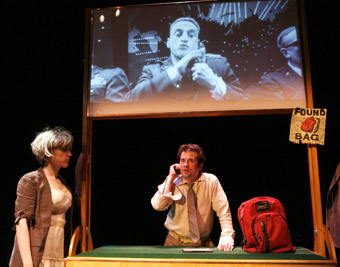
Maggie Hoffman, Steve Cuiffo, Major Bang, SOH
THE SYDNEY OPERA HOUSE’S ADVENTURES O7 IS THE SUCCESSOR TO 2006’S ADVENTURES IN THE DARK, THE BEST OF WHICH INCLUDED THE NETHERLANDS-BASED DANCE COMPANY, EMIO GRECO|PC AND TWO IMPRESSIVE AUSTRALIAN WORKS: NIGEL JAMIESON’S HONOUR BOUND (SOON TO TOUR TO EUROPE) AND BRIAN LIPSON’S A SMALL ATTENDANCE IN THE ANTECHAMBER. THIS YEAR’S ADVENTURES ARE ALL FROM OFF-SHORE AND INCLUDE THE ENTICING FUTURE TENSE AND BIG BANG, WORKS ABOUT CURRENT ANXIETIES AND PROBABLE HORRORS.
An eclectic Adentures 07 comprises “visiting international festival highlights.” It commenced with Cloudgate’s Wild Cursive in May and concludes at the end of the year with Peter Brook’s rendition of Athol Fugard’s gripping Apartheid-era drama, Sizwe Banzi is Dead, with actors from Mali and the Congo. In C-90, British stand-up comic Daniel Kitson is Henry, an archive worker who discovers new dimensions to life from a musicassette. A dance double bill, Future Tense, from Canadian choreographer Andre Gringas (CYP17, about future freaks) and France’s Pierre Rigal (Erection, tracing our evolution into techno beings), pairs dancers with projections.
Major Bang: or How I Learned to Stop Worrying and Love the Dirty Bomb, is the show RealTime readers will be eagerly anticipating. New York’s Foundry Theatre looks back to the future through, among others, the eyes and ears of Dr Strangelove and Lenny Bruce (riffing “upon the surreal semantics of the words, ‘war on terror’“). Written by Kirk Lynn, directed by Paul Lazar and performed by actor-magician and Wooster Group artistic associate Steve Cuiffo and Radiohole co-founder Maggie Hoffman, the work was described by the New York Times as “surely the happiest show to have been inspired by the horrors of 9/11.” RT
Foundry Theatre, Major Bang, Adventures 07; Playhouse, Sydney Opera House, July 17-29, www.sydneyoperahouse.com
RealTime issue #79 June-July 2007 pg. 35
© RealTime ; for permission to reproduce apply to realtime@realtimearts.net
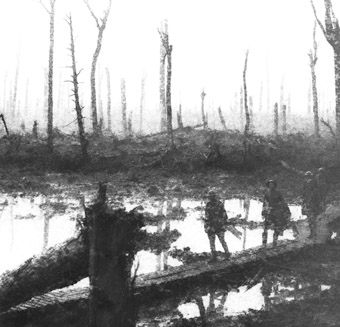
Chris Marker, Owls At Noon Prelude: The Hollow Men
CHRIS MARKER IS ONE OF THOSE ARTISTS OF SNIPPET AND RUMOUR RATHER THAN EXPERIENCE. FOR YEARS I HEARD OF THIS INTRIGUING MOVIE, LA JETE (1962). IT WAS GREAT, INNOVATIVE, THE INSPIRATION FOR GILLIAM’S TWELVE MONKEYS. EVENTUALLY I SAW IT VIA A CRAPPY, SCRATCHED AND WARBLING VIDEO COPY. INTRIGUING THROUGH THE INDESCRIBABLE SOUNDTRACK, A PRISTINE VERSION IS A BONUS OFFERING WITH THE MAIN SHOW AT THE IMA—OWLS AT NOON PRELUDE: THE HOLLOW MEN.
Originally commissioned for the re-opening of New York’s Museum of Modern Art in 2004, Owls At Noon begins Chris Marker’s attempt at a larger “subjective journey through the 20th century”—not a bad project to start up for a man past 80. Owls at Noon grows out of Eliot’s The Hollow Men. The installation/media object/video is “a reflection upon that poem, mixed with some images gathered from the limboes [sic] of my memory”, following the poem from start to finish—a straight line. However, Marker resists reproduction or illustration. In response to an interview request from Mikkel Aaland, Marker replied, “no interviews. Instead, if you must write something use your imagination. Place us on a boat on the Nile, We are drunk, It’s your story.” Similarly Marker is no flunkey to the source, taking Eliot’s poem and reworking it into partial quotes, fragmentary paraphrase and comment.
The installation of Owls At Noon at the IMA is minimal and pretty much as it was for the MoMA show—white gallery wall, 8 flat panel monitors in a long thin row. There’s a bench just comfy enough away to take in all monitors at once. That’s all that’s in the room. It’s on a loop—a reasonable curatorial convenience I guess—but it has a definite beginning and end that is worth following. Sound fills the space—Corona by Takemitsu, with Roger Woodward on piano. The soundtrack is inspired. Rumbling, sparse, building in complexity throughout to finally end simply at a recapitulation of the beginning. People come and go through the other gallery rooms but not enough to interrupt.
First image is words floating in on the left hand screen—there might be eight screens but really it’s a diptych of screens quadrupled up, so it’s left right left right left right left right across the wall. First words point to Eliot, “remember ‘the hollow men’.” Shiny automatons appear from the darkness, skin eaten, circuits exposed. Is this what it is to be hollow? The machine without a ghost. Other faces appear, dead and human, carved back into patches of black and white. Gridded up documents of atrocity. Bodies arranged in rows; you do your best but it’s hard to get them neat.
As far as I can tell the images are all from World War 1, the war to end all wars, “which we found untrue scarcely 80 seasons later”—another fragment oft repeated. There is strangeness in the idea that one war would end all others. A message from another time of proud, religious colonisers thinking their suffering was just as supernaturally effective as the suffering and sacrifice their Christian faith had them dream of. For Marker the war happened a few years before his birth, and was still fresh in memory and artefact into his time as a boy. Owls At Noon acts as a meditation on his memories of the effect of that war, and extends into an exploration of WW1 as a cultural generator, a supplier of metaphor and image to scaffold our interpretive schema. I think of a graph of war density over time, statistical distributions of violent death.
The video is always black and white, fragments of words, fragments of people. A dead man in a dead tree, a face looking down, no children, no animals. There’s a team photo of convalescents, staggered rows, rugs on knees. Accusations and fury, straight to the camera. But mostly, faces look out—the piece is filled with gazes—without engagement. Trauma creates a type of specialised human—hippocampal spines shrink, thoughts dwell over and over on the the same old thing—inputs are reduced, reorganised, outputs are stereotyped, old memories are the only memories. These are the humans Marker has look out at us: total interiority, no contact with their own surface, the skin makes a boundary that neither side can read, neither side can cross. He obsesses on their eyes, “how often did we meet in dreams those eyes that Eliot dared not meet.” A phrase contrasting ‘blind’ with ‘sightless’ recurs. The eyes of Marker’s memories are sightless, waiting to look out on another world.
Yet more faces, a fibrous kiss shattered into granular decay. Faces scraped and burnt back into the soil. Ambiguous boundaries between people and dirt, people and wood, people and bodies. World War I has always been the muddy war, the war without colour. Marker has commented elsewhere on colour as sex, for billions of years an ancient device of seduction. “When I began to play with B&W film clips…I just wanted it to be a light, unpretentious way to celebrate in my manner one hundred years of cinematography…But to put it more simply, wasn’t it fun to free oneself from a three-billion-year-long addiction?” Scarcely fun, Owls at Noon Prelude is paced slow, hypnotic, always in motion. Images fade in and out, side to side, up and down. Words move across the screen, close up, partial. There is no colour here, yet there is seduction in Marker’s evocation of memory’s obscured scrutiny.
Chris Marker, Owls At Noon Prelude: The Hollow Men, visuals Marker, score Toru Takemitsu (Corona, 1962), piano Roger Woodward; Institute of Modern Art, Brisbane, April 10-May 26
RealTime issue #79 June-July 2007 pg.
© Greg Hooper; for permission to reproduce apply to realtime@realtimearts.net
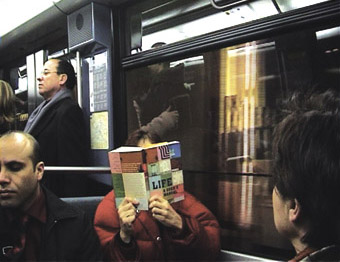
Norie Neumark, Maria Miranda, Searching for Rue Simon-Crubellier
MARIA MIRANDA AND NORIE NEUMARK’S SEARCHING FOR RUE SIMON-CRUBELLIER IS AN INTRIGUING CONCEPTUAL-PERFORMANCE-MULTIMEDIA WORK BASED AROUND THE QUESTION: “IS IT POSSIBLE TO BRING SOMETHING THAT DOES NOT EXIST INTO EXISTENCE BY SEARCHING FOR IT?” IT’S A PHILOSOPHICAL INQUIRY THE ARTISTS WERE INSPIRED TO PURSUE AFTER READING GEORGES PEREC’S BOOK LIFE: A USER’S MANUAL WHICH IS SET IN A PARISIAN BUILDING AT NUMBER 11 RUE SIMON-CRUBELLIER. PEREC WAS A FOUNDING MEMBER OF THE OULIPO MOVEMENT, FRENCH WRITERS WHO IN THE 1960S INTENTIONALLY ENFORCED CONSTRAINTS ON THEIR WRITING, USING DEVICES SUCH AS GAMES, PUZZLES AND WORDPLAY TO CREATE NEW EXPERIMENTAL FORMS OF LITERATURE.
I have to admit that knowing little of Perec, I wasn’t quite sure at first what to make of the collection of objects installed in the reading room at Artspace. Inside was a small couch, a monitor showing a video, a large map of Paris marked with little red pins and lots of A4 print-outs of Google web-pages stuck to the walls. The room’s two bookshelves were lined with rows of black photo albums, filled with more print-outs from the net, as well as several boxes marked “bad directions”, “dead ends” and “false starts”, all filled with little bits of paper.
By far the most engaging part of this work was the video. Watching it, I understood the significance of the other elements and became inspired to search out even more information myself on the internet. In the video the artists play with the idea of being Australian tourists in Paris and record themselves performing the typical ‘touristy’ act of asking for directions. This banal exercise is warped to the point of absurdity however, because as viewers we know that the street the artists are looking for most likely doesn’t actually exist (although others do in Perec’s book), and because this usually trivial interaction is being taken so seriously.
It is hard for me to pinpoint exactly why the video is so good. Is it the wonderful scenes of Paris and its varied inhabitants? Is it the farcical nature of the search or simply the demeanour of the artists themselves? I’m not really sure, but I loved watching Neumark in her big headphones and bright red anorak earnestly asking people in French the way to the imaginary street. I was immediately transfixed by this bizarre treasure hunt and reminded of the fun you can have allowing yourself to be completely swept up in a game and playing it out to its ultimate conclusion.
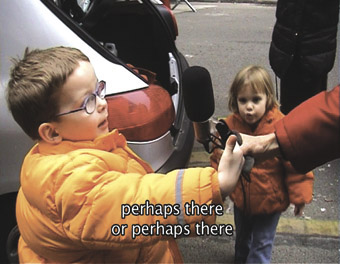
Norie Neumark, Maria Miranda, Searching for Rue Simon-Crubellier
On the one hand the video sticks very closely to a classic ‘vox pop’ documentary format. Associates of Perec are interviewed, people on the street are randomly stopped and asked questions, followed by visits to several, official locations in search of more reliable sources of information. Many of the interactions with French bureaucracy are very funny and typically mired by red tape and the number of overalapping agencies responsible for street names. On a deeper level though, the video plays with the idea of documenting and of performance, in the sense that the act of documenting is the performance, and the subject of the documentary only emerges through this performative act.
In a suitably twisted, Oulipo-inspired way Miranda and Neumark state they are performing “an actual search for an imaginary place” and by genuinely performing this search and documenting it on video, but particularly on the internet, they are in fact creating more material or evidence that future (re)searchers will eventually find. Through their performative and documentary actions they are literally bringing this imaginary place into existence.
Norie Neumark, Maria Miranda, Searching for Rue Simon-Crubellier, Artspace, March 16-April 14
RealTime issue #79 June-July 2007 pg. 27
© Anna Davis; for permission to reproduce apply to realtime@realtimearts.net
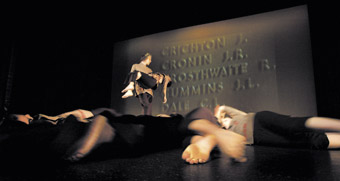
Quantum Leap, Reckless Valour
photo Andrew Campbell
Quantum Leap, Reckless Valour
WHATEVER THEIR EMERGENCY, WARS THE WORLD OVER CONSUME THE VULNERABILITY OF THE YOUNG—HARNESSING THEIR SUSCEPTIBILITY, MARSHALLING THEIR SUGGESTIBILITY, EXHAUSTING THEIR SHEER ENTHUSIASM FOR PARTICIPATING IN WORLD EVENTS. SUCH YOUTHFUL ENERGIES, RENDERED AESTHETIC, ARE ALSO APPARENT WHEN LARGE GROUPS OF YOUNG PEOPLE EMBODY THE WILL OF EMPOWERED ADULTS AND PERFORM WITH UNBOUND ENTHUSIASM FOR APPRECIATIVE FAMILY AND FRIENDS.
This ensemble aesthetic of unassailable pride fuels events like the Schools Spectacular, that apotheosis of the end-of-year concert, staged annually since 1984 with a cast of thousands in the cavernous arena of the Sydney Entertainment Centre, and now broadcast to the nation on ABC TV. Such an aesthetic—suitably cloaked in the drab garb of mutual respect—was also apparent in Reckless Valour, Quantum Leap’s homage to the Australian War Memorial and the nation’s war dead.
Quantum Leap Youth Choreographic Ensemble is an ongoing enterprise of the Australian Choreographic Centre in Canberra. This production from 2005 was made in partnership with the Australian War Memorial and with support from the Department of Veterans’ Affairs through the ‘Saluting their Service’ commemorations program. A revival was presented at the Adelaide Festival Theatre as part of Come Out 2007, South Australia’s biennial arts festival for young people.
Reckless Valour is a well-polished work of propaganda, wearing its production values with pride like so many medals on its chest. Producer Mark Gordon has enlisted a professional production team of 27 artists, administrators and technicians including four choreographers, five composers and a six member film unit. Thirty six young dancers appear in the work, most on stage, some on film.
The dancers—all of whom have come to social consciousness as future citizens in Howard’s Australia—may have contributed ideas, movement strands and stories to the creative process, as artistic director Ruth Osborne notes in the program, but their bodies articulate a discourse on remembering war, national honour and dutiful reflection which does not appear to originate with them. This discourse they perform with the docile conviction of devoted children, but without the authority that arises from creative autonomy.
Modern dance has lent itself to national promotion in the past. Rudolph Laban’s movement choirs, created for the spectacles of mass rallies in Nazi Germany, is an obvious example. Laban’s choral kinaesthetic is recalled in Reckless Valour—in Jodie Farrugia’s segment, Pool of Reflection, in Fiona Malone’s Roll of Honour and, most obviously, in the monumental body-architecture of awe and admiration in Ruth Osborne and Vivienne Rogis’s Hall of Memory.
Dissenting bodies make a brief appearance in Faces of the Enemy, Rowan Marchingo’s deconstruction of Australiana. Marchingo reveals the violence of the heel-and-toe in colonial bush dance, but sardonic references to Vegemite, Drizabones and kangaroos miss their target, overshadowed by the iconography of the unknown soldier, the war-time nurse, the Flanders poppy and the slouch hat which so dominates this work.
Midnight Oil’s Short Memory is used at one point in association with an audio recording of Howard’s announcement to the nation on joining America in the war against Iraq. But the problem here is not that we are short on memory. The work is awash with manufactured memories, drowning us and its performers in a flood of memorialisation. In a time of war and water shortage, when the civic fountains in our towns and cities are running dry, the pool of reflection in the nation’s capital overflows.
In the final segment, “a memorial for the future”, key words project the values of its young performers. Among the words are tolerance, respect, understanding, courage, faith, strength, trust and cautiousness—cautiousness? I am chilled by this.
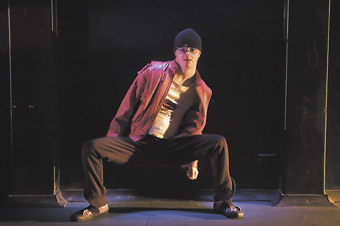
Lorcan Hopper, Restless Dance, Rebel Rebel
photo David Wilson
Lorcan Hopper, Restless Dance, Rebel Rebel
I am thrilled that Rebel Rebel, the new work from Adelaide-based Restless Dance, throws caution to the wind. Presented for Come Out at Norwood’s Odeon Theatre, this is Ingrid Voorendt’s first production as artistic director, though her experience as associate director and creator of five works for the company lends assurance. She describes Rebel Rebel as a rebellion against her previous work.
It has an urban, constructivist, junk yard aesthetic. It is built up from fragments of childhood culture, gruff snatches of music from DJ TRIP, and the frustrations of young bodies bursting out of their skins. It opens with the confusion of torchlight, a wind-up toy in a corner, a Bambi mural on the wall—while twelve young performers are locked up out the back, making a racket, yelling to get out.
As the work unfolds, a booth-sized box, squares of white light and the solid bulk of the theatre’s back wall give structure to a choreography of frustration as bodies perform actions that exceed their containment. Performers are chased, pathways are blocked. Bodies lash out to do their own thing. They try to escape, and get in each other’s way.
Restless Dance works with young performers both with and without a disability. One advantage of this—an advantage as rare in dance as it is in youth arts—is the resistance that the performers and their bodies present to uniform projections of corporeal capacity and the singular imposition of a director’s will.
We see this most clearly when the performers line up downstage as if for a chorus line, that most recognisable choreographic convention for synchronising uniformity. But as the impulse to move runs down the line, each performer responds in a manner as distinctive and unusual as it is authentic to the body moving. Near the end, the performers don headphones and the DJ retires. They dance to their own beat as we watch on in silence.
The sense that these twelve performers are the originators, the initiators, the creative generators of their movement is impressive. Voorendt meets the challenge of directing young people in the performing arts: how to chart an ensemble trajectory of aesthetic education that fosters authenticity of artistic expression. In the choreography of Rebel Rebel, I saw dancers becoming artists for the future. In Reckless Valour, I saw conscripts servicing their elders and the past.
Quantum Leap Youth Choreographic Ensemble, Reckless Valour, Festival Theatre, Adelaide Festival Centre, May 1-12; Restless Dance Company, Rebel Rebel, Odeon Theatre, Adelaide, May 11-19; Come Out 2007
RealTime issue #79 June-July 2007 pg. 29
© Jonathan Bollen; for permission to reproduce apply to realtime@realtimearts.net
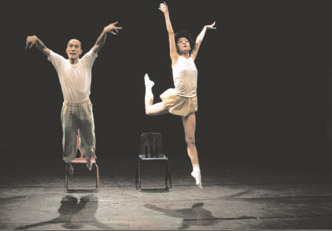
Jareo Osamu, Terada Misako, It Might be Sunny Tomorrow
photo Sete Tele
Jareo Osamu, Terada Misako, It Might be Sunny Tomorrow
AUTOMORPH, A DUET BETWEEN DANCER EMMA STRAPPS AND SOUND ARTIST DEAN LINGUEY WAS FIRST UP IN THE TRIO OF DUETS COMPRISING DYUETTO AT DANCEHOUSE IN MARCH. STRAPPS’ DANCE AESTHETIC SUGGESTS A BUTOH-STYLE OF WORKING. HER MANNER OF MOVEMENT IS VERY CONNECTED TO HER INDIVIDUAL CORPOREALITY, WHICH SHE CLEARLY DRAWS ON TO GENERATE A SINGLE, SUSTAINED PERFORMANCE QUALITY. THIS IS WORK THAT HAS BEEN CREATED FROM THE INSIDE, FROM FEELING RATHER THAN LOOK. THE MOVEMENT ITSELF WAS VERY JOINTED, OPERATING AT THE MEETING-POINT OF BONE AND BONE, EXTENDING TO THE LIMITS OF HER PHYSICAL RANGE. THE EXTREMITIES OF THE LIMB WORK—PARTICULARLY WHERE THE ARM MEETS THE SHOULDER OR THE LEG ENTERS THE HIP SOCKET—CREATED A RATHER NON-HUMAN ENSEMBLE, INSECT-LIKE AND REMINISCENT OF SUE-ELLEN KOHLER AND SANDRA PERRIN’S MEMORABLE BUG (1992).
Strapps created this movement state through a series of inhuman shapes, extending then collapsing them along a slow diagonal. At some point, she reconfigured her costume into a dress in which it was odd to see her moving, almost jarring. I’m not sure how or whether this transition into human form was reflected at the level of movement. After this point, there was a journey across space with an ending in the spotlight. Personally, I would have been happy to stay with the non-human part of the work, to go deeper into its nuances rather than be taken towards a resolution which evaded me. A good deal of investigation underlies Automorph. It will be interesting to see where it goes next.
My initial experience of N_TN_GLD was saturated by the power of its music. Zipper Sky artfully created a repetitive sound, like a car engine which never actually starts. Its effect was to create a series of anticipations: that the sound would progress, that the engine would actually start, alongside a succession of ‘disappointments.’ Against that background, Perth dancers, Sete Tele and Rachel Ogle, each in turn fronted the audience. Tele stood quite close, repeatedly digging into his torso, extracting invisible innards. Ogle’s work was more dancerly, working a kind of emotional communication. N_TN_GLD then became more mobile, more active, in the faster style of contemporary dance, engaging the two in spirals, rolls, twists and turns in and out of the floor. There was for me a slight ‘disconnect’ between the initial offbeat character of the work and its subsequent shift towards what felt like a familiar mode of dancing, a pattern and legacy of choreographic style which is already given. While Ogle in particular looked quite comfortable dancing in this style, I think the intention was to create something more out of the ordinary.
Jareo Osamu and Terada Misako’s It Might be Sunny Tomorrow was the most entertaining piece of the evening. Aside from the humour of the work, these two dancers had a wonderful sense of mutual and differential timing. This was achieved not via duplication or action and response but through an intriguing and subtle sensitivity. The relationship was enacted rather than expressed. They rarely looked at each other, performing mostly task-oriented actions without excessive adornment. Some abstract repetition occurred, for example, a slow leg split by Misako over and around Osamu’s back, but by and large It Might be Sunny Tomorrow evoked a sense of everyday life, of ordinary humans confronting expectations, not always managing to meet them but, at the same time, not necessarily caring. Osamu and Misako were fellow travelers here, collaborators in parody, sometimes dance partners but, more often than not, moving in a relation of difference. This gave a refreshing slant to the idea of duet, that proximity can be maintained without falling into sameness.
Although these three pieces were all duets, they were very differently realized. The connection is in part achieved because three institutions—Dancehouse (Melbourne), Strut (Perth) and Dance Box (Osaka)—are each taking it in turns to host artists from the other two cities. It’s the first season to be presented under the auspices of Dancehouse’s new artistic director, David Tyndall. Although Tyndall rightly acknowledged the work of former director Dianne Reid and recently retired general manager Michael Mitchener in developing this season, Dyuetto stands at the brink of Tyndall’s new curatorial outlook.
Dyuetto (Duet): Automorph, dancer Emma Strapps, sound Dean Linguey; N_TN_GLD, dancers Sete Tele, Rachel Arianne Ogle, music Zipper Sky; It Might be Sunny Tomorrow, dancers Jareo Osamu, Terada Misako; presented by Dancehouse, STRUT Dance, Perth, Dance Box, Osaka; Dancehouse, Melbourne, March 28-April 1
RealTime issue #79 June-July 2007 pg. 30
© Philipa Rothfield; for permission to reproduce apply to realtime@realtimearts.net
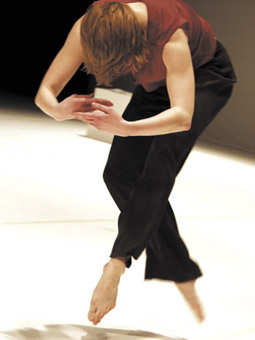
Antje Pfundtner, EigenSinn
photo Iris Terzka
Antje Pfundtner, EigenSinn
EIGENSINN WAS ANTJE PFUNDTNER’S FIRST BIG SUCCESS AND TOURED THROUGHOUT EUROPE AND ASIA. SHE RECALLS A JOURNALIST ASKING HER TO SUMMARISE HER WORK AND HER SINGLE SENTENCE RESPONSE WAS, “WHEN I WAS BORN, I COULDN’T MOVE AT ALL.” PFUNDTNER NOTES IN A CONVERSATION OVER EMAIL, “ THIS SENTENCE SUMS UP MY WORK PERFECTLY. IT HAS AN AUTOBIOGRAHICAL BACKGROUND. IT CONTAINS A STORY, A FAILURE, AND THE WORD ‘MOVE’.” PFUNDTNER PERFORMS THIS SOLO IN JUNE AT SYDNEY OPERA HOUSE’S STUDIO AND MELBOURNE’S ARTS HOUSE.
Pfundtner first visited Australia briefly in 2005, supported by Goethe-Institut Sydney to lead a research project with local artists at Critical Path. Performing excerpts of Eigensinn in an informal workshop setting to illustrate her practice gave rise to the invitation to perform the work in theatres in Melbourne and Sydney.
In our discussion about her return, Pfundtner elaborates on the special place this solo has in her rapidly increasing repertoire. “I made EigenSinn at a time when I was digesting the input I had received as a dancer and artist. I was travelling, working with different people, taking a lot of classes and workshops. The solo form seemed the most suitable way to process all that. EigenSinn is still my most personal work and reflects upon my life…as an artist, a human being, a woman. The main thread is the Brothers Grimm Fairytale, Das Eigensinnige Kind (The Willful Child), in which a girl is punished for developing her will. Nowadays this is the one thing everyone is trying to achieve, especially artists, for whom reflecting upon will and stand-point is crucial. EigenSinn also deals with three other stories from my experience. The first is the most personal, the story of my early inability to move.” (A rare and severe medical condition which Pfundtner overcame as she grew. )
Pfundtner’s work is warmly anticipated by her Australian presenters. Steven Richardson of Arts House writes, “Antje is a fantastically engaging and skilled performer who has a theatrical expressiveness which makes her a compelling, watchable dancer. Importantly, she is unafraid to use dry humour as a part of her performances and I experienced this first hand at her Critical Path residency showing. Hosting international artists is an important part of what Arts House does. International guests are invited into the program partly to provide audiences with an expanded context to the work of local artists, many of whom investigate the themes of self knowledge as Antje does. We are committed to performers who insist on interrogation of practice, culture or thematic concerns…and Antje certainly fits this bill. “
Just as she will give a workshop for professionals in Melbourne in association with Chunky Move and Arts House, Pfundtner will also accompany her Sydney Opera House Studio shows with a second research project at Critical Path. For three days she will work with 14 participants; several of these Sydney based artists were involved in Pfundtner’s original workshop. She writes, “I love it when things continue or leave a trace. With Critical Path I am again presenting my tools for getting to material and choreography in exchange with the participants. The last workshop maintained its own dynamic after I left, which made me very happy. As I heard from the participants, they made a performance night out of that workshop. What more could I ask?”
Since making EigenSinn Pfundnter has created four group works. The first, Selbstinschuld, has the English sub-title “If you can’t fix it—feature it” and is about being trapped in life. She followed this with a quirky piece for the students of her old school. She then created Outlanders with Beijing’s Living Dance Studio, a piece where, “misunderstandings became a form of communication.” Pfundtner’s latest work inDeckung, recently premiered in Germany. Dealing with wishing and wanting, fantasy and absurdity, this piece employs language once more and extends into singing.
Antje Pfundtner hopes that more of her work will be shown in Australia, and if her last voracious engagement with the scene is anything to go by, it seems that she will become a regular visitor.
Antje Pfundtner, EigenSinn, Studio Sydney Opera House, June 14-16, www.sydneyoperahouse.com; Arts House, North Melbourne Town Hall, June 22-24, www.artshouse.com.au
RealTime issue #79 June-July 2007 pg. 30
© Sophie Travers; for permission to reproduce apply to realtime@realtimearts.net
<img src="http://www.realtime.org.au/wp-content/uploads/art/12/1222_bailey_ot.jpg" alt="Katherine Tonkin, Philip McInnes, Luke Ryan,
OT: Chronicles of The Old Testament”>
Katherine Tonkin, Philip McInnes, Luke Ryan,
OT: Chronicles of The Old Testament
photo Jeff Busby
Katherine Tonkin, Philip McInnes, Luke Ryan,
OT: Chronicles of The Old Testament
THERE ARE, BROADLY SPEAKING, TWO SCHOOLS OF THOUGHT WHEN IT COMES TO THE READING OF SACRED TEXTS. THE FIRST IS A LITERALIST OR FUNDAMENTALIST APPROACH, WHICH TREATS A WORK AS A VEHICLE FOR THE TRANSMISSION OF A STABLE SET OF TRUTHS. THE SECOND, THE MODERNIST SCHOOL, EMPHASISES THE ROLE OF INTERPRETATION AS A DYNAMIC, FLUID AFFAIR, IN WHICH EVEN SCRIPTURE IS SEEN TO WORK ON THE LEVEL OF METAPHOR OR ALLEGORY, AND THE ROLE OF THE READER IS TO ARTICULATE MEANINGS TO THE GIVEN WORDS AND IMAGERY.
Two recent productions in Melbourne put these approaches into fascinating and provocative contrast. One took a religious text which forms the foundational myths for several thousand years of history and opened it up to interrogation, teasing it apart in order to question the assumptions that underlie its received wisdom. The other engaged a canonical text in the history of modern theatre but did so with a secular reverence to the transcendent, timeless psychological truths it found therein. Religion, it turns out, doesn’t hold a patent on the sacred.
uncle semolina’s OT
At Malthouse, Uncle Semolina (& Friends) presented OT: Chronicles of the Old Testament, a chaotic, hyper-kinetic rendering of a vast collection of stories drawn from the first half of the Good Book. It re-orders and revises its source material, attentive to the dramatic power of these tales—and they’re nothing if not spectacular—while maintaining a second level of engagement which allows its audience to assess the contradictions and problematic assumptions which underscore them.
Unlike the New Testament, the older tales are those of an ambivalent and at times terrible deity whose relationship with humanity is hardly as the loving father figure later scribes attempted to posit. This is a god who creates, but as often destroys. In OT, Yahweh is the central figure of interest but is presented as much in the form of what literary critics would term a structuring absence. Senile, slumbering, confused and eventually entirely absent, his omnipresence is refigured as a lack—he may be everywhere, but he is equally nowhere.
The work begins with the cardigan-clad, balding Yahweh sleeping on a chair as four performers race through various Testament stories. Their renditions are overtly, perhaps excessively performative, reaching deep into a grab-bag of theatrical tricks and styles, from Commedia-style farce and clowning to mime, video projection and puppetry. The Uncle Semolina style is strongly defined by this thrift-shop aesthetic in which found objects become props, biblical characters in this case played out by action figures and plush toys. When the performers take on roles themselves it is with an equally irreverent spirit: Samson becomes a “hard cunt”, handy with a shotgun, Job a nervous stand-up comic whose bad jokes gradually reveal the terrible treatment he suffered at the hands of a cruel God.
Early in the piece, there are strong hints that these stories are being played out in order to appease that God, who demands entertainment from his creations. At first, they are trying to keep him awake; later, after he begins to withdraw from the stage, they attempt to bring him back by recalling those moments in which they had pleased him. There’s a level of pathos to this reading, which suggests that the scriptures themselves, and our re-reading of them, are not simple descriptions of holy events but active attempts to recover a deity who has forsaken the world, and even whose crueler moments are preferable to his departure.
But even that God’s awful status is problematised as an issue of interpretation—after he wakes, but well before he assumes any kind of autonomous presence, he himself becomes a puppet to his subjects, who animate his limbs and speech in a grotesquely hilarious routine. Perhaps, finally, this is where OT is at its most impious, in offering the possibility that Yahweh is merely a result, and not the cause, of these stories. An effect of the creative spirit, rather than its inspiration.
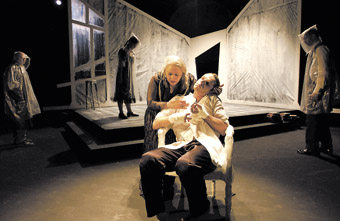
Andrea Swifte, Jay Bowen, Ghosts
photo Deryk McAlpin
Andrea Swifte, Jay Bowen, Ghosts
branch theatre’s ghosts
Branch Theatre Company’s production of Ghosts offers a curious counterpoint. Ibsen’s 1881 play was a shocking number for its day, its themes of incest, religious hypocrisy, sexual degeneracy and suicide a bold challenge to the mores of the period. Moreover, as a work by one of the founding fathers of modernist theatre, it was both a formal and thematic reaction against the comfortable dramas that worked to reassure rather than challenge audiences.
Curious, then, in that this production handles its material with a respectful care that sometimes jars with the more confronting aspects of the work. Certainly, the design of the piece is wonderfully non-naturalistic, a construction of stark, receding lines that form an almost expressionist series of slashes across the playing space. This set, along with the costumes, are all rendered in shades of grey, black and white with the occasional intrusion of striking reds. The ambience created is of a cold other-world, the ideal setting for a family drama revolving around a deceased patriarch whose monstrous legacy grips those he has left behind.
But beyond these elements, Ghosts is a devout and mostly realist attempt to access and purvey the profound interior truths of its characters. Certainly, it is a wonderfully realised and performed production of which Ibsen might well be proud, but its strangeness lies in precisely that fact. If Ibsen, like many of his successors, attempted to find new ways of expressing a psychological realism, these truths no longer appear so fresh a century or so later. Rather, Ghosts’ power is as a kind of riveting drama quite distant from the experiences of its contemporary viewer. It could be updated to add relevance, but I think that would be beside the point. But our very distance from the context of its first production could at least be acknowledged.
What unites both of these mostly successful works is, in the end, a humanist underpinning which seeks to speak directly to a common experience—in one case, by critically questioning the accepted interpretations of a canonical text, in the other by attempting to reaffirm them. That humanism, perhaps, is the ghost that most stubbornly haunts our theatre today.
Uncle Semolina (& Friends), OT: Chronicles of the Old Testament, devised and directed by Christian Leavesley and Phil Rolfe, performers Amelia Best, Philip McInnes, Luke Ryan, Peter Snow, Katherine Tonkin, lighting Paul Jackson, Malthouse Theatre, Melbourne, May 4-27; Henrik Ibsen, Ghosts, director Melanie Beddie, performers Jay Bowen, Ming-Zhu Hii, Bruce Myles, Andrea Swifte, James Wardlaw, design Emily Barrie, lighting Richard Vabre, Branch Theatre Company; Theatreworks, Melbourne, May 4-20
RealTime issue #79 June-July 2007 pg. 31
© John Bailey; for permission to reproduce apply to realtime@realtimearts.net
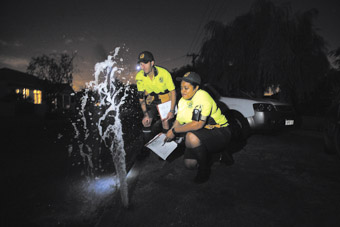
PVI, Inform
photo Bodan Warchomij
PVI, Inform
PERTH-BASED ARTS COLLECTIVE PVI HAVE JUST MOVED INTO A FORMER SCHOOL TO ESTABLISH THE CENTRE FOR INTERDISCIPLINARY ARTS (CIA). BETWEEN ORGANISING THE LAUNCH OF THIS NEW ARTIST-SUPPORT INSTITUTION, ARTISTIC DIRECTORS KELLI MCCLUSKEY AND STEVE BULL ARE PREPARING PVI’S LATEST PERFORMANCE PROJECT, INFORM. IT’S PLANNED TO BE AN UNSETTLING ROAD TRIP INTO THE SUBURBS OF PERTH TO CHART THE DISSIPATION OF A SENSE OF COMMUNITY AND THE ALIENATING SUSPICION WHICH HAS SPREAD OUTWARD FROM THE METROPOLITAN CENTRES OF GOVERNMENT.
Spectators for Inform will assemble at the Perth Institute for Contemporary Art before following the so-called Loyal Citizens Unit (LCU) as they drive into the suburban hinterland in search of minor criminals and social infractions to identify and halt. “I love this idea of a convoy of 15 cars driving into the suburbs”, Bull enthuses, “and the pressure of not losing the car in front of you.” Audiences travel in their own vehicles and tune in to the LCUs’ radio broadcast to listen to a soundscape by Jason Sweeney. Meanwhile live dialogue is picked up by radio microphone while the LCUs doorknock members of the public and ask for their help in catching offenders.
PVI are committed to directly engaging the audience in the events they manage. As McClusky explains, they are currently working on strategies that deal with questions such as “what can you do in your car? How can you assist what we’re doing—and how can we be inclusive?” Although Bull notes this will include some classic options such as “flashing the headlights, honking the horn—once for yes, twice for no!”, they are nevertheless keen to move beyond such simple relations.
Inform is a sequel to PVI’s 2006 show, Reform, which had the LCUs taking audiences on a walking tour of one of Perth’s busier urban areas, between nightclubs and restaurants, engaging both real members of the public and performers masquerading as bystanders, to issue infraction notices for everything from jaywalking to standing still while being dressed provocatively and carrying a condom in one’s purse (which can be legally inferred to be soliciting). Reform was an interesting work, but slightly naff in its execution, while Inform is likely to have a more sinister and ambiguous, eerie ambience, depending as it does on the audience’s sense of both engagement (being part of the convoy and hearing the speech of the LCUs) and distancing (the car turned into a kind of cinema space or radio play venue where spectators observe and listen to actions from behind a glass window).
As McClusky explains, audience “visual awareness will be restricted. A lot of the doorknocking they will be able to hear, but they won’t be able to see. It’s a very different treatment. So we started work with sound artist Jason Sweeney earlier for this piece. We want to give a lot more breathing space to the sounds this time around. It felt like the sound acted as an accompaniment to the dialogue in Reform, whereas this time that may flip at times and the sound will dominate.” Inform thus relies more strongly on the ambivalent pleasures of voyeurism and surveillance than the earlier spectatorial model, in which audiences generally maintained clear sightlines on the activities of the LCUs and had little beyond the streetscape itself to divide their attention.
Another interesting development in the progression from Reform to Inform is that whereas the LCUs in the former work predominantly came across with a sinister, invasive, paralegal or police-like association, in Inform one’s sympathies are more likely to be conflicted over the merit of the LCUs’ actions. In the suburbs, the LCUs will be on the lookout for such commonplace annoyances as “dog fouling, illegal parking, water cheats, and so on.” Especially with respect to responsible water usage, these are issues which increasingly galvanise householders with both left and right-wing sensibilities, determining to what extent such actions should be tolerated within the community. It will be hard not to empathise with someone finally punishing that bastard from two doors down responsible for dog shit on your verge every morning. Unlike the urban policing of Reform—the very title of the show suggesting an exterior, repressive force acting upon a recalcitrant subject—in this new scenario, one enters a suburban world where individuals are increasingly happy to self-regulate and prosecute.
Bull extrapolates: “We’re very interested in how communities are now policing themselves and with the mechanisms which are put in place to do that. There is a culture of dobbing now in Australia. The issues have overtaken mateship. Although it hasn’t quite hit here in Perth, with things like water wasting over east in Sydney, Brisbane or Melbourne, if someone misuses water, they’re going to be reported. Even if they’re not guilty and they have a tank in the back garden!” McClusky adds, “You hear reports of people having to put up signs saying they’re not wasting water so as to avoid prosecution.”
It is precisely this constellation of issues which lies at the heart of Inform—and indeed the PVI project as a whole. McClusky notes that the company is “tapping into those little niggly things in human behaviour that would drive you to respond a certain way. In the research we did for Reform, we came across all of these dob-in phenomena. There’s an organisation called Whistleblowers Australia. With the tests that we’ve done for Inform, the people in their homes are extremely welcoming. They invite you in and make you a cup of tea—and then proceed to slag off their neighbour!” The issue then is when does the vigilance of one’s neighbour become a sign of social dysfunction, and when is it a badge of responsible community behaviour? In 21st century Australia, we need, more and more, to determine whether we have become paralysed and hateful at the prospect of threats to us and our homes, or have finally found a way to generate a caring, cohesive community. Where better to highlight this issue than in a city all but defined by the car and the suburb?
PVI, Inform, Perth suburbs (departing PICA), June 20-30, www.pvicollective.com, www.ciastudios.com.au
RealTime issue #79 June-July 2007 pg. 32
© Jonathan Marshall; for permission to reproduce apply to realtime@realtimearts.net
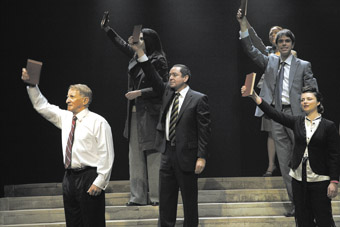
members of the STC Actors Company, The Art of War
photo Tania Kelley
members of the STC Actors Company, The Art of War
IN A NEWLY OPENED CREATIONIST MUSEUM IN THE US, RUN BY A FORMER AUSTRALIAN SCIENCE TEACHER, THERE ARE DINOSAURS ON NOAH’S ARK. ELSEWHERE A BABY ANIMATRONIC T-REX SITS DOWN WITH YOUNG CHILDREN BY A DIORAMA WATERFALL—LIKE THE LION WITH THE LAMB. FAITH IS EVERYTHING IN THIS 6,000 YEAR HISTORY OF THE WORLD, AND THAT FAITH IS BASED ON THE WORD. RECEIVED WISDOM EMBODIED IN BOOKS DOMINATES HUMAN CULTURES. ATHEISTS (DAWKINS, HITCHENS ET AL) NOW VIGOROUSLY CHALLENGE NOT ONLY FUNDAMENTALIST RELIGION BUT THE WHOLE SHEBANG, INCLUDING THE KIND THAT PROPELS THE AUSTRALIAN GOVERNMENT TO FUND THE PLACEMENT OF A CHAPLAIN IN EVERY SCHOOL (PERHAPS HE/SHE SHOULD ALSO RAISE THE COMPULSORY FLAG) AND TO TREAT EVERYONE WITHOUT RELIGIOUS FAITH AS MORALLY DEFICIENT.
At Belvoir St Theatre, Company B performs UK playwright Howard Brenton’s Paul, about one of the authors of the New Testament, while at Malthouse Uncle Semolina (& friends) present OT (for Old Testament; see page 31) and the Sydney Theatre Company realises visiting playwright Stephen Jeffrey’s The Art of War, based on the two and half thousand-year-old Sun Tzu classic, used also as a manual for strategies in business and sport.
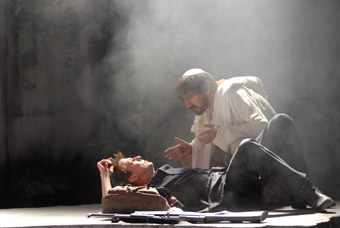
Company B, Paul
paul
In Brenton’s Paul, the proselytising saint (played by Robert Menzies) is depicted as wild-eyed, his head thrust forward, arms waving, movements discombobulated, every word an urgent thrust, a declaration of the man’s ineptness as a rhetorician. He’s an epileptic visionary (falling down often, not just the critical once), temporarily blinded by a vision of Christ that converts him from official persecutor of the new Christian sect to become one of its leaders, travelling the empire, spreading the word, establishing churches. In Brenton’s version of the life, Paul’s struggle is pragmatic, challenging recidivists clinging to Jewish custom (diet, circumcision etc) when he knows that the Christian creed will only spread if it tolerates the everyday habits of gentiles. But there is a greater challenge—Paul’s companions are uncertain of the miracle that has liberated him—is he simply ill; worse, some know that it was no miracle, Christ is alive and in hiding. Brenton opens out the narrow New Testament narrative, incorporating apocrypha like Christ’s marriage to an intelligent and cynical Mary Magdalene, along with references to the popular competing creed of Mithras, the bull god. Paul has to face the fact of a living Christ and not in the sense that he had hoped. But having travelled so far he is consumed by his own belief and passionately convinces his followers to take it up—their faith is a fiction but, as Paul sees it, a necessary one.
Wesley Enoch’s direction of this essay-as-play is straightforward, the performances suitably tough and tense, and the handling of the shifting time structure (offering something in the way of suspenseful propulsion) deftly handled. The war-torn setting, armed soldiers in 21st century garb and the grim prison camp scenes all evoke the Middle-East as it is now, although it’s a broad brush analogy, a conceit that is not really through-produced. What I found profoundly dissatisfying was the play itself. It’s extremely difficult to match the character as written and played with the Paul who so profoundly shaped the emergence of Christianity not simply as fervent missionary but as literary genius—cleverly melding Jewish, Greek and Roman epistolary formulae in the Epistles (“telegraphic sermons” one writer called them) that not only implicated his far-flung readers in the drama of imagined dialogues on morality and belief but mimicked the authority of empire.
This was the man who fused pagan, Christian and Greek philosophies into a workable whole for the Greco-Roman culture of the Roman Empire, who above all synthesised Platonism and a new creed into the Christianity we now know with its opposed worlds of flesh and spirit founded on the inherent imperfection, recast as original sin, of humankind. We see the driven visionary (the day of judgment is always nigh), glimpse the seductive poet and, occasionally, the wit: “You can’t build a religion by piling up foreskins.” Brenton is peculiarly restrained (“god fucked [Mary] in the ear” is a rare exception) although his portrayal of a Nero (Jonathan Hardy) who can see what’s coming (he has to execute Peter and Paul but knows that martyrdom will be the first step towards a new state) has some of the old Brenton bite. Like plays or films with artists as their subject where the art barely gets a look in, this play inclines to one dimension (faith overriding the facts in the wedding of vision and pragmatism), neglecting the man’s art and the range of his ideas. Of course, there’s a limit to what you can expect from a couple of hours of stage time, but it would have been interesting to see more of the dynamic between the man’s passion and his intelligence.
OT: chronicles of the old testament
OT, by Uncle Semolina (& friends), revealed a young Melbourne company in fine ensemble fettle using every lo-grade theatrical device in the book to remind us, as Brenton’s Paul does, that God is an invention of humans pretty much in their own image (here a distant, sleepy cardiganed old guy), but a construct that can get right out of hand. What begins as a series of skit-like re-tellings of Bible tales in no apparent order and desperately short on punchlines improves as we realise we are heading towards the moment of creation rather than away from it, and when the writers entwine stories in order to drive home issues of power, gender and faith with increasing irony, thus rescuing the whole from the sense of an undergrad atheist trip. The darker it gets, the funnier.
the art of war
In The Art of War, Stephen Jeffreys takes a classic Chinese text and applies it to the earliest stages of the war in Iraq, to business and personal relationships. While audiences doubtless know enough of their Bible to engage comfortably with Paul and OT, Jeffreys is faced with the challenge of filling us in on one-time general Sun Tzu’s epigrammatic thoughts. The cast, therefore, becomes a chorus (invoking another ancient practice) chanting from copies of The Art of War (bound in red and evoking yet another influential Chinese volume) and then, in the first scene, transform into the staff of a company being introduced to Sun Tzu’s wisdom via a motivational speaker. The book thus becomes a framework for and the subject of the drama. Throughout, the chorus in part or whole comments on the action, be it a business venture into modern China, heterosexual friction (complicated by various moral issues) or war (the inept handling of the invasion of Iraq: “There is no instance of a country having benefited from prolonged warfare”, writes Sun Tzu). In the case of General Garrett (Colin Moody) and journalist Crystal (Pamela Rabe), the most fully realised of the three couples, waging and reporting the same war and managing a mid-life romance crystallise the play’s alarming ethical complexities.
But as drama, there’s a plodding insistency to the choral device that, once established, is wearying along with a certain obviousness to the Iraq war material, and too many of Jeffreys’ characters are bland—although the members of the Actors Company all adroitly compensate. There are two notable exceptions in the writing. First there’s Jessica, finely realised by Amber MacMahon revealing the tunnel-vision intelligence of a woman seduced by the Sun Tzu ethic and its teacher, whom she stalks. Her disappointment that the Sun Tzu ethic cannot be lived as a totality turns her pyromaniac—in a magical moment the chorus open their books and they burst into flame. The other idiosyncratic character is Brian—Peter Carroll as an older businessman usurped by a new generation of reckless pragmatists. Apparently slow witted (Carroll’s restrained delivery is masterful) he wreaks vengeance with glee, having deftly deployed the deception recommended by Sun Tzu. It’s a moral victory, even if criminal. Once again the strength of the STC Actors Company is fully evident, doing more than justice to Jeffreys’ script with vocal and physical verve and an ensemble ease of playing.
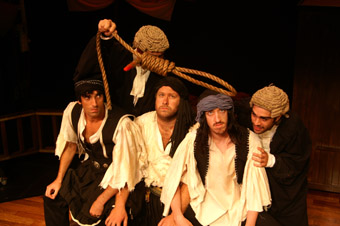
Sidetrack, Seven Pirates
seven pirates
Sidetrack’s Seven Pirates is a great antidote to the Pirates of the Caribbean movies, offering facts, politics and an Australian connection, as well as fun, in the telling of the story of some none too murderous Greek pirates in 1827 who seize the British merchant-brig Alceste with its load of tin plate. All of this is complicated by occurring in the middle of the war between Greece and the Ottoman Empire with Britain looking to assert its authority in the region and coming down strongly on pirates. Here was an opportunity to set an example by hanging the seven young Greek offenders (who claimed they were seizing cargo destined for Ottoman Alexandria).
Writer-director Don Mamouney frames the tale as a courtroom drama with action-packed reconstructions (boardings, sword fights, stunts, singing and belly dancing) set against epic video sea and sky-scapes and with much suspense (first hanging looms, then life sentences, then transportation to Botany Bay in 1829). Above all, writer and performers excel in their hilarious handling of varieties of English (including Maltese, Sicilian, French and Spanish) in the courtoom, climaxing in the meeting between a fantasist George III (who commutes the sentences) and the pirates’ dedicated Maltese defense lawyer. Adam Hatzimanolis as the pirate captain, Manolis, brings gruff humour and authority to his role (the character warrants more room in the first act to anchor the play) and all of the performers display great versatility, not least in their rapid role-changing. Seven Pirates is a joyful piece of historicising giving life to an incident and people we know little or nothing of—the word here has opened up awareness, not foreclosed it with legal, moral or tactical strictures.
Company B, Paul, writer Howard Brenton, director Wesley Enoch, performers Robert Menzies, Paula Arundell, Ewen Leslie, Jonathan Hardy, James Evans, Graham Rouse, Hazen Shammas, Jason Klarwein, Steve le Marquand; Belvoir St Theatre, Sydney, opened May 2; Uncle Semolina (& Friends), OT: Chronicles of the Old Testament, Malthouse, Melbourne (see page 31); Sydney Theatre Company, The Art of War, writer Stephen Jeffreys, director Annabel Arden, performers STC Actors Company, set Robert Cousins, costumes Tess Schofield, lighting Damien Cooper, sound Max Lyandvert; STC, Wharf 1, Sydney, opened May 19; Sidetrack, Seven Pirates, writer, director Don Mamouney, performers Adam Hatzimanolis, Alex Blias, Ben Adam, Ben Wood, Chris Pickard, Jason Stojanovski, Russell Smith, video Assad Abdi, lighting Jocelyn Speight, costumes Sue Liolio; Riverside Theatre, Parramatta, April 11-22
RealTime issue #79 June-July 2007 pg. 33
© Keith Gallasch; for permission to reproduce apply to realtime@realtimearts.net
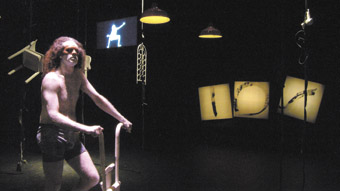
Zane Saunders, Being a Medium
photo Nicholas Mills
Zane Saunders, Being a Medium
ZANE SAUNDERS’ WORK SPRINGS FROM A SUBSTANTIAL VISUAL ARTS PRACTICE EMBEDDED IN FAR NORTH QUEENSLAND. HIS LATEST WORK, BEING A MEDIUM, IS PART OF AN ONGOING COLLABORATION WITH SOUND ARTIST FILE_ERROR (AKA NICHOLAS MILLS) ENGAGING WITH CULTURAL, SPIRITUAL AND SOCIAL CONCERNS WITH AN UNDERLAY OF RITUAL AND HUMOUR. BEING A MEDIUM SITS IN THE SPACE BETWEEN INSTALLATION AND PERFORMANCE, ENTERTAINMENT AND OBSERVATION, BODY AND OBJECT.
More accustomed to the white box gallery, this is Saunders’ first foray into the world of the theatrical black box. Spurred on by his flirtation with sonic interplay, the collaboration with File_Error has produced a lineage of short works. This latest piece was developed at the JUTE Theatre Centre of Contemporary Art in Cairns as a full-length work.
Enter a dark space. Saunders is clothed. He peels off, hanging up his shirt and trousers on a tall hat rack to reveal a completely painted form. He’s a commanding presence, painted white with a stripe of brown over his eyes, hair long and flowing. His towering form crouches till he’s eye-level with his audience. He weaves a ritualised procession from one installation to the next, his body bobbing, swaying and creeping to its unique tempo.
File_Error’s mix of sonic textures is rhythmic yet unsettling. Erks, squeaks and groans drive Saunders on. And then there is silence, his own and from sound departed. This crafted intermittence allows time for the viewer to reflect.
Illumination of a series of white installations sees Saunders interact and move through a collection of thoughts and feelings, amplified by carefully chosen objects but whose assembly appears random. A mangrove of black bungy cords suspends twenty four white man-made objects in varying degrees of repair: a couple of guitars, a miniature rubber figurine, a distinctive collection of chairs…The sense is of Saunders revealing an examined world full of objects familiar to him, and yet to the viewer, unknowable.
The residue of previous performance works informs Being a Medium. Three monitors of varying size emit sound and video. The largest projects white noise, or is it the internal workings of Saunders’ mind? The other two display edited documentation: one shows the performer’s back hovering over a spiral brick installation with a text message, “unlearn”; and in the other he’s wearing a suit jacket, lampshade head-wear and holding a light bulb, with the text “it was all too easy… consume.” The glitchy, looping messages suggest a certain urgency.
It’s a chairless environment. The audience—some unfamiliar with this kind of work—dance around the installations. Children scurry to position themselves, they want to be close to the action, but recoil when illuminated.
Saunders recycles pre-loved items and trash from the tip as dynamic craft. He is the medium in the moment, creating animated imagery through media integration. On two large canvases opposite each other are duplicate projections of Saunders warping, looping, shifting, re-focusing time. Three more canvases on the wall are treated with a flow of black paint from a dustpan brush. It’s immediate. Saunders glides by a speaker stack with its arhythmically throbbing neon light and punchy sound and it becomes a miniature urban sprawl. He tenderly massages plants in a cot, connecting with the natural environment.
I have been aware of Zane Saunders’ interest in performance for over a decade, and in the last few years I have observed his practice unfold into new territory. His interventions are evolving a kinetic momentum, which extends the object and installation. We witness a dance on an ageing treadmill, Saunders moving like a cross-country skier, his striding rise and fall implying an endless journey or walkabout.
His body is part of a living, breathing culture, not found in the museum of objects. Within the cultural protocol politic that Indigenous artists face, Zane Saunders is finding a language for the space between the contemporary and tradition through a deeply personal spiritual and physical journey. This is no mean feat considering prohibitive costs and the fledgling presence of performance and media practice in the region. Put that together with the lack of Indigenous live art role models and you have the enigmatic space between called Zane Saunders.
Image: Zane Saunders, Being a Medium, photo Nicholas Mills
Being a Medium, Zane Saunders, File_Error (aka Nicholas Mills), JUTE Theatre Centre of Contemporary Art, Cairns March 30, 31
RealTime issue #79 June-July 2007 pg. 34
© Rebecca Youdell; for permission to reproduce apply to realtime@realtimearts.net
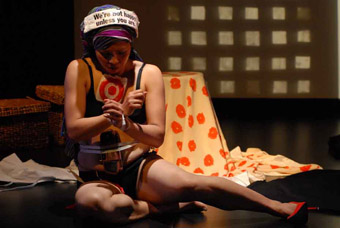
Valerie Berry, The Folding Wife
photo Heidrun Löhr
Valerie Berry, The Folding Wife
A DARK HAIRED WOMAN STANDS ON THE POLISHED FLOORBOARDS IN THE CENTRE OF THE NEW BLACKTOWN ARTS CENTRE PERFORMANCE SPACE. MUSIC PLAYS—NOSTALGIC MUSIC OF A FORMER TIME. THE WOMAN, VALERIE BERRY, UNDRESSES TO HER BLACK UNDERWEAR. TWO MEN APPEAR AND WITH THE FINESSE OF PUPPETEERS, BEGIN A LONG SLOW COSTUME COLLAGE.
They dress, drape and fold yards of fabric and clothing around the woman, morphing one costume into another—a peasant becomes a woman of class becomes a revolutionary becomes a political prisoner about to be executed. A machine gun strapped to a thigh, a radio spewing forth crackly sound is tied around her waist and her feet are forced into red high heels. Shoes, shoes and more shoes. We are in Imelda territory.
Paschal Daantos Berry and Valerie Berry, Australian artists, also siblings, born in the Philippines, first discussed a collaboration based on their shared history in 2002. Teaming up with Anino Shadow Play Collective from the Philippines, director Deborah Pollard and Urban Theatre Projects, they have produced a fine new performance work of biographical fiction called The Folding Wife.
Datu Arellano and Andrew Cruz, members of Anino Shadow Play and the men who have transformed Berry in chapter one, return to their workstation. As Valerie begins chapter two, they squat on the floor by an overhead projector and laptop and throw exquisite imagery onto the back wall. Like painters playing with liquid light, colour and form, they create the visual sensuality and texture of memory so powerfully evoked in the text by writer Paschal.
All I have is the view from this window. I have seen the century through this frame, seen them come and go…Our women have always been here sitting by the shadows waiting for new opportunities. Waiting for wars to finish…We can feign happiness with enough practice; it is in our blood, that’s how you become resilient—by bending and folding into recognisable shapes.
Valerie Berry’s impressively portrayed characters fold into one another through a non-chronological telling of chapters. Chapter two followed by chapter eleven, then by chapter five and so on. We meet Grandmother Clara, Mother Dolores and daughter Grace. We feel the heat and torpor of their lives as regimes and curfews come and go. It is a story of waiting: “…waiting for wars to finish. For our men to come home…” or a school child waiting for hours in the hot sun by the side of the road for a glimpse of Imelda Marcos, who never comes.
More ingenious shoe routines, and flags of different nations that spew forth from Berry’s mouth. Grandmother Clara pines for her Spanish past while urging her daughter Dolores to escape to America. Her advice: “If you have the misfortune to marry one of ours, always be a step ahead. Get to know the queridas (mistresses) and make their life a living hell.”
Dolores meets an Australian saviour instead: Arthur, who brings Dolores and daughter Grace, to a new land. “We are two, stepping off the Greyhound bus, wondering if the dust will ever settle. It is silent here. But if you prick up your ears you can hear blowflies.”
The atmosphere changes but loses none of its power. Dry yellows and sandy browns fill the screen as Grace describes arriving in a cultural desert. And yet in this barren place she blossoms and blooms. Here among the “rough and golden boys licking plates, cheeks varnished from lamb fat and tomato sauce, smelling of lanolin from the wool”, she becomes a woman, declaring, “I will never fold, I will never fold, I will never fold into my self.”
The length of gestation of the work and collaborative care director Deborah Pollard and team (including lighting designer Neil Simpson, production manager Alexander Dick and members of Anino) have given in creative development and production have yielded a delicious fruit. Sweet, sour, bitter—all the tastes of memory are present in this powerful work. The audience is left with sensual impressions of lace and blood, laughter and sorrow, “roasted corn on Sundays, coloured parasols reflecting the white heat of the sun” and a heritage of women, strong, beautiful and dignified, who have survived on memories of a glorious past or a projected future as they bent and folded into themselves a nation’s pain.
–
Urban Theatre Projects & Blacktown Arts Centre, The Folding Wife, performer Valerie Berry, writer Paschal Daantos Berry, director Deborah Pollard, design, multimedia Anino Shadowplay Collective, lighting Neil Simpson; Blacktown Arts Centre, Western Sydney, April 19-28
RealTime issue #79 June-July 2007 pg. 35
© Jan Cornall; for permission to reproduce apply to realtime@realtimearts.net
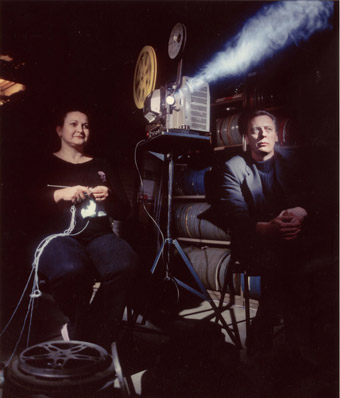
Aspasia and Jaimie Leonarder
photo Garth Boyed
Aspasia and Jaimie Leonarder
SITUATED IN THE BACK STREETS OF INNER-CITY SYDNEY THE MU-MESON ARCHIVE DEFIANTLY COUNTERS THE TREND OF EVER-DECREASING INDEPENDENT CINEMA AND ART SPACES. IN THIS ALTERNATIVE ‘FAMILY’ SPACE JAIMIE AND ASPASIA LEONARDER CURATE AND PRESERVE A RARE CULTURAL ARCHIVE OF FILM AND VIDEO THAT MAINSTREAM SCREEN CULTURE HAS REJECTED.
We are sitting in the loungeroom that is also part of the archive. In front of us is a 100 metre square screening room where films, videos and equipment are stored. The room contains records, digital media, obscure fanzines and computer/editing equipment. One of the things the Leonarders specialise in is collecting guerrilla mail documentaries of which they have literally hundreds. I asked why they chose the name Mu-Meson Archive and how many films they’d collected.
AL The archives are named after the band of outsider musicians that Jaimie created in the 80s. As for the number of films, we don’t know exactly how many, as every day we gain something new. In 16mm alone we have well over 1,000 films, shorts and features. We have constructed the Kubla Khan Pleasure Dome of alternative cinema.
BP What binds the archive together?
AL I think a lot of it is ‘outsider’, it falls onto the periphery of culture and that is the stuff that eventually becomes mainstream but we have always championed it before it becomes popular. Quentin Tarantino exploits very well that fringe material in terms of mainstream life. He has taken B-grade pictures, genre films, and now they have become the mainstream.
JL We love the whole idea of people’s alternative notions of consensus reality.
AL Every generation at some point will express interest in their past media memories. For us, of course, it’s the 60s and 70s. For this generation it’s the 80s and 90s.
JL Between 1965 to the late 70s Hollywood was letting things slip, although, after Denis Hopper did Easy Rider, a bevy of films questioning authority took cinema to its cutting edge. Looking back at this period is very inspirational; films need to have depth and meaning. Polanski said that cinema is pointless unless you walk out feeling a strong sense of injustice and that will motivate you to go and do something to rectify that injustice.
BP You love politically incorrect exploitation films, and now we have the PC liberation of Borat.
JL Before Borat there were pioneers of un-PC such as John Waters. He made us look at the most challenging of images and circumstances and we learned to laugh in the face of them—at Divine delivering her own baby, eating the afterbirth and biting the umbilical cord. PC is a cover for conservatism that denies us the ability to see who we really are.
I tried so many times at SBS to convince them to get into the wild side of world cinema, and for example show what the Europeans did with blockbuster American films. From the Italian Jaws to the Turkish Exorcist there is a parallel planet of exploitation cinema waiting to be devoured by the West. Spanish director Jesus Franco is a prolific exploitation director but there is something in each of his films that elevates them to a great piece of art. Pam Grier, for god’s sake, became the queen of blaxploitation female heroines. She was Roger Corman’s secretary until she had to stand in for an actress who didn’t turn up, hence sending her on a new career.
BP Is guerrilla mail documentary also a part of the outsider genre?
AL These are people outside of the mainstream who may only have a camera and a message but nothing is going to stop them getting their story out. These films are mostly mail order, libraries neglect them, institutions won’t screen them. We feel it is our responsibility to acknowledge them. They could be about anything from alternative energies and cures to conspiracies and UFO theories.
JL I have always been fascinated by the mail order documentary, they have as much right to be screened and viewed as anything else. I have tracked these films since the 80s. The late Jim Collier was the first person who spoke about electronic voter fraud in the States and he did a one-man assault documentary on the moon landing being a hoax called Was It a Paper Moon? One of the best examples would be Iraq for Sale: The War Profiteers (screening at the Revelation film festival, page 21) by Robert Greenwald the director of Xanadu. He has liberated cinema distribution by giving his audience the right to screen his film anywhere they deem fit, eg loungerooms and pubs. He funded the documentary by doing a call out on the net for people to send in between $20 and $50. He raised $200,000.
Also worth checking out are Guerrilla News Network and Mad Cow News. The all time classic of this genre is Dylan Avery’s Loose Change on the alleged 9/11 World Towers conspiracy. It’s become the most downloaded film in the history of the internet.
BP What are the politics of the archives?
JL To make people think more about the notion of independence, to be inspired by low budget filmmaking and demystify the idea of cinema as only a tool of the wealthy. I want people to actually think that there is something worthwhile about looking at films that aren’t considered great pieces of art. We want to question mainstream distribution and the limiting of screens and spaces…I would like to see a more robust notion of independent cinema in Australia. I think that’s one good thing that the digital era can do because camera technology is now accessible to everyone.
I think our frustration came from growing up in a town that was so alive with microcosms, of people with home cinemas and performance spaces like the Film Makers Co-op and the Sydney Super 8 Group, the Paris and Valhalla cinemas. After the 80s, with the Bicentenary and finally the Olympics these spaces have disappeared from the city. We don’t want to see pockets of independence vanish. We are trying to keep the idea of repertory cinema alive.
BP Your work seems to be very much about community.
AL Everything we do is about community. I have a knitting group. We have our cult cinema screenings, the Sounds of Seduction. We eventually get to know the people who attend our events and hopefully they begin to feel like they belong. It’s almost like creating a village in the middle of a very large city.
BP You have some great cultural artefacts here.
AL We always open our archives to discarded formats and antiquated technology. Eventually someone, a student or low budget filmmaker, will ask us where they can find an old projector or Super 8 camera and nine times out of ten we will have it and can help them out.
JL We also had three Scopitone juke boxes. Scopitones are fascinating in terms of their film history. They are 16mm juke boxes made around 1957 with 36 music clips in them shot around the world. They started in France but eventually went right around the globe ending up in America. No one has got a complete history that we know of. The clips were only made to be played on that particular juke box. It was really the birth of three-minute music clips. One of our favourites is Web of Love by B-grade starlet Joy Lancing. It is a pure piece of exotica. She is suspended in a spider web with Scopitone dancers parading beneath her in the skimpiest tiger skin bikinis, all in lurid colour. The words of the song are literally visualised and at some stage she ends up in a big pot in the jungle with a witch doctor stirring the brew.
AL One Scopitone was donated to the Sydney Powerhouse Museum and the other to ACMI in Melbourne, with 36 clips in each. They are the most remarkable film clips you could ever imagine.
BP Where do you want to go from here?
JL Nowhere, we will stay here and just keep doing what we have always done. There is so much pleasure in introducing an audience to material they had no idea existed. And we are still discovering obscure and exciting things every day.
AL Our Monday night screenings are a bit like church, it’s weekly, we get to know our congregation and at the end of the night we try to acknowledge everyone that is there, hoping that they are positively affected by the experience.
JL Our only hope for the future is that our archives can become fully catalogued and therefore become a more effective library for those willing to look at the fringes.
Jaimie and Aspasia (aka Jay Katz and Miss Death) host a weekly radio show, The Naked City on Sydney radio station, fbi 94.5 fm. www.mumeson.org
RealTime issue #79 June-July 2007 pg. 26
© Bob Percival; for permission to reproduce apply to realtime@realtimearts.net
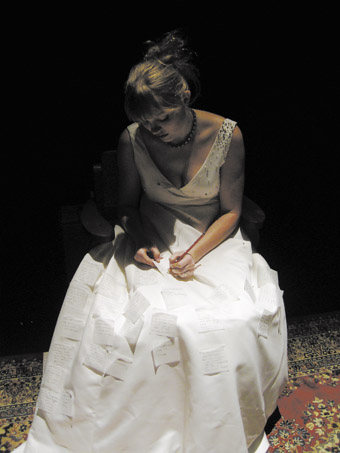
Rebecca Cunningham, Chambers
photo Rachel Cobcroft
Rebecca Cunningham, Chambers
CHAMBERS IS THE THIRD IN A SERIES OF EXPERIMENTAL HAPPENINGS ORGANISED BY THE ADVENTUROUS BRISBANE BASED CURATOR/ARTIST REBECCA CUNNINGHAM, EACH OF WHICH HAs SET CONTEMPORARY PERFORMANCE AND SONIC ART AGAINST AND WITHIN CAREFULLY DESIGNED CONSTRUCTS OF INTERVENTION, CHANCE, MULTIPLICITY, IMPROVISATION AND INTERACTION.
Musicircus in 2004 (RT 65, p43) emanated from Cunningham’s deep fascination with the music and philosophy of John Cage. Flux-US in 2006 similarly paid homage to avant-garde tradition, this time extending the scope further beyond sound into intermedia performance. Both shows hinged on often problematic processes of re-enactment, an especially difficult proposition when it comes to highly contextualised radical work. The results can be confusing and amusing; for instance, the classic piano chainsawing act in Flux-US was in reality a fairly tame gesture, but still garnered some requisite notoriety via an unintentionally hilarious piece of sensationalist tabloid moralising in Brisbane’s Courier Mail.
Chambers is Cunningham’s first event to shed the cover of historical precedent and focus exclusively on new work. It’s also the most controlled and exploratory event, structurally and spatially. In six discrete chambers, partitioned by heavy black curtains, six works take place simultaneously, with the audience free to circulate and interact in any manner. The only element formally common to all the works is the set of headphones required to enter each chamber’s distinct sound world.
Chamber 1: Alicia Jones
We enter a dimly lit backstage dressing room. Assorted costumes are hung on a theatre rack. An actress studies herself in a mirror, tries on this and that, and paces the space in dissatisfaction. The transient audience voyeuristically observes the self-consciously awkward nature of these physical transformations. Later I return to the scene: chaotically chopped hair tufts, a circle of bones, a sense of something magical occurring. I have no idea what has happened in the interim.
Chamber 2: Rebecca Cunningham
A video projection of blurred lights, a cityscape gushing smoke, flickering or shivering. This is a disaster scene, familiar enough to anyone who consumes such dystopian news images on a daily basis. Which city is this—could it be any city? This is a chamber without a performer. Empty. The detached, distant, almost anti-social atmosphere is both unsettling and somewhat of a relief.
Chamber 3: Jan Baker-Finch
An intensely focused hobo dancer is dressed in black garbage bags. Chalk-rendered memories or fantasies (in fact, three brief extracts from Samuel Beckett’s Worstward Ho) are scrawled along the floor. A grid of rabbit-shaped plastic moulds forms a wall. We hear the sound of the garbage bags swishing and rubbing, a melancholy sound that intensifies the schizophrenic intrigue of the scene. Inside the headphones, entrancing hypnotic piano pieces (compositions by Philip Glass) begin to generate a total perceptual transformation. In a place of unknowable dysfunction we clearly recognise a synchronous dance to the rhythm of death, loss and perhaps most pervasively, hope.
Chamber 4: Robin Fox
The silent flickering green lasers of classic science fiction. Without sound the eyes are free to absorb even more movement and scope within the impossibly complex and inventive shower of light beams transforming the space. Fox demonstrates the control he has over this stimulating process, creating morphing pulsating concentric circles of light which wrap around the bodies of those who enter, enclosing them in a translucent glowing capsule. Inside the headphones sound and image are re-united, the overarching synaesthetic structure of the contraption revealed.
Chamber 5: Richelle Spence
A pseudo-religious ritual of scrolls, candles, and symbolic costume, presided over incongruously by a power-suited woman, who occasionally breaks into a morose lament for something lost or absent. This spectacle sits uneasily between the private and public: are we voyeurs or participants? Headphones play the tweeting birds of the summer countryside. Later I return to find the performer with fingers spread, a prosthetic glove set alight at the tips. I read a scroll: “something we were withholding made us weak, until we realised it was ourselves.”
Chamber 6: Rebecca Cunningham
A room divided by displaced rolls of heavy grass on one side and scattered rocks on the other. A woman sits silently in a wedding dress; she inhabits this space as an object, but the space also feels constructed out of her ‘memories’—real or imagined? ‘Family history’ snapshots are pinned to a board made of wine corks. Snippets of incidental conversation and ‘forgotten’ pop music play inside the headphones. This ‘memory room’ is perpetually strung between poles, suspended in a unique tension. Social/isolated. Childhood/adulthood. Silent/sonic. Memory/artifact.
Chambers, curator Rebecca Cunningham; Judith Wright Centre of Contemporary Arts, Brisbane, March 5
RealTime issue #79 June-July 2007 pg. 36
© Joel Stern; for permission to reproduce apply to realtime@realtimearts.net
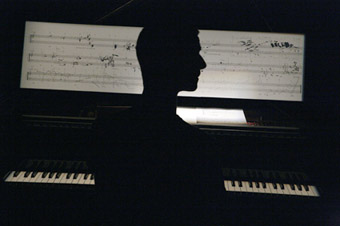
Mark Knoop, Val Camonica
photo Yatzek
Mark Knoop, Val Camonica
COMPOSER DAVID YOUNG HAS A PENCHANT FOR CREATING MULTIMEDIA WORKS INSPIRED BY INTERESTING LOCATIONS. SCALE WAS INSPIRED BY A DISUSED PUBLIC SWIMMING POOL IN BRUSSELS AND THOUSANDS OF BUNDLED STRAW BY A BUDDHIST MONASTERY IN JAPAN.
Aphids’ new work concerns Val Camonica, a valley in the northern Italian Alps, where thousands of rock carvings dating from 3,000 to 8,000 years ago record the life of the Camunni people—their hunting, tools, houses, rituals and lifestyles. The reinterpretation of the cultural history and imagery of Val Camonica through a suite of music, text and video is an ambitious project artistically, one which itself forms part of the cultural lineage that the site has generated.
The first of the seven Val Camonica Pieces, Incisioni Rupestri, is for solo piano. Opening with brief, quizzical motifs alternating with long pauses, the colour and intensity build, punctuated with percussive taps on the piano lid and the strumming of piano strings. Mark Knoop’s rendition is scintillating, and while the work might be understood as a programmatic reference to the initial archaeological recognition of the Camonica inscriptions, the writing and the pianism make for delightful music.
The second piece, Inventario, for strings, winds, brass and percussion, extends some of these ideas. The opening bass drum roll heralds a stop-start progression of motifs, each based around various instrumental combinations, suggesting categories of visual form. In the absence of melodic or rhythmic structure, the coherence of the work emerges from Knoop’s precise conducting, through which the inventory unfolds and which also suggests the march of pictorial and cultural categorisation. The Libra Ensemble’s fine playing articulates these musical ideas and Louise Curham’s grainy black and white footage of forest scenes hints at an alternative, cinematic archaeology.
Stile I, II and III, for guitar and cello, is quiet and introspective, dwelling conversationally on particular musical figures. By contrast, the next piece, Roccia, for violin, piano, clarinet and percussion, is energetic and dramatic, personifying the rocky landscape itself. Throughout the Val Camonica Pieces, strings are sometimes bowed so as to make scraping sounds, perhaps suggesting the chiselling of rock. When used with brass, basses and percussion, the scraping creates a gritty earthiness that evokes the harshness of early alpine civilization. In the fifth piece, Sarcophagus, for string octet, it is as if human figures are engaging in ritual exchanges.
Throughout the suite, Young makes frequent use of portamento—slurred or sliding notes and glissandi that might span one or two semitones and sometimes several tones. The effect is to suggest motion, as if the human and animal figures in the rock carvings are coming to life. In the strings, the frequent use of sliding notes together with rapid shifts between bowing and pizzicato, abrupt changes of metre, sudden accents and shifting dynamics create the consonants, vowels, syllables and even the flow of speech, and the listener gains the impression that Young has painstakingly decrypted and translated every detail of the site into note-by-note musical ideas, as if creating new words and phrases from a novel alphabet. This is especially so in the final piece, Animali, an extended violin solo, where Young adds double-stopping and sometimes requires the performer to hold one note while sliding another, creating an eerie multiple voicing.
However, while commencing with conventional notation, a score will typically conclude with graphic elements including transcriptions of the rock carvings. The final passages of the Roccia score comprise silhouettes of animals, requiring the musicians to respond directly to the Camonica imagery. The concluding piece, Animali, is accompanied by a projected image of the score scrolling across the screen, so viewers can see how notation segues into graphic material inscribed on the stave and can thus appreciate how different kinds of abstract markings might be interpreted. Animali draws together the musical ideas of the earlier pieces into an original and eloquent musicality. Violinist Yasutaka Hemmi’s realisation of this piece is breathtaking, and Animali is a significant musical achievement for both composer and performer.
Accompanied by video imagery from the site, the penultimate piece, Val Camonica: an Excavation, is a text written and read by Cynthia Troup that discusses the archaeological mapping of the site and the interpretation of its imagery, and reflects on the “continuity and consistency of human existence” it reveals. In considering how a public, visual record such as Val Camonica identifies and informs cultural evolution, Young and Troup reconsider the theoretical basis and cultural impact of archaeology itself.
Val Camonica Pieces: Aphids in association with the Libra Ensemble, composition David Young, film Louise Curham, text Cynthia Troup; Full Tilt, Arts Centre, Melbourne, May 10-11
RealTime issue #79 June-July 2007 pg. 38
© Chris Reid; for permission to reproduce apply to realtime@realtimearts.net
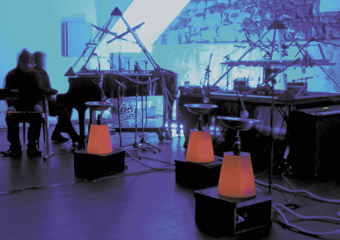
Jay Eusden, James Hullick, Cranky Robotics
photo Matt Murphy and James Hullick
Jay Eusden, James Hullick, Cranky Robotics
THERE ARE STRANGE NOISES EMANATING FROM THE STONE WALLED BASEMENT THEATRE OF THE FOOTSCRAY COMMUNITY ARTS CENTRE, PRODUCED BY AN ENIGMATIC ORDER SEATED IN HIGH-BACKED THRONES, GARBED IN HOODED BLACK JERSEY AND WIELDING MYSTIC POWERS OVER PRETERNATURAL CONTRAPTIONS. ENTER THE REALM OF JAMES HULLICK AND THE AMPLIFIED ELEPHANTS.
The Amplified Elephants have grown out of sound art classes run by Hullick for the ArtLife program which provides opportunities for people with perceived disabilities to experience a variety of artistic practices. Along with the Elephants, Hullick has invited instrument engineer Richie Allen and percussionist Eugene Ughetti to help bring the Cranky Robots to life.
The sound welcoming us into the space is a low machinic drone, like an insistent generator, shifting subtly through tones. Hullick and Liz Hofbauer approach the hitherto unattended mixing desk and start to tune the noise, releasing it to run wild, then catching and taming it, a tug-of-war between human and feedback revealing hypnotic drifting microtonal layers.
Hard on the heels of the sculpted onslaught, Enza Practico enters the space with wind chimes—the simplicity of action and sound working as an aural palate cleanser preparing us for the subtlety of Hullick, Ughetti and Jay Eusden’s study for microphones. Using feedback and effects, whistling, tapping and rubbing, the artists explore texture, surface and the tactility of the microphone, re-inventing it as a responsive poetic instrument, rather than a blunt tool.
These early pieces serve well as preludes to the Cranky Robots, defining an exploratory space where the behaviour of instruments is under serious scrutiny. The next piece, Secret Joy in the Wish Fulfilment of Love uses Whirling Dervishes—instruments made from a spinning metal bowl with a marble inside, activated by an adapted power drill mechanism. The sustained metallic resonance provides the bed for percussive exploration led by Ughetti. The piece, while subject to chance elements—like the marble flying out of the bowl and across the floor—is tightly structured, with Hullick conducting the action, teasing out pleasing layers from metallic drones and vibrations.
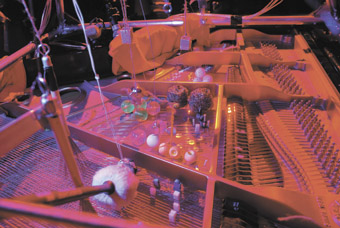
Cranky Robotics, prepared piano
photo Matt Murphy and James Hullick
Cranky Robotics, prepared piano
Particularly intriguing is the Pranky-Ano. Designed to annoy the ‘prima donna’ piano, this pyramidal structure is placed over the strings of the piano with a series of percussive objects strung from levers. Activated from a midi-keyboard, the levers—reminiscent of a giant old typewriter—lift and drop objects onto the strings. At the same time Hullick plays the piano creating delicate gamelan tones, rudely interrupted by percussive agitations. Together the artists and machines become the ultimate prepared piano, a kind of Cagean-cyborg.
The Pranky-Ano developed from the Crank-A-Maphone which, strung like a monster mobile with wind-chimes, wooden boxes, bowls and other resonant junk, has a percussive focus. It too is midi-activated for this concert, which allows each of the Amplified Elephants to play a section in the final work. The piece is tightly structured around sections of Cranka-A-Maphone semi-random cacophony, and the quieter explorations of Ughetti on percussion, the clarity of sounds creating a kind of acoustic pixelation.
Along with the ingenuity and engineering of the machines, Cranky Robotics was impressive in the attention to structure within each piece, utilising every artist’s ability and expression to its optimum and finding a fine balance between control and chaos. The imperfection and unpredictability of the machines offered challenges but also freedoms within compositional process as did the various abilities of the artists defining an intriguing space for exploration—a space for serious play and gentle provocation in which every action is guided by a genuine desire to engage, express and work together to create a little bit of magic.
Cranky Robotics (Jolt Concert 1), director, sound designer James Hullick, percussionist Eugene Ughetti, instrument engineer Richie Allen, Amplified Elephants June Bentley, Jay Eusden, Liz Hofbauer, Robyn McGrath, Enza Practico, lighting Geordie Barker; Footscray Community Arts Centre, Melbourne, May 6
The Jolt concert series continues June 24 with Ernie Althoff, Robin Fox and James Hullick and July 22 with Hullick, Fox, Philip Samartzis and Myles Mumford; bookings Span Community House 9480 1364
RealTime issue #79 June-July 2007 pg.
<img src="http://www.realtime.org.au/wp-content/uploads/art/12/1235_marshall_totallyhuge.jpg" alt=" Michel van der Aa introducing one of his pieces
performed by the WASO New Music Ensemble, Sonic Sights Concert”>
Michel van der Aa introducing one of his pieces
performed by the WASO New Music Ensemble, Sonic Sights Concert
photo Peter Illari
Michel van der Aa introducing one of his pieces
performed by the WASO New Music Ensemble, Sonic Sights Concert
TURA NEW MUSIC DIRECTOR TOS MAHONEY QUIPPED THAT IT SHOULD BE RENAMED THE RIDICULOUSLY LONG NEW MUSIC FESTIVAL. CERTAINLY THE 2007 TOTALLY HUGE NEW MUSIC FESTIVAL WAS BIG—AND VARIED, WITH WORKS BY ESTABLISHED COMPOSERS LIKE ANDREW FORD, AS WELL AS ABSTRACT BASSY TEXTURES FROM LAPTOP SUPREMO ROBIN FOX. SAMPLING THESE EVENTS WAS LIABLE TO GIVE ONE THE BENDS, AS ONE MOVED FROM EXTRAORDINARY, HARD INSTRUMENTALISM BY THE LIKES OF DUO STUMP-LINSHALM, TO FORD’S PASTORAL PIECE INSPIRED BY BRUEGHEL.
For lovers of the weird, the tough, the bizarre or the sonically abstract, the festival occasionally seemed conventional. The Song Company’s selection of works by John Cage was titled Cage Uncaged, but in minimalising the chance elements within these compositions, the company effectively classicised the composer—Cage locked behind formalistic (if musically attractive) bars. Nevertheless, diverse programming produced dizzying heights and surprises in a selection that had something for everyone.
Austrian clarinet duo Petra Stump and Heinz-Peter Linshalm was one such highlight. Seeing the work of the Libra Ensemble in Melbourne shortly afterwards, I was struck by the similar stylistic positioning of the groups in repertoire and approach, both emphasising what I call ‘limit modernism’ in their formal rigour, atonalism and rejection of American minimalism. Often one is left with a series of disconnected, spiky gestures, as well as tiny, timbrel motifs, squeals and small, isolated clusters, that reveal the best of both the conventional use of instruments as well as startling extended technique. Long sections of loud circular breathing punctuated Stump-Linshalm’s playing, while a particular joy was composer Vinko Globokar’s solo for bass clarinet without mouthpiece—a dazzling array of clatters, growls, tubular gasping sounds and tongued stutters, made all the more extraordinary by computer processing and reverb; almost a clarinet version of Kurt Schwitters’ famous concrete poetry work, The Ur-Sonata.
Generally this program was dense and busy, a collection of virtuoso moments and exchanges which, as in Beat Furrer’s piece, created an almost soundscape-like set of textures and a near phasing of elements, while the fracturing and fragmentation of each enunciation was rigorously maintained and counterpointed. From Magnus Lindberg’s overtly performative work (which opened with the ka-whomp of the bass drum before the duo chased each other around the space, mouthing phrases and finally taking up their clarinets) to Claudio Ambrosini’s (vaguely jazzy inflections crushed or held at bay, like a Gershwin piece that never coalesced into true rhythm), this was an invigorating concert which suggested how much noise and texture is still to be discovered within the clarinet.
As part of the festival conference on Sound and Image, Stump-Linshalm offered Christoph Herndler’s fabulous black and white film Streifund, der Blick (Gliding, a Glance) to which the duo played a see-sawing set of off-key tones and gaps with electronics, accompanied by close-up footage of a hand endlessly, painfully and lovingly rubbing every surface of an old, abandoned house—cobwebs, dust and paint falling from the fingers.
Bruce Mowson’s installation Melting Moments was another satisfying surprise. Two screens each showed three shapes nestled within each other (three rectangles on one screen, and two circles in a rectangle on the other) cycling through fluorescent blocks of colour, while a series of sustained tones, mostly in the upper bass register and mids, suffused the space, complemented by hissy sonic materials which built up and receded. Visually, this was Op-Art rendered as mobile, video candyfloss. Mowson explained in his presentation at the conference that Melting Moments aimed at a disconnect between sound and image. Although both the sonics and the visuals gradually evolved and changed, both were random and did not trigger each other. Audiences were invited to construct whatever relationship they wished between these arbitrarily conjoined materials. The very superficiality of the sound and image relationship created an unbounded space for affect, pleasure and interpretation.
WAAPA’s Cat Hope reminded us how early experimentation in ultra-low frequency film scores occurred in cheesy disaster movies like Earthquake. Darren Jorgensen described the scrambled sampling found on Nurse With Wound’s Sylvie and Babs as Surrealist—one can listen to and interpret it forever precisely because it has no structure. I attempted to enunciate a new rhetorical strategy for discussing sound art, not in the usual terms of immersion, depth or an infinite series of layers, but rather as what Siegfried Kracauer called the “mass ornament”—a machinic structure which fundamentally refers back to its own superficial elements, rather than generating Romantic depth.
Robin Fox offered a brief history of combined sound and image instruments, including 19th century organs attached to racks of bottles of different coloured water illuminated by candlelight. He then charted how he is exploring the ever more precise synchronisation of sound and image by linking his laptop bass textures to a single-point laser, projected through smoke as a series of violently cut-off changes in shape and form. Fox’s live performance literally shook the building and riddled it with green, pinprick shafts.
Conference keynote presenter, the Dutch composer Michel Van der Aa (RT 78, p41) showed recordings of his work, while live performances were offered by WAAPA’s Resonator new music ensemble and the WA Symphony Orchestra. Dramaturgically, Van der Aa’s compositions tend to represent the individual, or his or her instrumental representative, in a conflicted dialogue with technology, replayed recordings of these performers in the works, or with computer processing of the live materials. In Auburn for example, the dulcet tones and hispanic lilt of the solo classical guitar became alienated, assaulted and lost as they were embedded within an increasingly pressing, electronic wasteland of textures and clicks.
Van der Aa’s film works (as in Passage, his portrait of an isolated old man, or One, his work for a soprano and her audiovisual double) consistently use the fracturing of tempi, voice or instrumental line to depict madness and neurosis. His work is, in this sense, modernist in ambience, and is thus most effective when furthest removed from such relatively familiar readings and scenarios, focusing rather on relations within the ensemble itself. Quadrivial for example offered such rich sound worlds as the frenetic up/down repetition which recurs in much of the composer’s work, but here placed amidst small, angular, dissonant scenes which (the performers deliberately enacting a number of false starts) grew into longer sequences and then a series of unison clashes and attacks. Also interesting is the way this use of live recording and playback could be read as suggesting that the orchestra itself is a kind of massive, dysfunctional music box.
In the Here trilogy, this lumbering symphonic machine was carried from hissy, clunky analogue accompaniment to glitchy, slippery digital sounds, the electroacoustic elements recapitulating their own formal history. Against this, the orchestra repeated and reworked grabs of material, breaking them and sharing them amongst clusters of instruments, before the whole thing collapsed and emptied out, ending with the players frozen, bows raised, waiting for that last note that will never come. Beyond the commonplace tragedy implied here, there were many arrested sounds and motifs that evoked much more than the 1950s cultural world otherwise suggested, making Van der Aa’s admixture of baroque instrumentation and atonality, his clustering and texturing and performative execution highly intriguing.
After these orchestral complications and Stump-Linshalm’s unalloyed formalism, it was a relief to take refuge in Philip Brophy’s kraut-rock road-movie score to the 1960s film Le Révélateur (RT 72, p21). Brophy may not today be doing quite such complex work as his 1999 Cavern of Deep Tones, but his ‘glint’ drum-pad sounds for the Beautiful Cyborg project and the use of Dave Brown’s solid guitar lines for Révélateur provided just the right amount of popular sonic languages within the aesthetic rollercoaster that was Totally Huge 2007.
Totally Huge New Music Festival and Conference, Perth, April 20-May 6, www.tura.com.au/events/totallyhuge
RealTime issue #79 June-July 2007 pg. 40
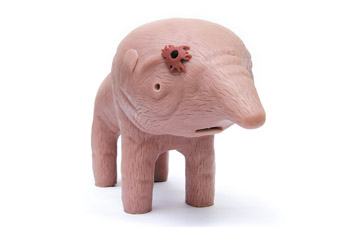
Van Sowerwine’s Small Beasts
STILLS, IN ITS CAPACIOUS CONVERTED WAREHOUSE IN SYDNEY’S PADDINGTON, HAS BEEN A RARE COMMERCIAL SUCCESS IN art PHOTOGRAPHY, FEATURING A STRONG STABLE OF AUSTRALIAN ARTISTS, EXPORTING THEIR WORK AND INTRODUCING OVERSEAS ARTISTS TO AUSTRALIAN AUDIENCES AND BUYERS. I MET WITH OWNER-DIRECTOR KATHY FREEDMAN, CO-DIRECTOR BRONWYN RENNEX AND CURATOR SANDY EDWARDS TO DISCUSS JUST HOW A COMMERCIAL PHOTOGRAPHIC GALLERY HAS ADAPTED TO THE AGE OF PHOTOMEDIA. ALTHOUGH THEY COME FROM DIFFERENT BACKGROUNDS AND HAVE IDIOSYNCRATIC TASTES, THE TRIO EXUDE A COLLECTIVE PASSION FOR THEIR ARTFORM, PICK UP ON EACH OTHER’S THOUGHTS AND PASSIONS, COMPLETING OTHERS’ SENTENCES WITH AN EASY FAMILIARITY. THEY DECLARE THEIR SHARED COMMITMENT TO AN EVOLVING MEDIUM AND TO THE ESTABLISHED ARTISTS THEY REPRESENT AND THE EMERGING ONES THEY SEEK OUT.
The current Stills exhibition features sculptures (small dog scale) made by Van Sowerwine with accompanying photographs of the same creatures in their natural habitat, pockets of lush bush in an urban setting. You approach one on its plinth, sneak a touch of its soft, pink skin and peer into a wound-like hole on its forehead where you glimpse miniature video images of the creature’s thoughts—foliage, other beasts and a slurry of moving brain matter. As usual with Sowerwine this is a grimly comic experience, if certainly less dark than previous works. Van Sowerwine’s creatures may be cute and toy-like but they are also alien presences. In an adjoining space we watch bracing, raw black and white videos on screens large and small by US artist William Lamson of thwarted human endeavour where, for example, a man tries to keep pace with a giant paper dart flying over him on a nighttime landscape. This combination of photographs, sculpture, video and installation is now part of the photographic gallery experience, and although the phenomenon has been in evidence for quite a while, it is currently in a state of acceleration.
adaptation & survival
Kathy Freedman recalls that the move in 1997 from a small terrace house to the former film studio which now houses Stills was motivated by a need for space in which to show large scale (an enormous image by Emil Goh in the opening show), multimedia works (a Merilyn Fairskye video installation in the same show) and series of images (Pat Brassington). But it was only this year that Stills invested in a large video monitor: “We’d managed to get by without owning the equipment until now—it was the artist’s responsibility to chase it up”, says Edwards, to which Freedman adds, “we need to commit if we are seeking out artists working with the moving image and for our existing artists who are starting to.” But there’s a larger issue at stake.
“To survive as a gallery,” explains Freedman, “we needed to attract a lot more collectors of contemporary art, people who see photomedia and photography as embedded in contemporary art. We just don’t have the population in Australia of people who collect straight photography.” This has also meant broadening the kinds of artists Stills represents, “something we anticipated 10 years ago as photomedia began to move to the forefront of contemporary art. But it’s only in the last three years that we’ve been really moving in this expanded area—Merilyn Fairskye had been our main artist working in moving image and installation.”
Edwards comments that Rennex “has had a lot to do with that, tuning into the people doing work of that nature. Kathy and I come out of a slightly different tradition and a majority of our artists continue to work in still images mounted on walls.” To which Rennex adds, “and there’s still a lot to get out of people working that way.”
Freedman thinks the market for moving image is growing: “shows like the Anne Landa Award at the Art Gallery of New South Wales are good for this. We took on Van Sowerwine after seeing Play With Me, shortlisted in the first show. This is the first William Lamson showing in Australia; he’s still reasonably young.”
emergence
Rennex says that in expanding the range of artists and the kind of works Stills engages with, the gallery “has used its first exhibition for the last two years to feature emerging artists—this year Peter Volich with his framed football jerseys with small found photos, Daniel Kotja’s installation and photographs and, the year before, Martine Corompt with her vinyl wall pictures and projection and Van Sowerwine with her crank-handle animation. This first show of the year for me has been about opening the door a little more—still photos are just one part of photomedia now.” Freedman recalls that there was a time “when we felt constrained by the photograph on the wall. Now there’s a problem we’ve been grappling with, our name—Stills. What name could we adopt that would reflect what we’re doing?”
digitally unreal
When I comment on the magic of recent digital photography, its heightened detail, unusual texturing, painterliness and various effects, Edwards makes the observation that “in the past we thought we had a notion of what was real in a photograph, but now the digital realm has created a situation where people come at the image from another angle, asking, Is this a photograph? They no longer believe in the veracity of the photograph.” Freedman adds, “Everything is read as digital now.”
Many photographers now work digitally, but not everyone, says Edwards citing the example of Stephanie Valentin “who uses an electron microscope to put words on pollen grains and then photographs that.” “You think it must be something created digitally”, says Rennex, “but it’s not.” Edwards explains: “The old processes still remain in the mix. Valentin is using a method equivalent to a photogram (when you place an object on the paper), but she’s putting the object in front of a projector and passing light through it. It hits the wall, it’s made large—so she’s inverting the scale—there’s nothing digital, it’s all manual, but mysterious.” Rennex mentions that Christine Cornish “who once would have laboured over a silver gelatin print, produced her last show using pigment prints—but Pat Brassington and Robyn Stacey have been working digitally for a long time as part of their whole process.”
“We have great fun with Pat Brassington’s images”, says Freedman, laughing, “asking, What is that thing, that disgusting thing? Looks obscene. But Pat rarely tells us. If she does, it’s an incredibly prosaic description—a sock filled with something.” Edwards describes Brassington “working with her negatives from the past, whatever’s there, whatever mess is on the negative, scanning them and creating a whole new object in the computer. So it’s about her imagination in relation to the past, which we don’t know about and she doesn’t want us to.”
selecting & selling
The trio agrees that selecting and taking on an artist is very personal. Freedman recalls Rennex putting forward Roger Ballen [RT 75, 52] with his dark humour and strangeness: “I looked at the book and thought I love this work, but I don’t know if it’s going to sell. In fact it has sold to institutions and private collectors—not all of them work from that particular show.” It was the first serious look at Ballen in Australia; for some “he came with a reputation and a number of books”, says Rennex, and for others, says Edwards, “the response was immediate even if they hadn’t heard of him.”
Edwards praises Freedman “for never showing just on grounds of commerciality. You don’t know what’s going to take off. You go on your instinct and interest and love of the work and you wouldn’t want to be showing anything you didn’t like. Success reveals itself over time. Certain artists rise to the top as good sellers, and we’ve got a fair few of these and you depend on that. Then others come in and you grow them and they get picked up or not. There are so many factors…Artists “see us as a lifeline—it’s a very mutual relationship.”
balancing acts
Freedman says running Stills is all about balance—established/emerging, national/international, photography/photomedia—but also “the balance of our personalities.”
I ask the trio to talk a little about their relationship with photography. Kathy Freedman tells me, “My background is in psychology and I worked for many years as a psychologist before taking on the gallery. What I notice in me is gravitation towards quite disturbing works. There certainly needs to be some sort of emotional, not necessarily overt, content that stays in my mind—Brassington and Ballen appeal in particular and Trent Parke’s Minutes to Midnight series, which has been my favourite work of his—a travelogue of Australia but a view of its dark side.”
Sandy Edwards describes herself as “coming from a traditional documentary background and it’s never left me. I still love the image. And also, having been a photographer, learning how to make perfect images, expose and print them correctly, never quite leaves you. I still see the skill in making an image which is an imprint from the world in some way. There’s a huge range of work within that category and I’ve got particular tastes in it, but I still love the image on the wall that tells you about the world we live in.”
Bronwyn Rennex says she “responds mostly to work that suggests ruptures in civilisations or failures—because photography is so often used to sell things and to make things appear perfect. It’s always a relief for me when there’s an idiosyncratic voice that speaks about imperfect things or that escape social structures. Lamson is an example of work about failure—a reminder of what it is to be human. And it’s in my own work, about things that run under the surface. In Always Hungry (2001), the very act of trying to satiate oneself is self-defeating. The more you want the less you have. And for me the shadow self is more honest than the surface self.”
Despite these different perspectives, Rennex says that the trio’s tastes often coincide. “There’s quite a big overlap”, Freedman confirms. There was, for example, unanimity on the forthcoming Magnum 60th Anniversary show which includes Alec Soth (USA). Rennex says “He captures not just Niagara Falls but the mythology, the hopes and dreams laid on that place.” His work reminds Freedman of Wellington-based Anne Noble’s Antarctica (Stills, April-May 2006) which looked on the surface like a straight documentary but “juxtaposed images from Noble’s Antarctic residency with those of museum dioramas representing that polar world.”
photomedia ecology
The trio feel that sharing audiences and market with other galleries is a good thing for Stills and for photography in general. Rennex notes that “the MCA has had a lot of photography shows in recent years and arts magazines have been focusing on it.” Freedman mentions Roslyn Oxley9, exhibiting photography for many years, and the Sherman and Gitte Weiss galleries, and says, “the major institutions have been incredibly supportive of us and our artists.” Edwards sees this spreading connectivity as “a slow growing relationship—we’re in touch with the key curators and there’s a lot of to-ing and fro-ing, discussing things. Australian photography has been enjoying a heyday in the last 15 years in the way that Gail Newton (NGA) was fighting to achieve in the early days. Photography is now up there with any other medium and has realised itself. As a result a lot of artists have chosen to work with photography.”
Freedman comments, “it was a divide, between photographers and artists who work with photography.” Edwards enlarges, “There was a big politic there but it has moved on a bit. For example, a lot of group exhibitions have brought documentary back into the field after it had been excluded for a while and now documentary’s manifesting in very different ways. These photographers have got wise. They’re using large scale images and installation.” “They’ve evolved too, necessarily”, adds Rennex. “To the extent I’m happy about doing the Magnum show. It feels like a real shift”, concludes Freedman.
www.stillsgallery.com.au
RealTime issue #79 June-July 2007 pg. 41
© Keith Gallasch; for permission to reproduce apply to realtime@realtimearts.net
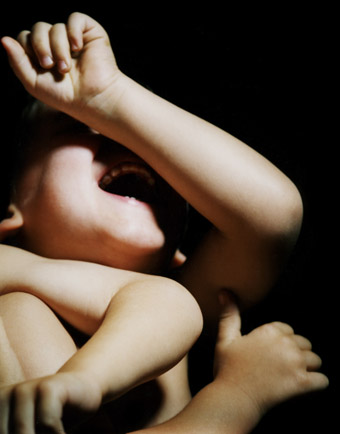
Wiebke Leister, from the series Ticklish Relations (2004-2005)
“[THE JOURNALIST] IS A KIND OF CONFIDENCE MAN, PREYING ON PEOPLE’S VANITY, IGNORANCE OR LONELINESS….” (JANET MALCOLM, THE JOURNALIST AND THE MURDERER). IN THEIR NOTES ON THE ETHICS OF PORTRAITURE, BRITISH PHOTOGRAPHERS ADAM BROOMBERG AND OLIVER CHANARIN SUGGEST WHAT MALCOLM TERMS THE “MORALLY INDEFENSIBLE” PRACTICES OF JOURNALISTS ARE AKIN TO THOSE OF PHOTOGRAPHERS. LIKE MANY ARTISTS IN 1+1=3 COLLABORATION IN RECENT BRITISH PORTRAITURE AT THE AUSTRALIAN CENTRE FOR PHOTOGRAPHY, BROOMBERG AND CHANARIN TAKE THIS ISSUE TO HEART.
Aiming to undercut the touristic nature of photographing the institutionalised, Broomberg and Chanarin hand the camera’s long release cable to their subjects. By giving patients in a Cuban psychiatric hospital the right to determine when their image is captured they reveal starkly different attitudes to the camera. Maria reclines on a cold floor against a wall painted ubiquitous ‘hospital green.’ She’s wearing a shapeless blue gown; her plastic thongs are logo-ed with a leaping big cat, a tiny emblem of freedom. Her expression is poignant and fragile, whereas Mario, an elderly man, turns his back to the camera and young Oreste, in striped pyjamas looks wired and exuberant as he takes his shot. It’s unclear whether this spontaneous method completely overturns the exploitative qualities of photographing the vulnerable, but the resulting portraits highlight the complexities of representing any essential or stable ‘self’, whether the subjects are grappling with this or not.
Anthony Luvera also delegates his photography, giving cameras to the homeless who document a very particular mise en scène. Their rough colour images convey the transience and movement that characterises straitened lives in London—a small, dull room with a single bed, an alley lit by a shaft of meagre light, a graveyard, a covered body on a footpath (asleep or dead?), roadside memorial flowers, the empty cardboard insides of a street ‘home’ and a structure hidden among wildflowers and weeds. These frank and distinctive prints show streets and landmarks as a kind of interior, an exiled space, a home where the human subject is, for the most part, missing.
Wiebke Leister’s tableau of c-type prints, Ticklish Relations (2005-6), provokes us to consider our complicity in watching young children writhe in the tortuous pleasure of being tickled. “Exploring the gap between expression and emotion”, Liebke’s five colour portraits show writhing naked torsos and ambiguous grimaces of pain or delight. The viewer is immediately drawn into this “collaborative triangle” because of the sensual qualities of toddlers’ flesh and their subjection to the tickler’s physical power. We can’t help wondering: who’s getting the most pleasure from this game?
In Groups and Locations, Melanie Manchot’s arresting large-scale colour shots, Russians face the camera with cool, assessing gazes. At Manchot’s iconic Moscow landmarks the ground is eerily clean-swept, so the sites resemble studio lots and the staring crowd evokes the dazed advancing zombies of horror films. In Aeroflot (2004), citizens are arrayed on a Soviet era tarmac around a plane. A vapour trail seams the sky and a decommissioned rocket looms up from the stark white terminal behind. The estranged quality of this street photography suggests the otherworldliness of modern Russia, whose cultural and social life still seems, to the Westerner, shrouded in Cold War mystique.
“I have a sneaking suspicion that all work is really collaborative but one person really takes the credit…,” says Paul Jeff whose DVD, More Beautiful Than God (2004), exposes his collaborators in a drink-fuelled game of self-conscious strip poker to an urgent orchestral score. Jeff concisely sums up the nature of each photographer’s interrogations in the ACP’s sharp and thought-provoking show.
Given the collaborative nature of the ACP exhibition, I imagine its photographers would concur with fellow British artist Craigie Horsfield’s claim, “All art is, in some sense, conversation.” Horsfield’s show Relation, at the Museum of Contemporary Art, covers 35 years of photography, film and sound work. His oeuvre is broad and impressive—from small, oil-painterly still lives of dried and decaying vegetables, flowers and fish to a nine and a half hour meditative colour video, El Hierro Conversation (2002), featuring mist-veiled, dripping pine forests and an artisan hand-making fresh cheese. Yet each work shares a contemplative, atmospheric quality, a compelling moodiness apparent in content and production technique. Preoccupied with “slow time”, Horsfield develops some of his photographs years after they were taken. David Ebony writes, “Alluding to the nearly imperceptible evolutions in everyday life, slow history and slow time lie beneath the surface of culture and contrast with the high-paced changes dominating the surface…” (Slow Time and the Limits of Modernity: Craigie Horsfield and Fredric Jameson, Lacanian Ink 22).
<img src="http://www.realtime.org.au/wp-content/uploads/art/12/1238_juchau_horsfield_install.jpg" alt="Craigie Horsfield, installation, left image – Rynek Glówny, Kraków, March 1977, 1991,
right image – Susan Smith, Ashbridge Road, East London, September 1969, 1994″>
Craigie Horsfield, installation, left image – Rynek Glówny, Kraków, March 1977, 1991,
right image – Susan Smith, Ashbridge Road, East London, September 1969, 1994
photo Jenny Carter
Craigie Horsfield, installation, left image – Rynek Glówny, Kraków, March 1977, 1991,
right image – Susan Smith, Ashbridge Road, East London, September 1969, 1994
Horsfield’s large-scale black and white print, Rynek Glowny, Krakow, was shot in 1977 but not developed till 1991 and shows an old building in the city’s central Grand Square. Its façade is partly obscured with scaffolding and the dark boughs of leafless trees. While the scaffold suggests decay and reconstruction (the square dates from the 13th century), two large portraits on the building conjure up a more human history. These 1930s faces—a dark-haired woman and man—remind me of the ‘found photographs’ from the Holocaust that Christian Boltanski uses in his many installations highlighting the lost, the nameless and the disappeared. Horsfield’s Rynek Glowny suggestively captures all the haunting, layered qualities of those old European towns where reconstructions uncover as much as they repair.
I discover later that the portraits are of Janek Krasicki and Hanka Sawicka, aged 25 and 27 years. They founded the communist League of Young Fighters in 1942 and were subsequently murdered by the Gestapo in Pawiak prison in Warsaw.
In an adjoining room a series of huge gelatin silver prints portraits line the walls. They have a deceptively timeless quality—though calm Isabel Sametier of Barcelona (1996) with her dark, Modigliani eyes looks slightly more contemporary than Bartomeu Mari of Rotterdam (1998) with his 60s, heavy-framed glass-bottle lenses, a slightly startled expression on his half-turned face. It’s this very floating, a-historical quality of human emotion and composure that seems to preoccupy Horsfield.
This quality is also evident in the more obviously contemporary colour series, Broadway-muted stills from a film at Ground Zero, New York in 2001. Shot in dusky light, these close-ups of faces staring, presumably at the scarred remains of the World Trade Center, turn us from the literal traces of the catastrophe to peer instead at its human impact. Horsfield’s use of colour and tone—dense, grainy, muted, framed in darkness—gives his work a stately gravitas. A group of men gaze in different directions, one with his head slightly bowed, another has lowered his camera to stare instead through his glasses. In making the viewer a spectator twice removed, the Broadway series powerfully conveys what the repeated motif of the falling towers cannot: the emotional aftermath, the struggle to comprehend. And yet, the voyeur in us also can’t help pondering, what exactly are they looking at?
As I move through Horsfield’s exhibition I stumble across schoolkids lying on the gallery floor ready to sketch a majestic rhino (Zoo, Oxford, 1990) with its beautifully lit, warty hide and shadowed ribs. “Imagine you’re a scientist and you need to describe the skin, the horn, the ears…”, their teacher exhorts. But there’s so much more than this in Horsfield’s attentive studies of animals and humans, because even here, the rhino, head bent toward the straw covered floor of its enclosure seems somehow doleful, defeated. Perhaps that’s because I know it’s captured, or because, wrinkled and worn, it looks slightly done in. The rhino is poignant, like the man in Estery Krakow (1979), sitting pigeon-toed on a wooden bench, cigarette in one hand, spent butts at his feet, who seems to be taking a puff from a giant inhaler. The smoking asthmatic in the inky night.
One of my favourites in the exhibition is the beautifully rendered, circular composition of a bullfight at Placa de Toros La Monumental, Barcelona (1995). Four toreros surround a bull, their capes outstretched, the braiding glinting dully on their costumes. So soft and imprecise are the lines in this image, so dark the outline of the cornered bull, that it looks like a sketch in charcoal. Shot from above, this work has an alluring flatness and its decorative quality seems to comment on a 300-year-old tradition whose enthusiasts must presumably ignore or abstract the suffering to appreciate the grace and machismo of the display. In Spain animal rights concerns mean the bullfight’s days are numbered. So Horsfield has (perhaps inadvertently) captured another historically dense and layered moment, by depicting a dying ritual with suffering at its heart. And in this image full of movement, as in many others, time seems somehow slowed, and not just for the cornered bull.
1+1=3 Collaboration in Recent British Portraiture, curator Susan Bright, Australian Centre for Photography, Sydney, April 20-May 26; Craigie Horsfield, Relation, Museum of Contemporary Art, Sydney, Mar 16-June 3.
RealTime issue #79 June-July 2007 pg. 42-
© Mireille Juchau; for permission to reproduce apply to realtime@realtimearts.net
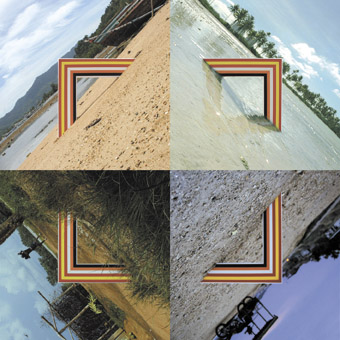
James Geurts, 90 Degrees Equatorial Project. Lightboxes 1 and 2 of 4
JAMES GEURTS’ COMMITMENT TO ABSTRACTION BEGAN WITH A DECISION TO VISIT FOUR CORNERS OF THE GLOBE. DEVELOPING HIS 90° EQUATORIAL PROJECT, GEURTS DREW A SQUARE AND PLACED IT OVER A GLOBE, PINPOINTING FOUR LOCATIONS AT ABSOLUTE 0° LATITUDE, EXACTLY 90° FROM EACH OTHER ALONG THE EQUATOR. THE DESTINATIONS HE SETTLED ON WERE DECIDED ARBITRARILY, HIS ONLY PRECONDITION BEING TO FIND FOUR COORDINATES THAT WOULD STRIKE DRY LAND, IN ORDER TO POSITION AND PHOTOGRAPH A SCULPTURE FIXED AT RIGHT-ANGLES TO THE HORIZON. BY ALIGNING ALL FOUR PHOTOGRAPHIC HORIZONS, THE ANGLED SCULPTURES WOULD FORM A PERFECT SQUARE, OR AS GEURTS’ PUTS IT IN HIS SYNOPSIS: A “CIRCLE-FRAME INTEGRATED.”
Finding four equidistant points on dry land proved to be a significant obstacle. At one location the artist considered building a pontoon. With help from a local friend, Geurts finally fixed on an atoll in the Pacific Ocean that would provide him with a short window to photograph the installation. The coordinates he finally settled upon have a bearing of 100° East (Koto Padang, Sumatra, Indonesia), 10° East (Kango, Gabon, Africa), 80° West (Pedernales, Ecuador, South America) and 170° East (Kiritimati Atoll, Pacific Ocean).
For an imaginary line measuring the equidistant point between the two poles, the Equator has affected some superstitious behaviour. Ancient mariners and modern sailors alike have performed bizarre and often brutal crossing-of-the-line ceremonies, including ritualised beatings, electrocution, walking on hands and knees whilst being pelted with rotten fruit, having one’s head shaved into checker-board patterns, and kissing babies’ bellies covered in axel grease. Off the map, this ‘great circle’ enthralled modern romantic novelists and over time has collected its share of popular myths casting it as a virtual realm in which compasses spin, adventures begin, lost civilisations are discovered, and wash basins drain in the opposite direction.
Whilst Geurts experienced no shortage of adventures negotiating unfamiliar geographical and cultural terrain, the resulting series of photographic sculptures, printed works, and in-camera drawings say nothing of these encounters, showing instead a remarkable dedication to formalist aesthetics and a steadfast resistance to pictorial travelogue. The triangular fabrications Geurts brought to each location are coloured with bold stripes, fashioned after iconic works of abstract minimalism. They are lit from the inside and as such appear to be surreally self-contained: fascinating objects in stark contrast with indifferent and relatively mundane situations. Aesthetically and conceptually, the presence of these objects reveals a unity of purpose, although the reason for their existence remains completely inscrutable. In a less portentous way, their presence reminds me of Stanley Kubrick’s infamous monolith in 2001: A Space Odyssey, compelling as nodes on a route-map of a psychological journey, superimposed upon a geographical one.
The documentation of these temporary installations has been made into photographic light-boxes that float across the floor of the Experimental Art Foundation Gallery in a series of pontoons. Hovering above, from a god-like perspective, an imaginary equator is depicted along with an imaginary ‘frame.’ It is difficult to asses how independently the aesthetic potency of these images within 90° Equatorial Project stands against the extraordinary nature of the process, discussed in detail in an artist talk Geurts presented at the gallery.
At each location the artist committed a series of drawings to paper as abstract impressions of place. A continuum of these was printed into a long foldout artist’s book titled LAT. 0°`0`0. This assembly of mark-making, collaged paper and photographic imagery is an intimately expressive accompaniment to the resolute objectiveness of Geurts’ light-box pieces. A four-panelled video work, Continuum #1, #2, #3, #4, was produced by videoing a non-representational photograph taken at each location and then manipulating the circuit board within the camera during the live-feed. The result is a subtle abstract-impressionist piece that in a minimal sense is suggestive of tidal forces and shifting horizon lines. Continuum isn’t a stand-alone piece but contributes a necessary dynamic quality to the exhibition. There is no such thing as a fixed coordinate in physical space since nature and perception are always in motion.
Other works within the exhibition were engaging but seemed somewhat peripheral, possibly due to their placement in the gallery out of visual range of the other pieces. Equatorial Slide Show is a carousel of contemplative drawings, photographs and digitised abstract images marking the perception of time with each slide. The content here is a little incongruous and seems to belong to another show, although the tempo of the slide projector and the hum of the video installation is delicately drawn together by an over-arching sound work for the exhibition, developed in conjunction with Michael Yuen. This piece, along with a vaporously fine blank square on the back wall of the gallery, provides a subliminal unity to a potentially fragmented display of works.
James Guerts, 90° Equatorial Project, Experimental Art Foundation, Adelaide, April 19-May 19
RealTime issue #79 June-July 2007 pg. 44
© Samara Mitchell; for permission to reproduce apply to realtime@realtimearts.net
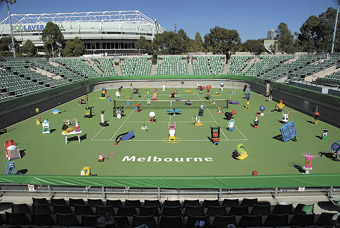
Louise Paramor, Show Court 3
photo John Brash
Louise Paramor, Show Court 3
WHEN REORGANISING A GARDEN SHED FILLED TO THE BRIM, YOU OFTEN START WITH THE ‘WHAT FITS INSIDE SOMETHING ELSE’ SYSTEM: YOU JAM THINGS IN THINGS. OBJECTS SQUIRM UNCOMFORTABLY AGAINST ONE ANOTHER, COMPACTED TO DENSE MATTER UNDER THE COLLECTIVE WEIGHT OF FORCED COHABITATION.
Louise Paramor’s plastic, lolly-coloured sculptural combines often do slip seamlessly inside or against one another, as though an obscure yet universal customisation of random plastic objects has been going on behind our backs.
Paramor’s sculptures obtain strong spatial presence, whilst avoiding forced density, due to her inversion of any pragmatic stacking process. The air around and through these works, the gaps under and in between, never appear as incidental results of an incomplete jam. Instead these objects collude with space, nudging it and toying with it, enabling it to support the work, with negative space acting as a vital formal and psychological component.
The combinations of found plastic forms never appear particularly tenuous or topsy-turvy despite their light-weight materiality and the chunky globs from her hot glue-gun that stick some of the bits together. There should be the logical possibility of disastrous moments, such as the pink plastic chair wedged into the distorted plastic bin suddenly shooting up into the air. But these works maintain such visual stability that they instead achieve monumentality. The equality of positive and negative space creates a fixed presence and command of space that plays beautifully with the carnival quality of Paramor’s lurid hues and playful oddness.
The formal precision of space within the works, seen in highly considered compositions that retain visual balance from all perspectives, was mirrored in their placement in this case across a tennis court. Curator Jane O’Neill’s sophisticated visual flows open up various navigational pathways. The setting is an apt one: like the sculptures, tennis is a game. Both are reliant on precision and a response to the air—the atmosphere—that the ball or the viewer navigates.
The court environment echoed the synthetic nature of the sculptures and the uniform greenness and white lines visually activated the negative spaces of the works. The installation in turn partially transformed the tennis court into an abstracted, formalised space. Similarly, Paramor converted plastic chairs, baby’s bathtubs and balls into shapes and blocks of colour, without disguising their initial functional purpose.
The first view of the sculptural installation was from above, looking down on the expanse of works. The overwhelming richness of visual information from this vantage point was transfixing. Stand and look, circling the court from the first row walkway, or quickly circle to the staircase down on to the court? People drifted from one work to another, circling back for another look, their movements zigzagging and bouncing around. Paramor and O’Neill had concocted a situation which seduced the viewer into enjoying both the panorama and the specifics of each sculpture. Having navigated this oddly elegant display of garden shed debris, I found it best to retire to the bleachers to enjoy watching others do the same.
Louise Paramor, Show Court 3, curator Jane O’Neill, Rod Laver Show Court 3, Melbourne, April 20
RealTime issue #79 June-July 2007 pg. 44
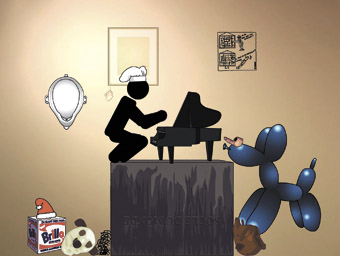
Arlo Mountford, Or Nothing
THE HISTORY OF ART WILL NEVER BE THE SAME ONCE ARLO MOUNTFORD IS THROUGH WITH IT. IN SIMPLE TERMS HIS OEUVRE IS THE FILM ADAPTATION OF ROBERT HUGHES’ THE SHOCK OF THE NEW FILTERED THROUGH THE EYES OF TREY PARKER AND MATT STONE OF SOUTH PARK FAME. THESE ARE WORKS THAT WOULD KEEP ANY ART TRIVIA QUIZ FAN BUSY INDEED, AND THERE IS A KIND OF DELIGHT IN TRYING TO ACCUMULATE THE NAMES AND IMAGES THAT APPEAR ONE AFTER THE OTHER AND THE CAMEO APPEARANCES OF SUCH ART STARS AS THE GUERILLA GIRLS AND JEFF KOONS.
But there is also a serious side to Mountford’s outlandish animations as he traces the history of modernism and postmodernism through the gallery system, wryly commenting on the roles of curators along the way. Nothing, or perhaps everything, is sacred in Mountford’s bizarre mis en scenes. His works balance on a razor’s edge between homage and slapstick, between a keen eye for the intelligent subtleties of contemporary art and the sometimes farcical nature of our genuflection before them.
Mountford’s truly unique animations have become increasingly well-known, featuring in exhibitions at the Adelaide Biennial (2006); Heide Museum of Modern Art (2006); MAAP (2006); and Conical (2006). For his exhibition at Gertrude Street, The Flux of the Matter, Mountford employed his trademark slapstick humour in a selection of new animation works, a live computer work, and a kinetic sculpture.
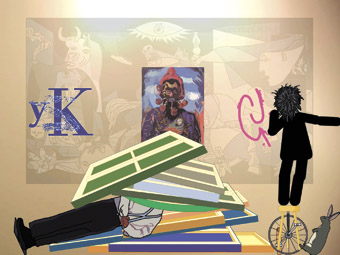
Arlo Mountford, Or Nothing
Mountford appeared on the scene in 2006 with the extraordinary work The Pioneer Meets The Wanderer. The work begins with two simplified black figures on a beach. The bright ultramarine waves ebb and ooze in an hypnotic dance before something improbably emerges from the ocean depths; due to the bizarre context it takes a few seconds to realise that this is Duchamp’s 1913 Bicycle Wheel, the original of which is lost. But now we find that it made its way from Paris to the Antipodes, thus unleashing all sorts of hybrids and mutants. Unaccountably, when the sun-bakers get up to leave the beach they are transported into the interior of a museum where the real adventures begin.
While there are numerous references to international modernism, this is essentially Mountford’s history of Australian art. We travel from McCubbin and Bunny in the National Gallery of Victoria into the modernist interior of Heide, home of John and Sunday Reid and designed in 1963 by Melbourne architect David McGlashan. Along the way one of the characters exclaims “I feel awful”, referencing the character of Miranda in the 1975 film Picnic at Hanging Rock. Along the way we bump into Tucker, Brack, Boyd, Hester and Nolan—all swapping heads in a wry comment on the incestuousness of the Angry Penguins. Towards the end we witness Mike Parr’s famous arm-hacking performance. There’s a kind of exhilaration to picking the references.
Or Nothing, the key work in The Flux of the Matter, takes us on a guided tour of the European and American avant garde. Duchamp’s renowned urinal adorns the wall while an Andy Warhol Brillo box sits on the floor. They become strangely contemplative images as a filmed human youth dashes about with a mobile phone, seemingly impervious to two of the more shattering moments of modernism.
The third icon here I managed to get wrong, convinced it was a reference to Joseph Beuys explaining art to a dead hare, but in Mountford’s notes it transpires that this is a reference to Martin Kippenberger who has oft been described as Germany’s ‘bad boy’ of contemporary art.
The protagonists of this ‘art tour’ are the Swiss artists Peter Fischli and David Weiss and Mountford’s depiction of the artists refers directly to the duo’s 1983 performance The Right Way featuring the pair dressed in rat and bear costumes. Resembling Terence and Philip of South Park, Mountford’s figures engage in any number of interactions with iconic artworks, riding Jeff Koons’ Balloon Dog, wearing Paul McCarthy’s Santa and Chef hats, Jake and Dinos Chapman’s penis, Sarah Lucas’ finger, and shitting text in a reference to Guy Debord’s Memoirs. It’s all hysterically funny and strangely disturbing in its utter irreverence.
There is also a central reference to Chris Burden’s 1985 installation Samson, in which the artist installed a 100-ton jack in the gallery space, pushing massive hunks of timber against the gallery walls, threatening to bring down the museum. The jack was triggered by viewers going through a turnstyle—making the art-lovers complicit in the destruction of the gallery.
Mountford is doing something similar. While less visceral, he dissects the gallery, simultaneously treating the art works as indisputable works of aesthetic and intellectual value (simply by including them) and then allowing his simple black figures to run amok in the space, irreverently appropriating and recontextualising the icons as playthings, props in an ultimately postmodern comedy.
Arlo Mountford, The Flux of the Matter, Gertrude Contemporary Art Spaces, April 13-May 12
RealTime issue #79 June-July 2007 pg. 46
© Ashley Crawford; for permission to reproduce apply to realtime@realtimearts.net
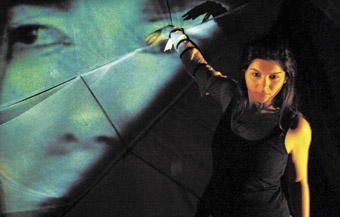
Olivia Crang, Senseless (creative development)
photo Shane Bell
Olivia Crang, Senseless (creative development)
SINCE IT WAS ESTABLISHED IN 2003, THE SPARK PROGRAM HAS SEEN 35 YOUNG ARTISTS THROUGH ITS PROFESSIONAL DEVELOPMENT PROGRAM. AN INITIATIVE OF THE AUSTRALIA COUNCIL AND RUN THROUGH YOUTH ARTS QUEENSLAND (YAQ), SPARK TEAMS UP EMERGING ARTISTS (18-26 YEARS) WITH ARTIST MENTORS, PROVIDING TRAINING, ADVICE AND IN SOME CASES EVEN A LITTLE BIT OF FUNDING TO KICK-START A PROJECT. SIX ARTISTS WHO HAVE HAD THE SPARK EXPERIENCE IN 2005-2006 ARE SURVEYED HERE TO GAUGE THE IMPACT IT HAS HAD ON THEIR PRACTICE.
the projects
Animateur, writer, director, performer Olivia Crang invited David Pledger from Not Yet It’s Difficult to be her mentor in establishing the performance company x:machine. Crang worked with Pledger’s NYID on his latest project apoliticaldance (RT 77, p41, 42). “I liaised with various members of the company while observing rehearsals, as well as organising marketing, publicity and front of house aspects of the production…It offered me the chance to reflect upon my own dramaturgy and working methodologies. [David] has a great way of raising fundamental issues and questioning how his art tackles them…By giving me the chance to become actively involved in his processes, I have picked up on some of his strengths.”
Western Australian dancer choreographer Aimee Smith worked with Andrew Lake to develop a 20-minute solo dance work called Courageously Heroic Gallantry performed by Aisling Donovan (RT78, p33). “I wanted to use this creative process to develop my skills, focusing on the integration of digital media and contemporary dance… With such tight time and financial restrictions new works are often premiered underdeveloped, but with this project I felt…I was that step closer to realising a concept.”
Also in WA, director Matthew Lutton set himself up with Artrage’s Marcus Canning as mentor to help his company ThinIce to create their first self-devised (as opposed to pre-scripted) work, The Gathering (RT70, p15), and to guide the company through a key growth period. “I was preparing to apply for our first annual program of activities, so I needed to learn a lot of new skills about setting up company structures…It was about having an outside eye, and a support network…someone who was objective [about] my artistic process, but was intimate with my work and aesthetic.”
Megan Sarmardin met composer and instrumentalist John Rodgers when she was performing in Bob Cats Dancing for the 2004 Queensland Music Festival. She subsequently asked him to help her develop a music theatre piece based on her family history. “Out of this project we worked together to develop the show and two songs; Little Birung (about my great-great grandparents fleeing from the authorities) and No Where to Hide (the experience of what I thought my great-great grandmother went through when she saw non-indigenous people for the first time).” Through the project Samardin was able to develop both her songwriting and performance skills. “I’m more confident in performing. I have worked with a number of musicians thanks to [John’s] musical knowledge and networks.”
Teik-Kim Pok is a Sydney based artist who worked with Rolando Ramos to create the video design for PACT Youth Theatre’s production Before the Lights Go Out (RT71, p32) at the Sydney Opera House. He was particularly interested in Ramos as their career trajectories were similar. Both started as performers and shifted into video work. Pok drew on Ramos to develop technical skills but also to have “conversation[s] about the role of the multimedia artist in the collaborative dramaturgy of the live performance we were working on…I managed to get a better idea of what my performative aesthetic was in an overall sense rather than actually splintering my identity as performer and then multimedia creator.”
As of 2006 SPARK opened its doors to visual artists as well. Queensland artist and curator Bree Jackson was able to draw upon the skills of Raw Gallery’s Rob Kelly, working as the exhibitions co-ordinator as well trying her hand at curating a major exhibition: You Are Here. “The fact that my SPARK experience was project-based really helped with being able to draw on actual experiences and questions to approach my mentor with…Being part of [it] has definitely helped me to make people more aware of my practice and abilities and kick-start my practice as an emerging curator by getting my name out there.”
the caffeine catalyst
At the beginning of the ten month program, YAQ co-ordinates a formal three day planning session where all the mentors and mentorees come together. There is an expectation that meetings between the mentor and mentoree will take place every few weeks, but beyond that how the relationship transpires is up to the individuals. Most of the six artists surveyed believe that coffee was the best catalyst for their information exchange. Jackson says, “My mentorship with Robb was really laidback. We had casual meetings to discuss the project and basically just had a chat about where I could go from here, how I should approach each situation.”
Smith says, “We would chat about ideas related to the work and my practice, and other times we’d chat about things completely unrelated. The more regularly we did this, the more information was exchanged, the more we got to understand each other’s practice, and the deeper the mentorship grew.”
For Lutton being able to get all his ideas out to an eager experienced ear was vital. “I am notorious for having too many ideas swirling around in my head… a lot of the time Marcus would just let me talk through my plans, and he would then encourage me to be more precise and succinct. He would help me clarify my goals.”
For Samardin, trust and mutual respect is the key to their successful relationship, “to communicate with one another on both a professional and personal level. I trust [John] enough to tell him feelings about certain events/experiences in my life, then we make it into a piece of music/work.”
professional profiling
In addition to the artform specific wisdom that mentors were able to share, all the mentorees talk most positively about the networking and profile opportunities that came from these professional relationships. Crang states that it has put her in “closer proximity to the networks, resources and knowledge that I need to develop, engage with and extend my practice.”
Bree Jackson says, “With direct support from YAQ and the…Australia Council [connection] it was definitely easier to get important industry professionals and contacts along to the exhibition…From my involvement in SPARK I have made some great contacts and networks that I could call on for future projects.”
For Smith and Pok it was important to connect with peers. Teik-Kim Pok says “to meet other artists from around Australia of my age, who were looking to develop their own practice in a similar spirit in different artforms, gave further definition and context to my ideas and process.” It was a similar situation for Lutton who met his latest collaborator through Canning: “I am currently creating a new version of Antigone with local song writer and performer Rachael Dease, and it is a result of my mentorship that this connection was made.”
up and running
The all important factor of development programs is what happens afterwards.
All of these mentorees still have active engagements with their mentors. Crang meets Pledger once a month for feedback and discussion, Jackson still works for Kelly at Raw Space and is now on the board, Samardin has been working with Rodgers on a variety of projects, and Lutton’s offices are based at Artrage with Canning. Lutton states that his relationship has shifted subtly from mentor to colleague: “The mentorship certainly set up a relationship…and I know that Marcus is someone I can always turn to for advice and feedback.”
When you look at the projects the 2005-2006 participants have on the boil, the results of SPARK are impressive. As well as a string of directorial projects including The Lady Aoi for Black Swan Theatre and Perth International Arts Festival (RT 79 online), Lutton’s ThinIce company is applying for its second round of annual programming funding from ArtsWA. Lutton is also off to England to work on a contemporary opera for Aldeburgh New Music after which he returns to assist Neil Armfield on Michael Gow’s Toy Symphony. Olivia Crang’s x:machine launched in March and is working on Senseless, a collaborative piece for 25 artists of different disciplines conceived online for the Melbourne Fringe Festival, and Serial Blogger for Next Wave 2008. Megan Samardin is developing a proposal for the 2007 Gympie Muster as well as working on corporate gigs like the Department of the Premier’s Reconciliation Business Awards and making her demo tape. Bree Jackson continues to work at Raw Space, is the Exhibitions Assistant at Institute of Modern Art (IMA), as well as applying for other curatorial projects. Teik-Kim Pok is off to Guillermo Gómez-Peña’s La Pocha Nostra Summer School in Tucson, Arizona courtesy of a RunWay emerging artists travel grant. And Aimee Smith, along with tripping over to Taiwan to choreograph a work for the Taipei National University, has joined the EPIC program (Emerging Producers in Community; RT 73, p9) to work with AWESOME Arts in regional communities in WA.
With similar achievements for many of its participants, the SPARK program seems to be fulfilling its brief to “fire up young artists”, and there are now 12 more with the announcement of the 2007 participants. Let’s hope that small and sporadic funding and the general insecurity of life in the arts in Australia doesn’t extinguish the flame.
* * *
2007 SPARK teams are Yusuke Akai (QLD) & Jim Denley (NSW), Aisling Donovan & Sue Peacock (WA), Ashley Dyer & Margery Smith (NSW), Ofa Fotu & Steve Bull/Kelli McCluskey (WA), Amber Haines & Stephanie Lake (VIC), Luke Haralampou (QLD) & Morgan Lewis (NSW), Ming-Zhu Hii & Melanie Beddie (VIC), Gareth Hudson & Art Phillips (NSW), Alisdair Macindoe & Lucy Guerin (VIC), Paul Morrison (NSW) & Brian Lucas (QLD), Lara Thoms & Caitlin Newton-Broad (NSW), Willoh Weiland & Roger Alsop (VIC)
SPARK, Youth Arts Queensland; www.yaq.org.au
RealTime issue #79 June-July 2007 pg.
© Gail Priest; for permission to reproduce apply to realtime@realtimearts.net
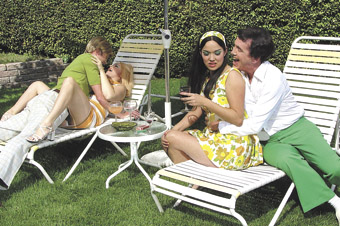
Swingers
AT A TIME WHEN THE FUTURE OF THE TRADITIONAL FILM FESTIVAL IS A MATTER OF SOME DEBATE, TWO OF AUSTRALIA’S NEWEST FESTIVALS ARE FORGING AHEAD. WHILE ADELAIDE HAS JUST SEEN ITS MOST SUCCESSFUL EVENT BOTH CRITICALLY AND IN TERMS OF ATTENDANCE, PERTH’S REVELATION FILM FESTIVAL IS ABOUT TO CELEBRATE ITS 10TH BIRTHDAY WITH A LARGER AND EVEN MORE INNOVATIVE PROGRAM, MORE FILMS AND A NEW ARTISTIC DIRECTOR. MEGAN SPENCER, DOCUMENTARY MAKER (LOVESTRUCK: WRESTLING’S NO. 1 FAN; RT78, p20) AND FILM CRITIC FOR TV AND RADIO, HAS LEAPT ENTHUSIASTICALLY INTO THE TASK OF KEEPING REV ONE OF THE MOST IMAGINATIVE AND CHALLENGING ANNUAL EVENTS ON THE SCREEN CULTURE CALENDAR.
While the more established film festivals are trying to adapt to new ways of looking at cinema, and still grappling with the rather delicate balancing act of satisfying their older, subscriber-based audiences with more traditional offerings while attracting the very necessary newer and younger audience with diverse and provocative programming, younger festivals don’t have this challenge. Their audiences are risk-taking, attracted by innovation; these events can grow organically with their audiences, can enjoy the new ways of both making and experiencing the moving image.
Unlike the larger and more traditional film festivals, which developed naturally from the film society movements or from a city or a community’s need for such an event, the Revelation festival emerged from a desire to screen underground films from all over the world, and a need to take cinema into different environments. Now the event is very healthy; it has state and federal government support through Screenwest and the Australian Film Commission, triennial funding, and a strong sponsorship base.
Rev began in 1997 as an underground event in a basement, Perth’s smoothest jazz venue, where it screened everything on 16mm and included live music and poetry. On its tenth anniversary—titled Revolution. Retrospective. Revelation—Rev will screen around 100 features, documentaries and short films, as well as music videos and experimental work, include a late-licensed festival club and other music and film related activities, and present them at both established cinemas and at nightclub venues. Rev hasn’t abandoned its underground beginnings: Cinema Tabu will present a microcinema showcase of strange films from around the world in a bar environment. Brent Hoff from San Francisco is editor of Wholphin DVD Magazine (an offshoot of cool literary journal, McSweeney’s) and gathers together rare and unseen films to release on DVD. He will screen a selection of these as part of Cinema Tabu.
Already a filmmaker and reviewer, Spencer hadn’t been planning to look for a job as artistic director of a film festival. When she actually considered accepting such a role, however, she realised that every experience she’d had “coalesces and becomes relevant. I’ve got the benefit of being a filmmaker, and of knowing what filmmakers want and hope to get from a film festival. And I’ve seen thousands of films. I’m aware of the cultural and critical connections. I understand the lie of the land and I think I know what to program for the audience to connect with.” And, she says, becoming artistic director of Rev is really a natural progression. “I’ve cheered it on as an exciting new event, I’ve had films screened there, I came over to Perth twice with SBS’s Movie Show. I think I understand what the audience wants.”
Unlike most festival directors, she hasn’t been able to travel to overseas festivals to put her program together. Instead, she’s been programming from the internet, through other festival websites, festival reviews, and the many new avenues offered (“MySpace has been a very good source”), while Rev’s growing identity has, of course, made it attractive, with over 500 films submitted for selection from local and international filmmakers. Working closely with Rev founder Richard Sowada (now Head of Film Programs for the Australian Centre of the Moving Image in Melbourne, but still chairman of the Rev board and very involved) in choosing films, she’s particularly excited about the queer cinema strand, which includes John Waters’ Pink Flamingos (1972), Anna Biller’s Viva (2006; a parody of 60s sexploitation films) and Mary Jordan’s documentary, Jack Smith and the Destruction of Atlantis. “I’d never heard of him—I was just stunned when I saw the film. It’s amazing when you discover someone like that, and other filmmakers fall into place.”
Spencer hopes the activist strand will encourage at least some audience members to, well, become active and do something. There’s Iraq For Sale (2006) by Outfoxed (2004) director Robert Greenwald, on war profiteering; God’s Ways, by German filmmaker Evan Neymann, on two street kids in Odessa; and Soft Words, an Australian short film by Adrian Francis on political spin about asylum seekers and how it abuses language. Rev’s strong documentary strand this year includes something Megan Spencer is particularly excited about: a mini-retrospective of the work of famed documentary-makers the Maysles brothers, with two short films showing Truman Capote and Marlon Brando in a fresh and unexpected light.
Super 8—that little film gauge that just won’t go away—is the surprise element in Rev’s 10th birthday, forming the basis of the new film competition, Revel-8. (“The more we go forward in time, the more incandescent Super 8 becomes”, comments Spencer.) Former director of Perth’s lost and lamented Pandora’s Box Super 8 Film Festival and ECU lecturer Keith Smith takes charge of this new event celebrating the fusion of image and sound, inviting both experienced and novice filmmakers resident in WA to participate. “Super 8 is the original DIY medium and is still finding new devotees after 40 years of glorious imaging. It’s not just the unique look, there’s something magical about working on Super 8 which brings out a special creativity”, he explains. Filmmakers are challenged to make a silent, unprocessed film, edited-in-camera, on a single Super 8 cartridge, lasting just three and a half minutes, on the theme, “Birthday”, using an experimental, animation, drama or documentary approach. Then the best 20 films will be scored by composers at the WA Academy of the Performing Arts and screened in a 5000W flickfest at the Rev Club on Friday July 20, with lots of creative and genre prizes on offer.
A major element of the festival is the Screen Conference, which was initiated last year as a space for filmmakers and those involved in many aspects of the film industry to discuss and workshop a range of related issues. This year the conference has grown, and its guest list includes representatives from the international distribution scene, local and international filmmakers, composers, editors, cinematographers and writers. Featured conversations, masterclasses and workshops include two sessions on HD Heaven (a masterclass with Toby Oliver ACS, on working with HD); Art of the Music Video, with both an international and local focus; The Art of the Short Film; Loving the Alien: The Relationship Between Documentary Filmmaker and Subject; Shedding Light: Performance For Screen; and DIY or Die on digital filmmaking and alternate modes of exhibition and distribution.
Special festival guest and anime proponent Phillip Brophy will be presenting Tezuka: From Manga to Anime, on how Osamu Tezuka transformed his manga into anime. Rev is screening Brophy’s curated program, Focus on Tezuka (already seen at the Art Gallery of NSW and ACMI), with its kids’ flicks component of Astro Boy and Kimba The White Lion, and five fantastic adult animations. Brophy will also be represented in his filmmaker and sound design artist mode; during the festival he’ll be performing The Planets, a remixed presentation of his exquisite cinema scores live, and screening his Evaporated Music series of big-budget, high-gloss video clip images reworked to monstrously alien sound. And his notorious sci-fi horror comedy from 1993, Body Melt, will have a rare screening.
Strange Culture (2007) is a convention-defying documentary by Lynn Hershman Leeson which screened earlier this year at the Sundance and Berlin Film Festivals. It documents the extremely paranoid reaction of US security authorities in the case of internationally acclaimed artist and professor Steve Kurtz when his wife Hope died in her sleep of heart failure. Police arrived, became suspicious of Kurtz’s art, and called the FBI. Within hours the artist was detained as a suspected ‘bioterrorist’, his computers, manuscripts, books, his cat, and even his wife’s body were impounded, and he still awaits a trial date. While Strange Culture manages to reinvent an old form while telling an urgently topical story, what makes it even more memorable is that the Sundance Film Festival screened the documentary in Second Life, the first feature film to be screened on the online community. Rev will not only be screening the film, but will also include a panel on Second Life as part of the Screen Conference—Second Life and Beyond: Virtual Communities and Making Media in a Digital World, organised by Mick Broderick.
Megan Spencer hopes that her first festival will continue the great work that Richard Sowada has done in making Rev a very distinctive event. Sowada himself is cautious about the future for film festivals: “a not-for-profit event has to exist in an exhibition culture that’s commercially based, that’s totally geared to making money. Rev is all about audience development, and that’s a very difficult area to navigate right now.” Spencer thinks that “what makes Rev special is that it opens up a dialogue with the individual filmmaker, and brings in people from all aspects of filmmaking. What I’m trying to do is blur it all: see how digital culture is affecting film, how much feature film has taken from music video—and vice versa. It’s important to recognize what’s going on, and to discuss and debate it. I believe in plugging film into film culture, rather than the industry, and I think that’s what Rev does.”
Revelation Perth International Film Festival 2007, July 12-22, www.revelationfilmfest.org
RealTime issue #79 June-July 2007 pg. 21
© Tina Kaufman; for permission to reproduce apply to realtime@realtimearts.net
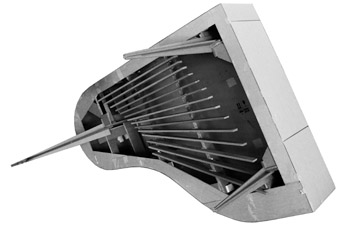 Jonathan Dady, Cardboard Pianos, installation,
Jonathan Dady, Cardboard Pianos, installation,
There Forever, Port Adelaide
What are the markers of this great age of hybridity? In the arts they are transience, transformation and sensory transport in works that heighten our sense of ephemerality, of mutability and, with apparent magic [digital and otherwise], shake loose our perceptual certainties. In There Forever, Jonathan Dady’s cardboard pianos exhibited in a deserted shop in Port Adelaide [page 4-5] evoke the fragile, even surreal aspirations embodied in the incipient regeneration of an old suburb. In Merilyn Fairskye’s video work Stati di Animo [p3], past and present likewise co-exist in the moment, in a dynamic of stillness and motion—the photographic fixity of waiting airline passengers juxtaposed with the ghostly brushstrokes of those on the move. In Aqua [cover image], Fairskye’s new work for Stills Gallery, the video image of a swimmer is layered some 50 times, each image a second apart, generating an intensely fluid impressionism—‘now’ and ‘then’ constantly folding into each other. Whether in the works of Dady and Fairskye or in Jia Zhang-Ke’s feature film, Still Life [p17], where we are invited to look in real time rather than surrender again to the edit, or in Craigie Horsfield’s enigmatic “slow time” photography [p41], or in Chris Marker’s Owls at Noon [p27], or in the Wooster Group’s replay and recreation of Richard Burton’s 1954 made-for-television Hamlet, it is above all our sense of time, perceived visually, aurally, spatially and filtered through many media, that is radically undone. 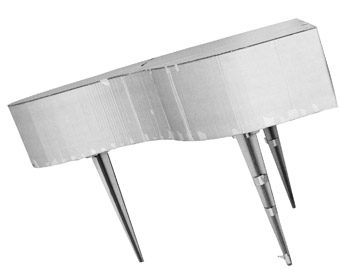 Jonathan Dady, Cardboard Pianos, installation,
Jonathan Dady, Cardboard Pianos, installation,
There Forever, Port Adelaide
RealTime issue #79 June-July 2007 pg. 1
© Keith Gallasch; for permission to reproduce apply to realtime@realtimearts.net
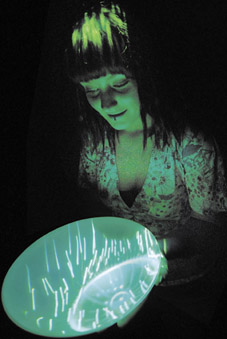
Lynette Wallworth, Hold: Vessel 1
photo Colin Davison
Lynette Wallworth, Hold: Vessel 1
LYNETTE WALLWORTH IS KNOWN IN AUSTRALIA FOR HER MUCH LOVED WORK, HOLD: VESSEL, WHICH HAS BEEN SHOWN AT THE ART GALLERY OF NSW, ACMI, DAVIS MUSEUM (USA), AND CURRENTLY AT THE NATIONAL GLASS CENTRE IN THE UK .
More recently Wallworth has been solidly foc sed on research and production for new works culminating in a series of high profile international exhibitions—at the New Crowned Hope Festival in Vienna, Arnolfini in Bristol, Auckland Triennial, the National Glass Centre, and the second exhibition for the newly launched BFI Southbank. The BFI have extended their commitment by commissioning a new stage for Hold. I caught up with Wallworth on the brink of a busy few months of production.
I am in the process of developing the work for the BFI so I am busy connecting with marine specialists I first encountered when working on Hold: Vessel 1. These are people like Marine Biologist Anya Salih who works on understanding the uses of the fluorescent gene in coral and David Hannan who first filmed the mass spawning event on the Great Barrier reef in 1990 and has been filming reef systems in all the years since. They are absolutely focused on corals, all of them in a slightly different way and they are the same people who informed my understanding then of the future stresses on marine organisms if current predictions of climate change held up. That was in 2001.
The issue of climate change was not in the public imagination then. Now I look at the footage in Hold and think, okay, I used this imagery of the giant kelp forests of southern Tasmania for example and only about five percent of those kelp forests exist now. So it feels a very potent time to be making this next stage of the work; it was something I always intended. The thing that has changed I think is the context. It feels to me as though everything I thought about in making the work has become transparent in the intervening years. To hold an underwater world in a fragile glass bowl gives a very clear, tangible sensation of these environments. It has become patently clear to most people that we really do have to think about what we are handing on to those coming after us.
It had always been in my thinking that the work would evolve, because marine environments are changing so rapidly, but it has been difficult to raise funds to make a finished work. The BFI, through Michael Connor’s curation, completely comprehended that this was a part of the work from its inception, this process of evolution and being able to walk through both the work and through different time spans. So it’s really a fantastic opportunity I’ve been given to continue it, and on the other hand it’s very confronting. It’s the strange sensation of making a work at a time when the impetus for the work has intensified.
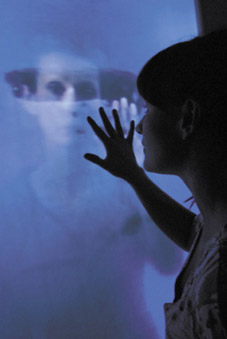
Lynette Wallworth, Invisible by Night, 2004, commissioned by Experimenta
photo Colin Davison
Lynette Wallworth, Invisible by Night, 2004, commissioned by Experimenta
I always think that I make works that are communal at their core. I love looking at the way people who don’t know one another form a sort of temporary community whilst in the space together—there’s is something very anti-hierarchical about it. I certainly contemplate accessibility and the ability for people to be able to resolve the work with one another and I am interested in creating a tangible sensation of the audience being implicit to the work.
In a significant retrospective of her work At the New Crowned Hope Festival in Vienna, Wallworth exhibited five works including two new commissions.
Vienna was really one of the most satisfying times of my life. The curator Peter Sellars very carefully determined the way that you would move through the exhibition such that the relationship between the works became really apparent. Peter has worked a lot with Bill Viola and has a wonderful understanding about the best environment for experiencing these works. So he drew a map—I’ve still got this little serviette that I kept when, sitting in a café with him, very late one night in Vienna, he drew the journey from piece to piece. He is extremely attuned to things like how long it takes your eyes to become used to the physical aspects of being in a video installation.
My work is very slow in tempo and here was a way of placing things that supported the pacing needed and encouraged the sensation of immersion. I didn’t realise how obsessed I am with darkness until I saw all of these works together, but it is a very comfortable space for me. I am interested in how to construct darkness so you can rest in it, be altered by it. The other huge change in terms of the exhibition experience was that I had the support of FORMA [the Liverpool-based media arts agency], which has been a really significant breakthrough for me. For years I tried to find ways of getting my work produced in Australia but individuals can’t sustain a company that does this sort of work without funding. FORMA produce and tour for me so my life has changed. I feel now my practice is sustained and sustainable.
The opportunity to show in a festival is wonderful because of the focus on so many different art forms and artists—I got the opportunity to meet and talk with some of my favourites, especially filmmakers, as well as meet new ones. And the flow on has been great. There is interest in showing these pieces now in France, in Rome and in New York. Galleries are the best equipped to show it, but the festival environment gives the opportunity for the work to find relationships with other artforms.
The major new commission for Vienna was an interactive work, Evolution Of Fearlessness, for which I filmed 11 women, most of them political refugees. The experience of the work is a moment of ‘video meeting’ when the women respond to the viewer’s touch. In Vienna the relationship of this work to some of Sellars’ commissioned films was really interesting—the same medium with very different modes of delivery—and it sparked my thinking about where to go next. There’s an amplification that happens with this kind of attunement and that feels like a perfect home for me.
Prior to Vienna Wallworth spent three months on a British Council residency at the National Glass Centre in Sunderland, a chance for her to deeply examine the medium of glass, which she has used frequently in her work, and to develop new works combining video and glass.
Sunderland was very contemplative. It’s completely different working on glass than on a Mac G5. It made me think about the longevity of work. The history of glassmaking is a part of the experience of the National Glass Centre; it’s where the first stained glass was made in England. You can’t be there and not become cognisant of the historical importance of the medium. That haunts me really, because of the medium I work in. For example, the projectors we used to make Hold in 2001 are no longer in production, you can’t buy them any more and that’s in a six-year timespan. The software that we use to deliver work changes every year so it’s impossible to know how the work can be seen in 100 years time. Whereas a glass bowl that I made in Sunderland last year could still exist in that form, cracked and scratched, in a thousand years time. There is no economic determinant to make a piece of glass obsolete. This tension is inherent in the history of art, the experimentation with new materials and the concern for longevity. It really expanded my thinking about what are the essential tools.
The other thing that came from that time was that my work is still very strongly linked to being in the Australian landscape, so being in Newcastle (UK) for that length of time was quite challenging for me, but also helped to clarify why I still need to come back here to develop new pieces. It’s certainly easier for me overseas right now, my work is shown more and commissioning opportunities are definitely coming from Europe in a wonderful and supportive way. But I still find it beneficial to come home and make the work—there’s a fluidity about it, along with being able to work with the same people as a team. I think it makes the work much stronger. It means you can shorthand a lot of things and so take them in unexpected directions. But still, when I made Evolution of Fearlessness I imagined I would film women from other parts of the world, and I’m still thinking about that. It might be the one that actually shifts me out of this compulsion to make work out of Australia.
Lynette Wallworth, Hold: Vessel 2, BFI Southbank Gallery, London, June 23-Sept 2, www.bfi.org.uk. Touring produced by Forma, www.forma.org.uk
RealTime issue #79 June-July 2007 pg. 2
© Fabienne Nicholas; for permission to reproduce apply to realtime@realtimearts.net
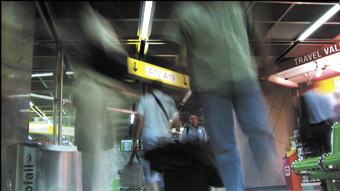
Merilyn Fairskye, Stati d’Animo (States of Mind), 2006-2007
courtesy of the artist
Merilyn Fairskye, Stati d’Animo (States of Mind), 2006-2007
MERILYN FAIRSKYE’S STATI D’ANIMO (STATE OF MIND) EVOKES THE INTERNATIONAL AIRPORT EXPERIENCE LIKE NO OTHER ARTWORK I CAN RECALL. THE THREE-SCREEN WORK THAT WRAPS AROUND YOU AT ARTSPACE FUSES AT LEAST TWO STATES OF BEING INTO ONE. FIRST, THERE’S WAITING, WITH ITS SHEER STILLNESS, HERE A PRECISE PHOTOGRAPHIC FIXING ON THOSE SITTING OR STANDING. THEN THERE’S MOVEMENT, THE PURPOSEFUL STRIDE OR ABSENT-MINDED WANDER, REALISED CINEMATICALLY AS A GHOSTLY BLUR OF BODIES WALKING, RIDING ESCALATORS, HAULING THEIR BAGGAGE. THOSE WHO WAIT APPEAR FROZEN IN TIME, THOSE WHO MOVE SEEM ALWAYS ON THE EDGE OF DISAPPEARING. THE NOWHERENESS OF AIRPORTS AND THE SENSE OF ETERNAL TRANSIENCE IS RENDERED EVEN MORE PALPABLE IN THE WAY FAIRSKYE GIVES BUILDINGS, EQUIPMENT AND AEROPLANES THE GREATER SOLIDITY—HUMANS ARE A MERE EPHEMERAL PRESENCE.
With her Sony HDV camera hand-held, mostly at waist level, Fairskye recorded at Charles de Gaulle, Darwin, Dubai, Frankfurt, Helsinki, Hong Kong, JFK, Kuala Lumpur, Los Angeles, Pudong, Sao Paulo, San Francisco, Singapore, Sofia, Sydney and Vienna airports. She writes, “the camera moves or rests without composing or focussing on the people it tracks and traces” in a work that is not “investigative or ethnographic documentary. Nothing specific is revealed. The aim is to achieve a sense of things, of simultaneity, rather than a direct account or story.
“The formation of the interior airport images in this work is different from conventional film and photography. It closely resembles the sequenced exposures of chronophotography by Jules Etienne Marey which (like Henri Bergson’s reflections on time) inspired the painterly experiments of the Futurists that this work evokes. The effect is to condense and dilate the experience of time, by superimposing a sequence of frames in fifty transparent layers.”
This layering allows Fairskye to conflate time so that we are watching past and present at once folding into one another: “the ‘present’ is thus continuous (and coexistent) with the past, in a perpetual state of becoming and vanishing, in the same way as the people who briefly inhabit the airport, and the airspace above it, become and vanish.”
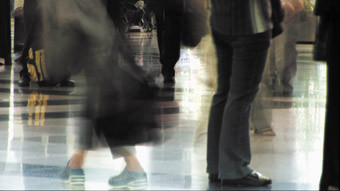
Merilyn Fairskye, Stati d’Animo (States of Mind), 2006-2007
courtesy of the artist
Merilyn Fairskye, Stati d’Animo (States of Mind), 2006-2007
The association with Futurism is quite precise—the title is taken from Futurist artist Umberto Boccioni’s 1911 trilogy of paintings which has the railway station as its zone of transience. Painting and train station are replaced in Fairskye’s work with digital art and airport, the joys and anxieties of machine age speed paralleled with those in our own time to do with computer speed and hyperconnectivity. But the vulnerability of bodies and machines persists, not only in the visual ephemerality of Fairskye’s airport inhabitants, but in their words.
Structured into passages of Arrival, Crossing, Waiting, Departure and Farewell, the video watches but also listens. What appears to be airport background noise is revealed to be something more: at one point the attentive listener is privy to a dialogue between airline cabin staff on one plane and the control tower—a terrorist drama appears to be unfolding in the cockpit. The aeroplane moves across the tarmac and then, when air control says, after communication is broken, “We’ve lost them”, the jet simply disappears against the background of buildings and other aeroplanes. Life in the airport terminal goes on, with its alternating solidity and blurring.
I asked Fairskye about about the technical side of her work which, she writes, “is quite simple but chews up a lot of render time. I had already sorted out the process in principle when I made an earlier three-channel Stati d’Animo installation (Stills, 2005, shot on SD and working with 25 layers only). Greg Ferris worked on post production for Stati d’Animo 2006. The new material was shot on HDV. Once the offline edit was completed, all the interior airport shots were each subject to the following process.
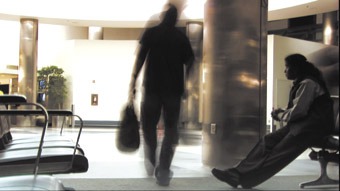
Merilyn Fairskye, Stati d’Animo (States of Mind), 2006-2007
courtesy of the artist
Merilyn Fairskye, Stati d’Animo (States of Mind), 2006-2007
“A template was set up in After Effects for 50 duplicate layers of video (going to 50 from 25 made the image much more fluid.) Each layer was moved along one frame. So overall, there was a time overlap of 2 seconds by the end of the particular shot. The opacity of each subsequent layer was decreased according to a formula I have worked out so that by the time you got to layer fifty there was still a visible trace of all the preceding layers, including layer one, but from two seconds earlier. This is an aspect of the process that is crucial from my point of view—a visualisation of a temporal depth that is quite different from linear duration. Lastly, the whole thing was rendered, and imported back into Final Cut Pro as a single track video, and colour corrected. With my new work, Aqua, I am doing everything in Final Cut Pro, greatly assisted by the Paste Attributes command.”
Fairskye’s new video work Aqua (see our cover image), premieres soon at Stills Gallery as an installation. I had a glimpse of the video in preparation. The look and feel, quite different from the gently fluent if eerie time shifts of Stati d’Animo, is of an intense vibrancy, a living impressionism and, again, magical play with technology and perception.
Merilyn Fairskye, Stati d’Animo (States of Mind), 2006-2007, three-channel video installation, writer, director, producer Merilyn Fairskye, camera, post production, sound Merilyn Fairskye, Greg Ferris; Artspace March 16-April 14
Merilyn Fairskye, Aqua, Stills Gallery, Sydney, July 18-Aug 18
RealTime issue #79 June-July 2007 pg. 3
© Keith Gallasch; for permission to reproduce apply to realtime@realtimearts.net
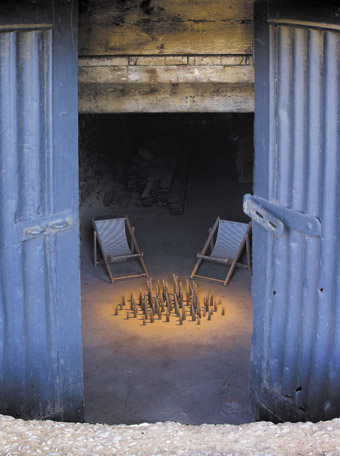
Angela Valamanesh, New Metaphors
photo Anton Hart, image courtesy of artist
Angela Valamanesh, New Metaphors
“PORT ADELAIDE—IT’S HAPPENING!” READ THE SIGNS AROUND THE LARGEST WATERFRONT URBAN DEVELOPMENT BEING UNDERTAKEN IN SOUTH AUSTRALIA OVER THE NEXT DECADE. IN THE VISION AND FRAMEWORK DOCUMENT FOR THE NEW CITY, JAN GEHL, PROFESSOR OF URBAN DESIGN, TALKS ABOUT PORT ADELAIDE IN RELATION TO OTHER RECLAIMED WATERFRONT CITIES IN THE WORLD AS “JUST WAITING TO BE RECONQUERED. “ HE SEES THE CENTRE AS HAVING “LOST ITS CONNECTION TO THE WATERFRONT…THE WORKING HARBOUR IS IN THE PROCESS OF BEING TRANSFORMED INTO A RECREATION HARBOUR WITH THE OPPORTUNITY TO REINVIGORATE PORT ADELAIDE CENTRE AND RECONNECT IT TO THE WATERFRONT.”
Transforming this historic city has unearthed predictable disputes to do with insensitive development. Hoping to generate more complex discussions around what constitutes a sense of place, artist and local resident, Linda Marie Walker responded to her strong feelings about the Port with an “ephemeral public art project” entitled There Forever. As part of the Port Festival, the event involved eight artists creating works that each in their own way addressed the subtle striations of history that are potentially warped in any major urban re-design.
“The title refers to the idea that everyday attention, deliberate action, and continual work is required in relation to the infinite memories and physical bearings of a place to ensure that these remain as part of a place’s past and future”, says Walker in her curatorial statement.
Yhonnie Scarce traces the trajectory of Fanny Graham, an indigenous woman born (1925) at Point Pearce Christian Mission on the York Peninsula and buried there (1967), who spent part of her itinerant life in the Port. The artist creates a kind of map, sewing coarse red thread onto tough black canvas, in the process engaging with people moving through the Visitors Centre. At the climax of the event, she will fold the cloth and place it beside the paper dress pattern and white gloves in the suitcase which lies open on the floor of the project headquarters in the old ANZ Bank building in Lipson Street.
Julie Henderson has taken up residence for a time down at the harbour, slowly acquainting herself with some of the people who gather and work in the sheds and shacks there. Her DVD, installed in the door of one of the boatsheds, documents the artist’s conversation with the boat builder who has worked there for years. His face never appears, only his body and the materials of a craft to which he is clearly devoted. Ambivalent about the luxurious life his boats may go on to enjoy in one of the Port’s proliferation of planned new marinas, the boatbuilder says of his boat’s new owner, “I think he called it Georgia.”
Nearby is the Radio Shack in which Henderson has spent long periods listening to men from the amateur radio club. She’s filmed their idiosyncratic environment and recorded their conversations and documented one man transmitting a message in Morse Code (he chose “the moving finger writes and, having writ, moves on…”). Henderson also stages a performance at night on the site of the old shed 5 (“Look for two lights, bring an umbrella”).
Inside the shack, Julie Henderson says she can’t quite settle on what constitutes the art of this project. On the website she muses: “Perhaps the work is impossible or perhaps it is already there and I just need to notice its formation among other things. I am in the space of the swamp, the dock, the boat-builder and the amateur radio club and I’m localizing and taking small opportunities to meet them. I’m in their place—it is an open shape with details that we inhabit together for now.”
As in all the works in There Forever, a sense of quiet and detailed evidence-gathering pervades amidst the more urgent atmosphere of impending disappearance. As part of the redevelopment, and lacking obvious “heritage” status, the Radio Shack may be razed anytime soon, like the nearby boat sheds.
Elements of the works that can be pinned down form an intriguing exhibition in the bank building which is the project’s HQ. Denuded of all but its elegant proportions, this house is full of subtle surprises.
In the ceiling of one room, Jess Wallace’s video, Buoyancy, references the buoys in the river that have been out of bounds since 1869 by Declaration of the Marine Board Act. Wallace projects young swimmers flouting the law, as kids at the Port have done for years, freely floating them above our heads.
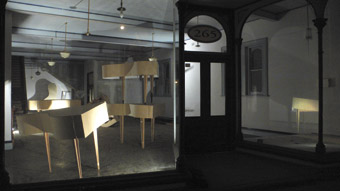
Jonathan Dady, The Cardboard Piano Shop;
photo Jonathan Dady, image courtesy of the artist
Jonathan Dady, The Cardboard Piano Shop;
A wall away, in perfect light filtered through large windows and reflected off the buff colours of the paint-stripped house, Jonathan Dady’s elegant cardboard piano makes silent music. Down the hall, Julie Henderson’s harbour video sits atop a 1960s TV set transmitting interference from the Radio Shack.
Downstairs, James Guerts’ Bridge Drawing Water displays the beginnings of the artist’s collection of casual markings gathered from the wharf and drawn onto the walls of the house. Another surprise— one stair tread is painted gold.
Angela Valamanesh’s New Metaphors began in the mangrove sites once pervasive around the Port but now almost invisible. In the basement below a studio in Divett Street, she installs a small drama. Peering down from the street, we are faced with two miniature deckchairs addressing a series of clay replicas of pheumatophores—aerial roots of mangroves that grow above the low tide level to allow the plants to breathe. Says Valamanesh “I’ve been wondering why mangroves are of interest to me as a visual artist. I think it’s that they are plants that live in both water and land and have characteristics which visually link them to human and animal life.”
Jonathan Dady’s proliferating pianos make another appearance, this time displayed inside a graceful disused shop on the main street. Starkly lit, and randomly displayed, they maintain their sense of grandeur—prototypes perhaps for the aspirations of a working class area gradually succumbing to gentrification.
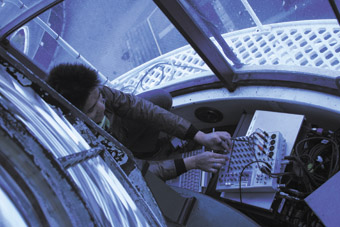
Michael Yuen, Flash
photo James Geurts, image courtesy of the artist
Michael Yuen, Flash
Among the performance works which my sole foray precluded attending was Michael Yuen’s Flash: “At this place and time for a brief moment a large flash of light and burst of sound will saturate the surrounding region. The point of origin will be the Port Adelaide Lighthouse.”
And throughout the nine days of the event, Teri Hoskin was travelling (on foot, by car and train) each day at daybreak and dusk from her home in Adelaide to a series of pre-figured locations in Port Adelaide. She took from these “points of perception” and posted on the web a series of images and sounds, adding to her ongoing assembly of “useless knowledge” valued solely for the role it plays in the minute everyday of life (http://ensemble.va.com.au/9days).
Last night the bridge opened to the sound of breathing under water. It closed again, the two sides met ungainly, like this sentence.
There Forever, various sites around Port Adelaide, curator Linda Marie Walker, artists James Geurts, Bridge Drawing Water; Jonathan Dady, The Cardboard Piano Shop; Julie Henderson, Continuous Wave, Forms For A Dialogue; Michael Yuen, Flash; Jess Wallace, Buoyance; Teri Hoskin, B Part Renaissance; Angela Valamanesh, New Metaphors; Yhonnie Scarce, Fanny Graham; The Port Festival, Port Adelaide, April 21-29
RealTime issue #79 June-July 2007 pg. 4,5
© Virginia Baxter; for permission to reproduce apply to realtime@realtimearts.net
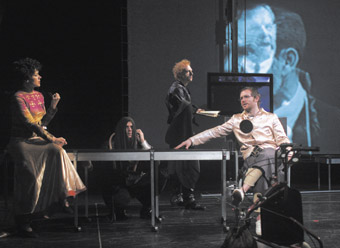
The Wooster Group, Hamlet
photo Paula Court
The Wooster Group, Hamlet
GROWING OUT OF THE CREATIVE AND POLITICAL FERMENT OF THE DOWNTOWN NEW YORK ART SCENE IN THE EARLY 1970S, THE WOOSTER GROUP HAS REMAINED ‘A THEATRE COLLECTIVE’ LONG AFTER AUSTRALIAN GROUPS BORN OF THE SAME IMPULSES SIMPLY GAVE UP THE STRUGGLE AND FADED AWAY (THE AUSTRALIAN PERFORMING GROUP BEING THE MOST OBVIOUS PARALLEL). INDEED, IN THE CONTEMPORARY AUSTRALIAN CONTEXT, THE IDEA OF A ‘COLLECTIVE’ SEEMS ALMOST OUTRÉ, SUGGESTING A PROJECT BOTH NAÏVE AND IDEOLOGICALLY OVER-DETERMINED. BY CONTRAST, THE WOOSTER GROUP HAS MAINTAINED A SENSE OF INTELLECTUAL PLAY AND ENGAGEMENT WHICH READS AS FRESH, VIGOROUS AND UNAFRAID—AND AS RELEVANT TODAY, IN THEIR PRODUCTION OF HAMLET, AS IT WAS WHEN I FIRST SAW THEM IN 1986. FOR MORE THAN 30 YEARS THEY HAVE SUSTAINED AN EXPLORATION OF THE POSSIBLE RELATIONSHIPS BETWEEN PERFORMER, TEXT AND MEDIA TO CREATE AN EXTRAORDINARY BODY OF WORK WHICH HAS BEEN CONSISTENTLY ENTERTAINING AND RIGOROUS.
The Wooster Group’s longevity seems even more remarkable when you consider the company has had only one director—Elizabeth LeCompte—working with a core group of powerful personalities (including Willem Dafoe, Kate Valk, and formerly Ron Vawter and Spalding Gray) and a shifting roster of associates. Taking into account all the mundane problems of maintaining a theatre company, such as ever increasing salaries and production costs and the fickleness of critical fashions, as well as the potentially explosive combination of creative personalities, it’s easy to imagination that either exhaustion or implosion would have put paid to the company a decade ago.
However, the Wooster Group appears to have found a strategy which has allowed a visionary director and a company of strong-willed performers to work together for what for many has been an artistic lifetime—even as one of the core members of the group (Dafoe) has built a career as a mainstream, if minor, Hollywood star. And unlike her contemporaries (Twyla Tharp say, or Arianne Mnouchkine), LeCompte remains relatively in the background: she is clearly a formidable character, but seems content to let the performers be the public face of the company. (Mnouchkine’s shock of grey hair and steely gaze I recall from her watchful presence before and after performances by Theatre du Soleil, but despite interviewing LeCompte in the late 80s, and having had the privilege of seeing the company perform on at least six occasions since then, I cannot for the life of me remember her face!)
The Wooster Group oeuvre includes “nineteen theatre pieces, four dances, three radio plays, five video/film works, and the first eight monologues of Spalding Gray” (www.thewoostergroup.org), and will soon include an opera when they take on Cavalli’s La Didone, via a collision with “Mario Brava’s 1965 cult movie Terrore nello spazio.” The collision of a classic or overburdened theatre text and an obscure ‘cult’ film is a typical starting point for a Wooster Group production. The violent encounter of mediums, performance styles and histories produces the rich multi-modal performance language which defines the company’s style, a hectic, always surprising collaging of personal and public histories, pop cultural references, performance techniques and media.
newly mediated old hamlet
The Wooster’s Hamlet is no exception—but in this case, the cinema text in question is a version of the theatrical text: a rarely seen 1964 film version of a Broadway production of Shakespeare’s Hamlet starring and directed by Richard Burton. A single performance was recorded ‘live’ by 17 cameras and edited into a film that was shown for only two days in 2000 movie houses across the US. It was the first and only example of what the producers conceived as a new form—“Theatrofilm”, made possible through “the miracle of Electronovision.”
The Wooster Group have taken this forgotten ‘theatrofilm’ of Hamlet, and edited it to emphasise the meter of the verse. As a consequence, the whole film loses the illusion of visual seamlessness that editing usually seeks to engender, and the scenes seem held together by jump cuts, with weird elisions between shots. Figures stutter and jump, and frequently vanish altogether, or appear only as ghostly after images, present only as versifying voices.
With this ‘detourned’ film as their text, the Wooster Group then set about a kind of crazed reverse engineering process: “our Hamlet attempts…reconstructing a hypothetical theatre piece from the fragmentary evidence of the edited film, like an archaeologist inferring an improbable temple from a collection of ruins. Channelling the ghost of the legendary 1964 performance, we descend into a kind of madness, intentionally replacing its own spirit with the spirit of another.”
While the result may be a kind of madness, it is far from hypothetical. The Wooster Group’s Hamlet is striking not only for its humour (often slapstick) and its purposeful deconstruction of both text and performance language, but because it gives us, in the end, a deeply satisfying and affecting version of a classic play.
by design
The set up is standard Wooster Group scenography—a raised thrust stage framed by the scaffolding of light and sound rigging. A large screen forms the back of the performance area, and on a pair of a parallel bars running vertically, a decent size flat screen monitor can slide up and down. At the front of the stage, a microphone on a stand and, on another arm coming off the mike stand, a small video camera. Scott Shepherd/Hamlet is the man behind the mike, and the camera relays his image to the monitor which travels up and down a little in front of the large main screen, on which we can see the edited ‘theatrofilm.’ All the performers wear head mikes, and their voices (as well as the voices of Burton and company from the sound track of the film/video) are amplified, affected and moved between various loudspeakers to create precise effects. Sound amplification and the use of spot sound effects (footsteps, various cartoon crashes and bangs) played in live evoke both rock and roll and the Foley effects in film post production.
Indeed, the whole set up is a variation of rock concert typologies, suggesting a kind of travelling show—a medieval mummers’ stage for the 21st century.
While the technical set up is complex (in that obvious rock’n’roll way: nothing is hidden away), the ‘props’ and furnishings are basic—a table with legs of the same light industrial pipe as the rigging has large castors which enable it to be wheeled around with ease, so too the large clunky office chair which serves as throne. There is a rack of clothes (behind which Polonius lurks), and not much else. A couple of other chairs are brought on as needs demand. The set and furniture echo the bare stage and minimalist setting of Burton’s Hamlet, played in modern dress upon an almost empty stage.
the live edit
The performance unfolds as Shepherd (real time image displayed on the monitor) directs the operator to fast forward, or go back, to particular scenes in the 1964 film, projected behind him (there is also a monitor hanging above the stage in front of him, on which he watches the film). The actor on stage attempts to mimic the cadences and action of the on-screen Hamlet—striking the same poses, making the same moves, in the stuttering, jerky rhythms of the edited film. In the first half of the performance, this is largely played for laughs—or at any rate it’s very funny, as the whole company jerks and leaps around reciting Shakespearean verse but acting like poorly co-ordinated marionettes. Mostly we hear the ‘live’ performers, but acoustic traces of Burton’s voices also appear, and it’s not clear in these moments if Shepherd is following or leading the performance. Working with the screen image makes for some wonderful stage craft. To compensate for camera pans, Ninja costumed stage hands move the table and chairs: as, say, the camera pans right, and the table ‘disappears’ out of the left hand frame, the stage hands move the table to the left at the same speed. Likewise, when a jump cut will see an onscreen actor seemingly repeat a gesture, the onstage performer does the same. The result is a company possessed by the flickering shadows of Burton et al.
As if this wasn’t enough, Shepherd also screws with the timeline of the narrative, for example directing the video operator to skip the “get thee to a nunnery” scene only to come back to it later, to pick up the threads of Hamlet’s relationship to Ophelia in a series of back to back scenes at a point he feels is more effective. When the Players arrive (and are instructed by Hamlet) a scene from another film version of Hamlet is cut in, with Charlton Heston as the Player King.
real and fake collapsed
By the beginning of the second half, the sense of novelty has worn off, and the St Vitus Dance of possession has become ‘naturalised’ as the physical language of the piece—which, by the way, has never wavered from a straight, intelligent vocal reading of the text itself—and the play begins to work on other levels. As the actors struggle to make the words and actions of others their own (or, rather, are inhabited against their will by the words and actions of others), they are also making visible the ambiguities of identity, agency, authenticity and dissimulation explored in the play, and which Hamlet himself neurotically embodies. There is no Ghost in this version of Hamlet—rather the actor confronts the ghosts of generations of Hamlets, of which the spectral flickering of the ageless Richard Burton captured by “the miracle of Electronovision” is the most (literally, in this instance) luminous.
At the end of the play, the stage is littered with bodies (at the culmination of a breathtaking ‘real’ stage sword fight), and the images on the screen fade into ‘snow’, the video equivalent of white noise, while the thunderous applause of the taped Broadway audience turns into static, which melds with our own applause. It’s an extraordinary collapse of real and fake, of real time and recorded time, of then and now. And the Wooster Group have once again told us a great story, while minutely examining the nature of theatrical gesture, the relationship between live and cinematic performance, and the role of the actor. And all of it with a light touch, an almost casual sense of play.
The Wooster Group, Hamlet, director Elizabeth LeCompte, performers Scott Shepherd, Kate Valk, Roy Faudree, Ari Fliakos, Daniel Pettrow, Casey Spooner, Judson Williams, space design Ruud van den Akker, lighting design Jennifer Tipton, Gabe Maxson, sound Geoff Abbas, Joby Emmons, Matt Tierney, video Reid Farrington, costume design Claudia Hill, film directed by Richard Burton; St Anne’s Warehouse, Brooklyn, New York, Feb 7-March 25; forthcoming Public Theater, NY, October 2007
RealTime issue #79 June-July 2007 pg. 6
© Tony MacGregor; for permission to reproduce apply to realtime@realtimearts.net
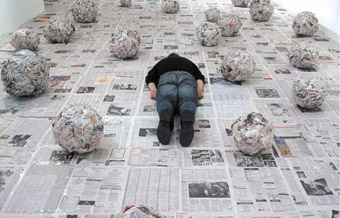
Franz Ehmann, speaking the world into existence, 2005, installation detail
photo Carl Warner
Franz Ehmann, speaking the world into existence, 2005, installation detail
ARTSPACE IS ABOUT TO EXAMINE THE COMPLEX LINKS BETWEEN PERFORMANCE AND INSTALLATION. CURATED BY ARTSPACE DIRECTOR BLAIR FRENCH, AFTERMATH: PERFORMANCE INSTALLATION FEATURES SIX PERFORMANCE ARTISTS—INCLUDING FOUR FROM AUSTRALIA, ONE FROM INDONESIA, AND ONE FROM THE UK. EACH WILL CREATE A PERFORMANCE IN ONE OF THE EXHIBITION ROOMS AND COMPLETE THEIR WORK WITH AN INSTALLATION THAT WILL REMAIN IN THE GALLERY IN THE WEEK FOLLOWING EACH PERFORMANCE, THUS CHALLENGING THE ARTISTS TO PROVIDE PROLIFIC IMPRINTS OF THEIR PERFORMANCES IN THE ENVIRONMENT OF THE EXHIBITION.
The participating artists are Guy Benfield, Anne Graham, Franz Ehmann, Tony Schwensen (all from Australia), Arahmaini (Indonesia), and André Stitt (UK). The weekly performance installations will be followed by performances from Yiorgos Zafiriou and senVoodoo (Fiona McGregor and AñA Wojak) also from Australia. Aftermath concludes with a Symposium in collaboration with Performance Space and RealTime at CarriageWorks. The program will be accompanied by a screening of international performance videos—including recent works from China—hence emphasizing the way performance art is frequently linked to a wide range of media, and paying attention to its inherent re-mediation.
Aftermath offers a welcome investigation of both time-based and spatial notions of performance art, by inviting artists whose works aim to address the enduring interactions between direct encounters with live performances and their intricate links to installation and video art. It thus provides a clear break with some of the more frequently addressed discourses on the post-productive qualities of performance art, particular in photography, which are often treated as mere documentations of the actual performance event, and which have become increasingly popular on the international market in recent years. Instead, Aftermath offers a more profound art historical approach by further tracing connections between performance art and conceptual art including, no doubt, links with Arte Povera and other post-WW II art movements, particular those of the 1960s and 1970s.
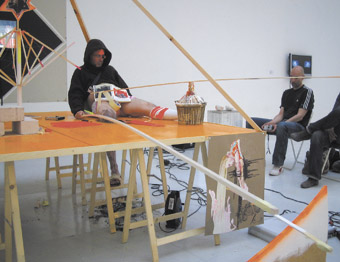
Guy Benfield, Stadium Redux Redux, installation performance, 2006
guy benfield
The first performance-installation will be by Guy Benfield. Titled Maximum Commune (Ugly Business…on the basis of disbelief), it will involve the artist playing out several performance scenarios that trace allegorical notions of ritual, early French and Japanese exchanges in action painting, arte informel, and modernist architecture of the 1960s. By re-animating time-based and culturally embedded style, form and technique, Benfield’s performances often force audiences to contemplate the perversion of collective trends.
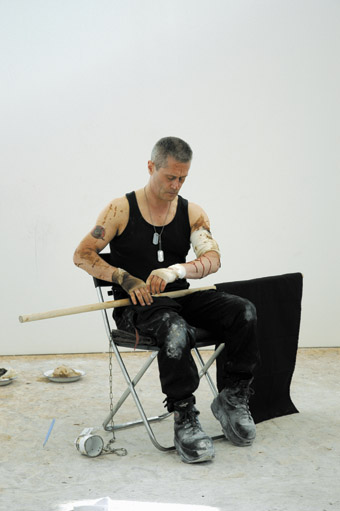
André Stitt, Nostalgia, Baltic Centre for Contemporary Art, Gateshead, UK, 2005
photo Manuel Vason
André Stitt, Nostalgia, Baltic Centre for Contemporary Art, Gateshead, UK, 2005
andré stitt
André Stitt’s performance, Dingo: A treatment towards a new communionism, will without a doubt raise eyebrows in the performance art community (and among some animal-rights activists). Stitt has proposed he be placed in a cage with a dingo, a direct reference to Joseph Beuys’ 1974 ‘coyote’ performance, I Like America, America Likes Me. Aside from providing a ‘communionism’ between Stitt/Dingo and Beuys/Coyote, the work will also invoke social-political and cultural-historic topics, particularly in relation to post-colonial trauma, cultural imperialism, and genocide. It will also be interesting to see how the performance deals with occupational health and safety regulations, animal-rights laws, and public sensibilities that will require a constant renegotiation of the real time performance.
To date it has been announced that Stitt will be “locked in a cage with a dingo at certain times over a three day period” and hence animal friends can be assured the dingo will also have some time off. Stitt’s performance may also address some of the specific issues surrounding the animal which was introduced to Australia by traders from Asia around 3,500-4,000 years ago (whereas the coyote is native to America). The dingo is certainly less of a mythical animal than the coyote, and rather than being seen as a ‘trickster’ it is treated as a ‘menace.’ I wonder if and how these distinctions will be dealt with in Stitt’s paraphrasing of Beuys.
anne graham
Aside from paying attention to re-animation, particular emphases in Aftermath will be directed to the displacement of culturally-embedded practices and daily routines into the gallery space. Anne Graham’s work, In Between Space, will transform Artspace into a residential home, comprising eight rooms: bedroom, kitchen, studio, library, living room, office, and gallery. Throughout the weeklong performance each of the spaces will be occupied and used for everyday activities, thereby instilling both intimate and familiar daily behaviour into the public environment of the exhibition space. Graham’s works provide ongoing research into individual and collective remembrance that becomes visualized in the way people conduct their lives in relation to space. By dislocating some of the clearly defined demarcations of private and public space and place, Graham is able to generate intricate social sculptures in which the audience circumscribes part of the work process.
arahmaiani
Addressing the collaborative aspects of performance art practice, Arahmaiani’s performance-installation, Make-Up or Break-Up, will combine an ongoing investigation into questions surrounding her identity as a female Muslim artist, in conjunction with local communities in Sydney. In preparation for the installation at Artspace, Arahmaiani will instigate the production of wall-sized banners of multinational company logos and brand names translated into Malay-Arabic script. These will be made by local communities and artists for public display.
This work follows on from recent collaborations in Germany, Malaysia, and Thailand addressing the polarization between the image of Islam in the international media and its everyday reality in Islamic communities. By blending Malay-Arabic script with corporate signs Arahmaini’s work will offer a rethinking of the way audiences in different parts of the world perceive culturally embedded symbols, especially following the September 11, 2001 attacks.
franz ehmann
The interaction between symbolism and meaning in relation to language will also be examined in the performance-installation, forever young, by Franz Ehmann. His works frequently offer rites of passage between natural and cultural worlds, making use of everyday objects, including food products and newspapers, which are transformed into ambiguous symbols that are reaffirmed through their use in the gallery space. In forever young, objects will be used as theatre props—a floor laid with a thin membrane of newspapers will form the main stage of the performance, and an interface between linguistic territory and semiotic space.

Guy Benfield, Stadium Redux Redux, installation performance, 2006
tony schwensen
Tony Schwensen will conduct a “hundred hour meditation on stupidity, nationalism, delusionism, the devaluation of manual labour in the Western world both socially and financially, and the rampant and thoughtless consumption that has accompanied it with its manifestations in contemporary Australia” (press release). Many of Schwensen’s works contrast cynical views on contemporary society with a certain optimism about the basic levels of the human condition, reflecting his ongoing interest in the work of Samuel Beckett who will be quoted on one of the walls at Artspace with his new year statement, “Hopes None, Resolutions None”, paraphrased by Schwensen as “Love it or leave it.” During his 100-hour performance Schwensen will conduct a variety of actions around matters of national concern, examining self-proficient solutions, such as in his planned performance of manual and automated water desalination.
yiorgos zafirou
During the final weekend of the Aftermath program performers will investigate the way the body is represented in performance-installations. The first performance is by Yiorgos Zafirou, whose recent work investigates the relationship between performance practice and ritualistic modifications of the body. Titled Malignant Mother, this new work follows on from a performance work of 2004 in which Zafirou had his nipples grafted so that they lost sense and became decorative badges that could be further modified.
senVoodoo
Fiona McGregor and AñA Wojak will present Font, a testimonial performance in which they violate their skin and bleed into a container of water to colour it red. The performances of senVoodoo reinvigorate iconographic displays of desecrated flesh to entice audiences to open their senses to corporeal levels of experience. However rather than delving into ritual their works provide references to more theatrical practices, and reflect on the formation of a “living installation.” Many of their performances are recurring works, held at various sites, and also involve re-mediation in the form of public screenings and video installations.
re-mediation
The way in which attention is given to re-mediation in the production of many contemporary performance works will also be evident in the screenings of performance videos. These will include recent performance art from China, which has attracted increasing attention in the international art world but has been rarely screened in public art venues in Australia. Included are durational performances by Ma Liuming, Zhu Ming, He Yunchang, Sun Yuan & Peng Yu, and Yang Zhichao.
symposium
Aftermath will conclude with an afternoon symposium that will trace some of the art historical discourses of performance art and open up new discussions on the experiences of the events of the preceding weeks. The symposium will involve local artists, scholars, and critics, as well as the two visiting overseas artists in Aftermath, Arahmaini and André Stitt.
Aftermath: Performance Installation, Artspace, July 5- August 18; for program go to www.artspace.org.au
Schwensen and Stitt will also be creating a performance installation at Campbelltown Art Centre in August.
RealTime issue #79 June-July 2007 pg. 8
© Thomas Berghuis; for permission to reproduce apply to realtime@realtimearts.net
A LIVE ART DEVELOPMENT AGENCY. I WISH WE HAD ONE OF THESE IN AUSTRALIA FOR CONTEMPORARY PERFORMANCE. ESPECIALLY NOW THAT THE TIME_PLACE_SPACE LABORATORY HAS BEEN KILLED OFF. ARTS NEW SOUTH WALES HAS GROWN A UNIQUE DANCE-NURTURING RESEARCH LABORATORY, CRITICAL PATH. AUSTRALIAN THEATRE HAS GAINED A FRESHLY ENGINEERED PLAYWRITING AUSTRALIA [POST THE CULLING OF THE AUSTRALIAN NATIONAL PLAYWRIGHTS CENTRE AND PLAYWORKS]. HOPEFULLY PLAYWRITING AUSTRALIA WILL ADDRESS A RANGE OF PERFORMATIVE WRITING [AS PLAYWORKS SOMETIMES DID] IN LINE WITH WHAT CAN NOW BE ACTUALLY EXPERIENCED IN OUR THEATRES AND ART SPACES.
I’m not yearning for a centralising organisation but a facilitating one which can keep artists and companies in the information, inspiration, skills, ideas and touring loops vital to established and emerging work across Australia’s still intimidating distances. England’s Live Art Development Agency (LADA) directed by Lois Keidan and Daniel Brine is an impressive, idiosyncratic example of what a small organisation can achieve as collaborator, conduit and cultivator. It is now going national and has international ambitions.
flourishing & fragile
On our 2006 UK visit the RealTime editors encountered what appeared to be a flourishing contemporary performance ecology entailing live art and experimental theatre. It is supported by LADA; by the networking of Live Art UK, Guardians of Doubt, and the online New Work Network; festivals (National Review of Live Art, Inbetween Time, The Cat Show, SPILL, Fierce); venues (Greenroom, Arnolfini, Bluecoat, Tramway, Tate Modern, Chapter Arts Centre); bursaries and free advisory service (LADA, Arts Admin); book publishing (LADA with various publishers); archives (Live Art Archives, Bristol University, Tate Modern, LADA); strong academic interest (Centre for Performance Research, University of Aberystwyth; Dartington College of Arts, Devon); regional distribution of funding, and a cluster of ‘star’ performers—Bobby Baker, Kira O’Reilly, Curious, Joshua Sofaer, Franko B, Duckie, Pacitti Company, Shunt, Forced Entertainment and related artists, like photographer Manuel Vason.
As remarkably supportive as this all seemed and, in the best sense, institutionalised, we were left in little doubt that it constituted a fragile ecology—small grants, a limited number of responsive venues, a shortage of creative producers, no magazine focused on contemporary performance and little press coverage, the work mostly project-based and created by a multitude of vulnerable often self-subsidising artists. That fragility has become suddenly and brutally real. Arts Council of England Grants for Artists Funding has been cut by 35%, in order to shore up funds for the 2012 London Olympics.
Key live art funding had come principally from the ACE’s visual arts wing but the Live Arts post was recenty axed, “a loss”, writes Daniel Brine, “with serious repercussions.”
Brine reports that “Arts Council funding cuts have already begun to bite within the sector with a number of projects that you would expect to be funded failing to get support.” He worries that “this may not be the end of Grants for Artist cuts as more Lottery money may be allocated to the Olympics in the future, necessitating more cuts. At the same time the arts sector is very pessimistic about the Government’s Comprehensive Spending Review, the outcome of which is due to be announced in the autumn…The existing cuts to Grants for Artists and the potential of further cuts are very serious for our sector because we all depend (probably more than other sectors) on project funding. If there is no change to this funding situation then by 2012 and the Olympics our sector will be stretched very thin indeed.”
everything you need
Back in 1997, at another critical moment, the ICA revamped its renowned live art program. Its curator, Lois Keidan, left and put in a successful tender when the Arts Council of England sought bids for an organisation to provide support for live art. The Live Art Development Agency was set up by Keidan and Catherine Ugwu in 1999 and, since 2001, has been run by Keidan and Daniel Brine, with Andrew Mitchelson joining in 2006 as company and resource manager. Freelance project directors join for the lives of projects. LADA is based in the Rochelle School building on Arnold Circus in Shoreditch, East London.
LADA describes itself as offering “a portfolio of resources, professional development schemes, projects and initiatives for the support and development of live art practices, and discourses in London, the UK and internationally.” It commits “to supporting high risk artists, practices and ideas of contemporary culture and particularly the practices of emerging artists, and artists from culturally diverse backgrounds.”
“Everything is strategic at the Live Art Agency”, says Brine, “especially in curatorial projects…We work by consultation, always through partnerships, we seek a lot of input and offer free advice—without economic barriers.”
The Arts Council of England devolved funds to LADA so it could offer seven bursaries per annum of nine thousand pounds each for an activity, not a finished work, for example Brine tells us, Ernst Fischer took a course in butlering developing his new work on servitude. The funds could also be used to work with a senior artist as mentor. Unfortunately, ACE ceased this funding in 2005. There is 10 thousand pounds for artists to set up training courses for other artists—the DIY progam, 15 projects across the UK including one led by Australian Barbara Campbell.
On the premises there’s the much used and very comfortable Study Room extensively stocked with live art performance on VHS and DVDs, large monitor, books and magazines, including RealTime. There are associated Study Room Guides available on The Body in Performance; Performance, Politics, Ethics and Human Rights; Site and Space In Performance [a guide created by Gregg Whelan of Lone Twin that takes the form of a series of short texts written in response to key works in the Study Room]; Performance and Activism; and, forthcoming, Richard Dedomenici’s guide to performance posted on YouTube, and Socially and Politically Engaged Performances written by Robert Pacitti. Some of the guides can be downloaded from LADA’s website.
LADA’s strategies include joint publishing, practitioner meetings around the country, hosting the Live Art UK consortium, and organising the successful China Live tour and book in 2005, partnered by a number of venues. LADA continues to be involved with Bluecoat artspace in the Liverpool Biennale live art program and has collaborated on the De La Waar performance program, Performance Studies International and, in 2003, in the Live Culture program at the Tate Modern.
recruitment
There’s even a recruitment aspect to the organisation’s program. LADA provides talks and lectures on live art for upper school and university classes. Then there’s Everything You Wanted To Know About Live Art But Were Afraid To Ask, a touring information and advice day aimed at recent graduates, emerging artists and interested persons. For the first time, the tour has gone national in 2007. Everything… is part of Joining the Dots, a Live Art Development Agency professional development initiative for artists across the UK.
expanding niches
LADA’s latest book, Programme Notes, Case Studies for Locating Experimental Theatre, was recently launched by Forced Entertainment’s Tim Etchells at the Fierce Ten Festival in Birmingham. Edited and published by LADA, it’s “about furthering dialogues and collaborations between the theatrical mainstream and artists from the independent sector… [focusing on] models of exciting and innovative relationships at work in different places in the UK.” Using case studies, interviews and essays the book “explores the ways in which contemporary theatre is changing through new relationships between mainstream venues and experimental practices.” It has been devised as a resource for “theatre programmers, artistic directors and venue managers, with the aim of sharing knowledge and stimulating thinking around a broader range of new and emergent theatrical practices.”
LADA sees much of its work as infrastructure building with Live Art UK playing a key role in coordinating and developing a national perspective, commissioning works and “addressing different ways of touring—adapting to situations.”
the word
London-based live art practitioner, writer and teacher Joshua Sofaer ran the Live Art UK critical writing course, Writing for Live Art, for 6 writers meeting on weekends in 2006. New writers are joining the program in 2007. Leading the program is an opportunity, Sofaer told us, to rectify a situation where it “can be impossible to get a review in the ghetto of live art….Many of my peers have never had a review.” The aim of the project has also been to provide brokerage so that the writers’ work can be placed, given publishing opportunities are few. Daniel Brine reports that, to this end, Live Art UK recently held a meeting with editors and writers from Frieze, A-N, Total Theatre, Guardian, Wire and Dance Theatre Journal.
Another Live Art UK initiative is the Live Art Almanac, to be published in May 2008 by LADA and Live Art UK with financial support from the University of Leeds. Editor Phil Stanier and his team will gather together “the most engaging, provocative, thoughtful writing about live art and the cultural landscape in which it is set.”
Sofaer attributes the visibility of live art to the vision and hard work of the Live Art Agency’s Lois Keidan, but getting the term into common parlance has been difficult, he said. Sofaer’s five-minute video, What is Live Art? was made for public distribution during Live Culture. He also made a box of instructions for DIY Live Art, the Performance Pack, for the Live Art Development Agency and Tate Interpretation and Education in 2004. The limited edition quickly sold out. RealTime holds one box on behalf of the Live Art Development Agency for use by Australian artists.
event creation
As well, LADA produces forums and events for other organisations. In March this year it was commissioned by Tanzquartier Vienna to create a three-day live art program, Performing Rights Vienna, featuring performances, presentations, debates, workshops, screenings and interventions about the relationships between performance and human rights and between art and activism and will create a similar program for the 2008 NRLA in Glasgow. In April this year LADA collaborated on a symposium for the SPILL festival in London.
books and burnings
LADA sells book, DVDs and other materials through its online sales wing, Unbound. Brine says it’s not going to make LADA a lot of money but that it’s been well received, “in particular, we have been surprised by the very good international response. Our next step is to begin to focus more and more on self-publishing and we are very keen to develop a market for DVDs from artists and burnt on demand.”
going international
“Over the next twelve months”, writes Brine, “we plan to work on our international strategy. We are developing Live Art Unpacked, which is the working title for a tool kit for international promoters and venues consisting of workshops, lectures, screening programmes, The Performance Pack and DIY projects. We think there will be two versions: Live Art Flat Pack (easy-assemble without our presence) and Live Art Development Agency in Residence (our formats and programs and us making them work in local situations).
how it’s done
I wonder about the division of labour that makes all this prodigious effort workable. Brine replies, “Lois and I have been working together for over five years now and we’ve developed a collaborative working method that works well for us. Basically, we both do everything together although there will be times or situations when one or the other will take the lead. Andrew has been a fantastic addition and he makes sure things run smoothly, especially the Study Room, Unbound and our financial records.”
The Live Art Agency does all the above and more, making the most of partnerships and building on and expanding networks, fuelling (and being fuelled by) live art and experimental theatre artists, and bringing new blood and mainstream venues into play. And it’s not about power, but about enabling and, yes, everything is strategic.
Live Art Development Agency,
www.thisisliveart.co.uk
www.thisisunbound.co.uk
RealTime issue #79 June-July 2007 pg.
© Keith Gallasch; for permission to reproduce apply to realtime@realtimearts.net
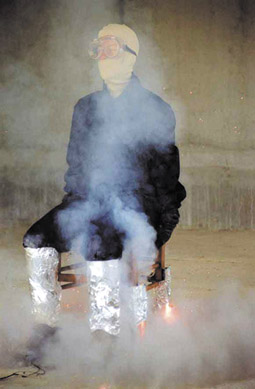
Gwendoline Robin; NRLA2007
photo Pierre Laborde
Gwendoline Robin; NRLA2007
NOWADAYS FIREWORKS REGULARLY BOOK-END ALL KINDS OF FESTIVALS, SENDING UP A WHOOSH! OF EXPECTATION AT THE START AND A WHIZZ-BANG OF ‘WASN’T THAT GREAT?’ AT THE END. BUT, TRUE TO TYPE, THE NATIONAL REVIEW OF LIVE ART 2007 OPENED AND CLOSED ON AN OUTBURST OF THOROUGHLY UNTOWARD PYROTECHNICS. ON A GRIMLY NIPPY FEBRUARY NIGHT, A DUTIFUL AUDIENCE TROOPED OUTSIDE TO THE GARDEN AREA BEHIND GLASGOW’S TRAMWAY COMPLEX. AND THERE THEY WAITED. REGISTERED THE ARRIVAL OF A FIGURE IN WHAT LOOKED LIKE A WHITE SPACE-SUIT. MAYBE THOUGHT ‘HEALTH AND SAFETY’ AS THEY TOOK IN HER PROTECTIVE CLOTHI…OH MY GOD—A LIGHTED FUSE. A SWIFT-FIZZING RUSH OF SHOOTING SPARKS, HALO-ING A HUMAN FIREWORK. AND WE LAUGHED LIKE CRAZY CHILDREN AND CHEERED THE BELGIAN ARTIST GWENDOLINE ROBIN AND TROOPED INSIDE AGAIN, CONFIDENT THAT THE FIVE DAYS THAT LAY AHEAD WOULD BE CRAMMED FULL OF METAPHYSICAL SQUIBS AND FIRE-CRACKER CHALLENGES AND PEOPLE DOING RECKLESS STUFF OF THE ‘DON’T TRY THIS AT HOME’ VARIETY.
Afterwards, as the smoke cleared, the resonances of Robin’s work started to take disconcerting hold: nudged aside the hip-hooray sideshow effect and threw up other incendiary images—the suicide bombers, the self-immolaters who torch themselves in protest, the blazing victims of napalm attacks. By the time Robin ended NRLA 2007 with another risk-taking act of self-ignition, all manner of performances—some very still, others verging on the hyperactive—had echoed her flair for twisting the everyday into the unexpected. Had, like Robin, startled us into laughing, before choking the laugh in our throat with a sudden image of pillaged societies or humanity at bay.
Unlike Robin’s Instant no 6899, however, some of the most shattering and thought-provoking pieces made powerful use of still, small voices to whisper of lives pillaged by injustices and oppression. Indeed, Chumpon Apisuk (from Thailand) called his first action Silence. Long before Apisuk was even half-way through his performance, we had cottoned on to the rhythm and intensity of a reverencing ritual dedicated to those whose human rights had been violated in his native land and beyond. Even so, there was no foreseeing the litmus shadings of grief and respect that filtered across his face as he addressed the twenty or so knives arranged down both sides of a dinner table, bowing as he placed his cheek against each blade before placing it on the newspapered floor. No names were ever spoken. The newspapers became shrouds, or maybe just the wrapping for discarded detritus…the little bundles looked like bodies destined for unmarked graves. Apisuk’s Silence built into a visual scream of outrage and reproach without one word of a rant. It continues to haunt me.
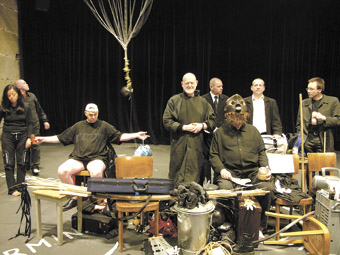
Black Market International “Actuation” reproduced with permission of BMI
So do certain fragments from the productive melange of ‘collision and collusion’ that arose from the five day residency by Black Market International (BMI), a multi-talented collective of international artists who turn up with various props and processes and then morph into an ad hoc ideas factory. Lee Wen, for instance, took to barrelling out of BMI’s designated space—a vast, white hanger-like gallery—and buffeting through the foyer crowds, his half-naked wiry frame encased in a raggedy tent, like some refugee snail. You had to smile. He looked ridiculous. But then the awful pathos of his mute wanderings between laden cafe tables and among our camera-toting, mobile-phoning ranks stopped being funny. And you knew he knew that—in real life, if not at the NRLA—you probably turned away from such silently accusing images.
Alastair MacLennan’s continuous 24 hour action saw flowers wither away in a greenhouse where the floor was strewn with unfinished shoes. Nearby, a burnt-out car gradually silted up with rusting mechanical debris while its exterior became host to photographs of endangered species—a paper trail of flimsy white footprints leading from the greenhouse hinted at man as the user and abuser: indeed he was occasionally present in the driving seat of the useless vehicle, going nowhere but still hell-bent on ignoring all the warning signs around him. Again, there was no morally superior spoken diatribe to kickstart our consciences—only an eloquent juxtaposition of objects and actions.
A recent trip to a post-Tsunami Sri Lanka had certainly proved something of a cultural eye-opener for Ian Smith, a thoughtfully mischievous interventionist of longstanding and NRLA’s genially suave MC. His video installation, Médecins Sans Frontières, presented him as a talking head in a bed strewn with tabloid clippings, all trumpeting of a Britain awash with street crime, domestic violence and racist bullying. You had to move close up, to catch Smith’s sickbed musings on his Sri Lanka experiences—especially the acts of kindness and caring from impoverished strangers who were, themselves, the needy victims of earthquake, flood and devastation. Humorous, mostly at the expense of his own attitudes and expectations, this was a soft-spoken, needle-sharp reminder of what is best meant, and achieved, by common humanity.
Elsewhere, Marie Cool padded silently through the dimly-lit reaches of Tramway 4, reiterating her exquisitely simple tasks—letting a flame travel along a length of thread, animating sheets of white paper with gentle exhalations of breath or the passing wake of her own moving body—until she had drawn her circle of onlookers into an oasis of meditative calm. Cool’s demeanour is that of a sweetly grave, if solitary, child who is possessed of a wide-eyed, lateral imagination and an uncanny degree of physical poise: it’s a combination that can make inanimate objects come alive and time pass… at… other-worldy… speeds. Bliss.
Marcia Farquhar has so far clocked up 49 action-packed years—she has the anecdotes, and the wardrobe, to prove it. Hers is not actually a still, small voice. She’s too succulent and exuberant an individual to be caught muttering or lost for words. But her funny, feisty solo show, in which she modelled her past—with a running commentary on the where, when and why of each frock—proved to be a surprisingly touching essay on the socio-political side to fashion and how we cloak our vulnerabilities by dressing up, or down. Sheila Ghelani and Jenny Edbrooke—emerging artists beginning to gain profile and experience—were outstanding examples of how you can air chewy, underbelly issues of identity without standing on a soapbox, hollering your politics to rapidly vanishing backs. For her solo, What Goes Up Must Come Down, Edbrooke had her back to the wall with thighs splayed around a tin bucket. Think coconut shy—oh look! there’s a table piled with coins, a carrot, bottles of booze, condoms, a turkey baster… objects rife with sexual innuendo that we were invited to lob at her bucket-crotch. Har-de-har-har, what a hoot—until the punchline, when Edbrooke asked, brightly, if we’d like to stay in touch with her? Message received, loud and clear, Jenny.
Sheila Ghelani’s message was one of love—between her parents—and pride, her own, in being a product of a mixed race marriage. Her method involved the ritualistic halving of red and green apples, then melding the two varieties into wittily decorated mythic hybrids—the Cyborg, the Griffin and so forth. Her ‘apple-parentage’ was rich with mixed spices, sparkles and, at its heart, a drop of her own blood. Such a gentle, whimsical way of leading up to her closing statement, an affirmation of her joy at being born out of two cultures.
Across the five days voices were, of course, raised in stentorian banshee protests. Glass was smashed, bodies bruised and made to bleed, as performers vehemently denounced the evils of their choice: cultural imperialism, the war in Iraq, bigotry and discrimination—racial, religious, sexist—were the usual suspects and some very powerful work arose from these concerns. But not every memorable firework was a rocket or a banger—many of the brightest sparks chose to ignite our hearts and minds by the depths of their silence.
National Review of Live Art, Tramway, Glasgow, February 7-11, www.newmoves.co.uk
RealTime issue #79 June-July 2007 pg. 12
© Mary Brennan; for permission to reproduce apply to realtime@realtimearts.net
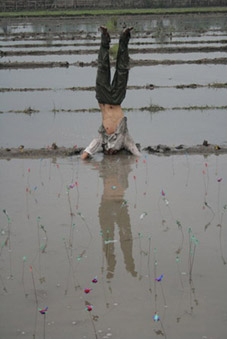
I Gede Made Surya Darma (Indonesia – Bali)
photo Dolly
I Gede Made Surya Darma (Indonesia – Bali)
LOCATION: GEMBLANGAN VILLAGE, BANTUL, YOGYAKARTA, INDONESIA. PURPOSE: TO CREATE A TEMPORARY ART VILLAGE IN THE SPIRIT OF SOLIDARITY AND SPIRITUAL RENEWAL AFTER LAST YEAR’S DEVASTATING EARTHQUAKE.
Organisers: The Performanceklub, a group of local artists committed to bringing art out of conventional art spaces into public places. They have developed a close relationship with the people of Gemblangan since carrying out volunteer relief work there.
Performance Map: The tiny village is a circular island surrounded on all sides by rice paddies. A path follows the small river (irrigation channel) around the perimeter of the circle. Only two roads cross in the centre of the village. The mosque and cemetery guard the back road into the village. The Jamu House (jamu is a traditional medicinal drink) stands at the main entrance. (This village is also famous for cobra-snake medicine). Rebuild-ing is going on all around but many families are still living in the ruins of their old houses in bamboo shacks provided by aid organizations.
Program: Artist performances, traditional local performances, seminars on organic farming, recycling, first aid, cultural and spiritual values, an excursion to Borobodur Buddhist temple, a dangdut concert finale (popular sexy Indo-Arabic music).
Village Hosts: House and feed over sixty artists and volunteers for five days. Mr Gyanto (Mr Jamu) is the main mover and shaker. Plus the women’s food collective, security, other volunteers, billets.
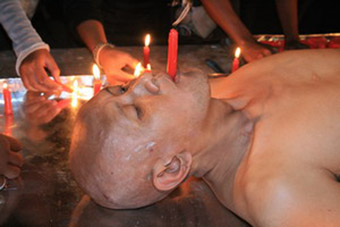
W. Christiawan (Indonesia – Bandung)
photo Dolly
W. Christiawan (Indonesia – Bandung)
day 1
11am. Traditional Welcome: Local dignitaries including Bantul Regent, Mr Idam Samawi, and guests arrive. All the villagers in traditional dress line the roads. Village men sing and play traditional Islamic songs. Mr Samawi gives a passionate speech—Bantul says no to malls and globalisation! Visiting artists are brought to the stage and given a plain coloured flag to use in their performance.
1pm. Traditional Performance: Jathilan—young boys in gaudy costume, makeup and riding toy horses perform traditional trance dances that go on for several hours. The whole village attends. The trance master is particularly fascinating. One of the international artists accidentally goes into trance. The trance master is called away to assist. A crowd follows. She recovers, with a bad headache.
5pm. Location Meeting: Artists decide on location and time of performance. Volunteers draw up map and timetable.
9pm Gejong Lesung: Traditional music shows about the history of the land by women from a neighbouring village.
day 2
11am. Seminar: Importance of cultural and spiritual values in maintaining independence/autonomy in a global world. The head of local Islamic boarding school, Mr Djawis, a former Minister for Culture, Mr Marzuki and myself discuss spirituality, tourism, economics and performance.
3pm: Art Performances begin. Lewis Gesner, USA, 2 hours, all around the village. Arrives with a ball of string and a pair of scissors, walks, collects objects, ties them to string, ties other end to his leg, walks slowly again, collecting and dragging objects behind him.
3.20pm. Maya Pasternak, Canada/Tel Aviv, video interviews with villagers as they work, continuous over 3 days. Begins in southeast part of the village.
3.45pm. I Gede Made Surya Darma, Bali, walks into the fallow rice paddy near Jamu house carrying bunches of plastic flowers. On closer examination we see they are small toy soldiers, tanks and planes on long stalks. He plants each stalk slowly and methodically in lines. After a while others wade into the water to help. When all are planted he “plants” himself by standing on his head on the paddy bank.
4.10pm. Harumi Tereo, Japan, south end of village, places coloured squares of paper on the low wall next to irrigation channel. Rearranges them, using only her toes. Lies down on them and performs “a feet, arms and hand dance”, changing position from front to back and side to side.
4.30pm. Mayumi Ishino, Japan/New York, on the west side of the village in the cow and sheep corral. Draws a self-portrait on a mirror hung on a tree trunk. Animals baa and moaaah in chorus. When she has finished the portrait she takes out a hammer and smashes it. Then walks away with it under her arm. She repeats this every day in different locations with a finale of four or five in a row in a central location near the kitchen.
4.50pm. Bruno Mercet, France, next to a villager’s house on south west corner. Bruno wears only his flag around his waist. It doesn’t quite cover all of him. Organisers go into a slight flurry. It’s not kosher to be naked in a Muslim village. But no one is bothered. He’s a westerner after all. He plays with an old door, climbing in and around and through it then writes a greeting to his host on the top of the door. His host, a tiny old lady, laughs a toothless smile.
5.00pm. Huang Ming Chi (Mickey), Taiwan, at a house near the crossroad gives a massage to a village woman. She waits at the door telling the audience she won’t start until exactly 5pm. She sets her timer and leaves it outside the house. She enters, gives the massage for allotted time and leaves when timer goes off. She does an activity like this each day with a villager; helps in rice fields and in the collective kitchen.
And So On Into The Night, followed at 9pm by a Dzikir Saman—a religious show of song and dance.
Days 3, 4, Continue As Above: same daily schedule with works from other international and local performance artists: China—ShaoYan Xin, Qing Sheng Ming, Wang Jian; Surabaya—Illham J, Bidai, Aye Ko; Jakarta—Santo Clingon; Bali—I Kadek Dedy Sumantra Yasa; Japan—Shinya Misawa, Seiji Shimoda, Makoto Maruyama, Sakiko Yamaoka, Yoshie Baba; Yogyakarta—Sindu Cutter, Emilia White, Bocor Alus Group, Buyung Mentari, Ronald Apriyan, Lepan, Rachel Saraswati, Yudha Coklat, Iwan Wijono, Arahmaiani; Australia—Patrick O’Brien, Jan Cornall; Bandung—Ferial Affif, Isa Perkasa, Deden Sambas, W Christiawan; Singapore—Lee Wen, Jeremy Hiah, Kai Lam, Agnes Yit; Solo—Choiri, Satriana Didik, Ozy; Myanmar—Aye Ko.
Audience Response: Many of the villagers are quick to engage with the performances—joining in and helping out with props and logistics. Audience from Yogyakarta come and go—more there in the evenings. A moving feast of press and avid documenters follow like a paparazzi pack.
day 4
An Unexpected Performance Event. On Day 3 an elderly lady of the village dies. We go to pay our respects. On Day 4, prayers are sung across the village all morning. Masses of people arrive from other villages. We are invited to take part in the funeral procession. Lewis and Bruno help carry the coffin and myself, Mickey, Agnes and Maya, with young village women, carry flower petals, flower water, stakes and banana leaf parcels to the grave side.
day 5
Excursions to Borobodur and Parangtritis Beach
2pm. Final Session. Villagers and artists agree it has been a valuable and unforgettable experience. Visiting artists thank their hosts and promise to return.
5pm. Performance by Sangar Rumah Kardus & Andi O. Earthquake Victims Kids Group.
9pm. Dangdut Concert Finale. Draws an audience from surrounding villages. Westerners learn some sexy moves from the Dangdut Divas. Retire to the Green Room (Jamu House) when they can dance no more and see in the dawn over the rice paddies before catching flights home.
post festiva
l
In an email a few days later from the USA, Lewis Gesner summed it up beautifully. “Placing performance art in a cultural setting of traditional music and dance and a physical setting of a village on the cusp of globalisation was a brilliant construction…for moving forward positively as people and neighbours in a world that is becoming an increasingly smaller village, for better, or worse. Perfurbance#3 pointed to a better village, and hurray for that!”
Perfurbance #3, Yogyakarta, Indonesia, April 25-29
RealTime issue #79 June-July 2007 pg. 14
© Jan Cornall; for permission to reproduce apply to realtime@realtimearts.net

Swingers
AT A TIME WHEN THE FUTURE OF THE TRADITIONAL FILM FESTIVAL IS A MATTER OF SOME DEBATE, TWO OF AUSTRALIA’S NEWEST FESTIVALS ARE FORGING AHEAD. WHILE ADELAIDE HAS JUST SEEN ITS MOST SUCCESSFUL EVENT BOTH CRITICALLY AND IN TERMS OF ATTENDANCE, PERTH’S REVELATION FILM FESTIVAL IS ABOUT TO CELEBRATE ITS 10TH BIRTHDAY WITH A LARGER AND EVEN MORE INNOVATIVE PROGRAM, MORE FILMS AND A NEW ARTISTIC DIRECTOR. MEGAN SPENCER, DOCUMENTARY MAKER (LOVESTRUCK: WRESTLING’S NO. 1 FAN; RT78, p20) AND FILM CRITIC FOR TV AND RADIO, HAS LEAPT ENTHUSIASTICALLY INTO THE TASK OF KEEPING REV ONE OF THE MOST IMAGINATIVE AND CHALLENGING ANNUAL EVENTS ON THE SCREEN CULTURE CALENDAR.
While the more established film festivals are trying to adapt to new ways of looking at cinema, and still grappling with the rather delicate balancing act of satisfying their older, subscriber-based audiences with more traditional offerings while attracting the very necessary newer and younger audience with diverse and provocative programming, younger festivals don’t have this challenge. Their audiences are risk-taking, attracted by innovation; these events can grow organically with their audiences, can enjoy the new ways of both making and experiencing the moving image.
Unlike the larger and more traditional film festivals, which developed naturally from the film society movements or from a city or a community’s need for such an event, the Revelation festival emerged from a desire to screen underground films from all over the world, and a need to take cinema into different environments. Now the event is very healthy; it has state and federal government support through Screenwest and the Australian Film Commission, triennial funding, and a strong sponsorship base.
Rev began in 1997 as an underground event in a basement, Perth’s smoothest jazz venue, where it screened everything on 16mm and included live music and poetry. On its tenth anniversary—titled Revolution. Retrospective. Revelation—Rev will screen around 100 features, documentaries and short films, as well as music videos and experimental work, include a late-licensed festival club and other music and film related activities, and present them at both established cinemas and at nightclub venues. Rev hasn’t abandoned its underground beginnings: Cinema Tabu will present a microcinema showcase of strange films from around the world in a bar environment. Brent Hoff from San Francisco is editor of Wholphin DVD Magazine (an offshoot of cool literary journal, McSweeney’s) and gathers together rare and unseen films to release on DVD. He will screen a selection of these as part of Cinema Tabu.
Already a filmmaker and reviewer, Spencer hadn’t been planning to look for a job as artistic director of a film festival. When she actually considered accepting such a role, however, she realised that every experience she’d had “coalesces and becomes relevant. I’ve got the benefit of being a filmmaker, and of knowing what filmmakers want and hope to get from a film festival. And I’ve seen thousands of films. I’m aware of the cultural and critical connections. I understand the lie of the land and I think I know what to program for the audience to connect with.” And, she says, becoming artistic director of Rev is really a natural progression. “I’ve cheered it on as an exciting new event, I’ve had films screened there, I came over to Perth twice with SBS’s Movie Show. I think I understand what the audience wants.”
Unlike most festival directors, she hasn’t been able to travel to overseas festivals to put her program together. Instead, she’s been programming from the internet, through other festival websites, festival reviews, and the many new avenues offered (“MySpace has been a very good source”), while Rev’s growing identity has, of course, made it attractive, with over 500 films submitted for selection from local and international filmmakers. Working closely with Rev founder Richard Sowada (now Head of Film Programs for the Australian Centre of the Moving Image in Melbourne, but still chairman of the Rev board and very involved) in choosing films, she’s particularly excited about the queer cinema strand, which includes John Waters’ Pink Flamingos (1972), Anna Biller’s Viva (2006; a parody of 60s sexploitation films) and Mary Jordan’s documentary, Jack Smith and the Destruction of Atlantis. “I’d never heard of him—I was just stunned when I saw the film. It’s amazing when you discover someone like that, and other filmmakers fall into place.”
Spencer hopes the activist strand will encourage at least some audience members to, well, become active and do something. There’s Iraq For Sale (2006) by Outfoxed (2004) director Robert Greenwald, on war profiteering; God’s Ways, by German filmmaker Evan Neymann, on two street kids in Odessa; and Soft Words, an Australian short film by Adrian Francis on political spin about asylum seekers and how it abuses language. Rev’s strong documentary strand this year includes something Megan Spencer is particularly excited about: a mini-retrospective of the work of famed documentary-makers the Maysles brothers, with two short films showing Truman Capote and Marlon Brando in a fresh and unexpected light.
Super 8—that little film gauge that just won’t go away—is the surprise element in Rev’s 10th birthday, forming the basis of the new film competition, Revel-8. (“The more we go forward in time, the more incandescent Super 8 becomes”, comments Spencer.) Former director of Perth’s lost and lamented Pandora’s Box Super 8 Film Festival and ECU lecturer Keith Smith takes charge of this new event celebrating the fusion of image and sound, inviting both experienced and novice filmmakers resident in WA to participate. “Super 8 is the original DIY medium and is still finding new devotees after 40 years of glorious imaging. It’s not just the unique look, there’s something magical about working on Super 8 which brings out a special creativity”, he explains. Filmmakers are challenged to make a silent, unprocessed film, edited-in-camera, on a single Super 8 cartridge, lasting just three and a half minutes, on the theme, “Birthday”, using an experimental, animation, drama or documentary approach. Then the best 20 films will be scored by composers at the WA Academy of the Performing Arts and screened in a 5000W flickfest at the Rev Club on Friday July 20, with lots of creative and genre prizes on offer.
A major element of the festival is the Screen Conference, which was initiated last year as a space for filmmakers and those involved in many aspects of the film industry to discuss and workshop a range of related issues. This year the conference has grown, and its guest list includes representatives from the international distribution scene, local and international filmmakers, composers, editors, cinematographers and writers. Featured conversations, masterclasses and workshops include two sessions on HD Heaven (a masterclass with Toby Oliver ACS, on working with HD); Art of the Music Video, with both an international and local focus; The Art of the Short Film; Loving the Alien: The Relationship Between Documentary Filmmaker and Subject; Shedding Light: Performance For Screen; and DIY or Die on digital filmmaking and alternate modes of exhibition and distribution.
Special festival guest and anime proponent Phillip Brophy will be presenting Tezuka: From Manga to Anime, on how Osamu Tezuka transformed his manga into anime. Rev is screening Brophy’s curated program, Focus on Tezuka (already seen at the Art Gallery of NSW and ACMI), with its kids’ flicks component of Astro Boy and Kimba The White Lion, and five fantastic adult animations. Brophy will also be represented in his filmmaker and sound design artist mode; during the festival he’ll be performing The Planets, a remixed presentation of his exquisite cinema scores live, and screening his Evaporated Music series of big-budget, high-gloss video clip images reworked to monstrously alien sound. And his notorious sci-fi horror comedy from 1993, Body Melt, will have a rare screening.
Strange Culture (2007) is a convention-defying documentary by Lynn Hershman Leeson which screened earlier this year at the Sundance and Berlin Film Festivals. It documents the extremely paranoid reaction of US security authorities in the case of internationally acclaimed artist and professor Steve Kurtz when his wife Hope died in her sleep of heart failure. Police arrived, became suspicious of Kurtz’s art, and called the FBI. Within hours the artist was detained as a suspected ‘bioterrorist’, his computers, manuscripts, books, his cat, and even his wife’s body were impounded, and he still awaits a trial date. While Strange Culture manages to reinvent an old form while telling an urgently topical story, what makes it even more memorable is that the Sundance Film Festival screened the documentary in Second Life, the first feature film to be screened on the online community. Rev will not only be screening the film, but will also include a panel on Second Life as part of the Screen Conference—Second Life and Beyond: Virtual Communities and Making Media in a Digital World, organised by Mick Broderick.
Megan Spencer hopes that her first festival will continue the great work that Richard Sowada has done in making Rev a very distinctive event. Sowada himself is cautious about the future for film festivals: “a not-for-profit event has to exist in an exhibition culture that’s commercially based, that’s totally geared to making money. Rev is all about audience development, and that’s a very difficult area to navigate right now.” Spencer thinks that “what makes Rev special is that it opens up a dialogue with the individual filmmaker, and brings in people from all aspects of filmmaking. What I’m trying to do is blur it all: see how digital culture is affecting film, how much feature film has taken from music video—and vice versa. It’s important to recognize what’s going on, and to discuss and debate it. I believe in plugging film into film culture, rather than the industry, and I think that’s what Rev does.”
Revelation Perth International Film Festival 2007, July 12-22, www.revelationfilmfest.org
RealTime issue #79 June-July 2007 pg. 21
© Tina Kaufman; for permission to reproduce apply to realtime@realtimearts.net
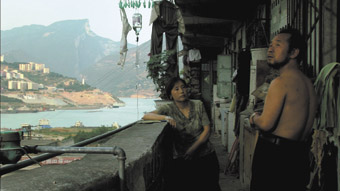
Jia Zhangke, Still Life
AFTER TAKING OUT THE GOLDEN LION AT VENICE LAST YEAR AND THE JURY PRIZE AT ADELAIDE IN MARCH, JIA ZHANG-KE’S STILL LIFE PROMISES TO BE A HIGHLIGHT OF THE UPCOMING SYDNEY FILM FESTIVAL. RELATIVELY UNKNOWN OUTSIDE THE FESTIVAL CIRCUIT HERE IN AUSTRALIA, JIA IS ONE OF CHINA’S KEY ‘SIXTH GENERATION’ FILMMAKERS, A GROUP WHO CAME OF AGE DURING CHINA’S TUMULTUOUS TRANSITION FROM ISOLATED COMMUNIST STATE TO MARKET-DRIVEN INDUSTRIAL POWERHOUSE. JIA IS NOT CONCERNED WITH CHINA’S ECONOMIC SUCCESS HOWEVER—HIS OEUVRE OF FIVE FEATURES TRACES THE FALLOUT OF CHINA’S TRANSFORMATION FOR THOSE LIVING ON THE SOCIAL AND GEOGRAPHIC PERIPHERY OF THE PEOPLE’S REPUBLIC.
Jia grew up in the remote provincial town of Fenyang in Shanxi province, where his Beijing family was deported during the Cultural Revolution. After studying in the capital, the director returned to Fenyang to make his debut feature Xiao Wu (aka Pickpocket) in 1997, a brazenly original work that represented a marked break with the stately historical epics of ‘fifth generation’ Chinese directors like Chen Kaige. Shot entirely on location on 16mm film for very little money, Xiao Wu traces the misadventures of the eponymous ‘hero’, a petty thief who in the course of the story manages to be rejected by one of his childhood friends, become estranged from his family, and lose his girlfriend. Caught stealing a wallet from a street stall customer when his beeper goes off at exactly the wrong moment, Xiao is arrested and ends the film handcuffed to a telegraph pole. He crouches in the busy street, hunched and looking like he wishes he could disappear into the pavement. Suddenly, the camera executes a 180 degree turn, revealing a very real crowd of curious onlookers. Some stare at the chained actor, but most look questioningly straight at the camera. They shift uncomfortably from one foot to another under the camera’s gaze, or chat nervously, occasionally glancing around as if hoping for an explanation of the strange scene before them. Jia holds the shot for what seems like an eternity before an abrupt cut to the end credits.
This startling final shot ruptures the diegetic world of the drama, whose borders have already been blurred by the glances of passers-by at the camera as it follows Xiao Wu through the streets of Fenyang. Is Jia turning his lens on the ‘new China’ and its indifference towards those left by the wayside on the road to material affluence? Or is he forcing the viewer to confront the reality of a country so long seen only through stereotypes perpetuated by both Chinese and Western governments? For me these final moments feel like a profoundly unsettling inversion of the camera’s gaze, a chance for the ‘Other’ to return my voyeuristic interest in China and its people, in the process calling into question my entire relationship to the world depicted on screen. No doubt Chinese viewers bring a whole different set of cultural baggage to their reading of the shot. In any case, Xiao Wu set the template for Jia’s conclusions, which invariably turn on an unexpected though usually understated event, or a sudden shift in tone, that forces the viewer to reassess everything the film has shown us to that point.
Since Xiao Wu, the director has explored a range of different styles, from the circuitous historical sweep of his second feature Platform (2000) to the mixture of live action and animation in The World (2004). Like Xiao Wu, Platform and its follow-up, Unknown Pleasures (2002) were set in Fenyang, while The World takes place in a theme park on the outskirts of Beijing. But even when his setting is the capital, Jia remains concerned with those on the periphery—historical bystanders living in the slipstream of immense economic and political forces over which they have no control.
China’s opening up and the subsequent influx of fashion, pop culture and media images means Jia’s characters are acutely aware of the possibilities of the outside world, but they also know that by and large these possibilities remain out of their reach. Platform, for example, follows the lives of a troupe of travelling performers through the 1980s. Despite the great changes they experience in the course of that decade, the main characters end up trapped in the same provincial setting from which they start. The sense of frustration and hopelessness this situation engenders is graphically depicted in The World, set in Beijing’s Five Continents theme park which comprises miniature versions of famous sites from around the globe, including the Manhattan skyline, the Eiffel Tower and the Taj Mahal. The park workers move between ‘countries’, performing dances in a variety of national costumes for cashed-up tourists, yet they themselves lack the means to really engage with the life of the city outside, let alone travel to the exotic destinations represented in the park. One poignant scene sees the main character, Tao, chatting to a young labourer on a building site. They pause in their conversation as a jet airliner passes over head. “Tao”, the labourer asks, “who flies on those planes?” She shrugs and replies, “Who knows…I don’t know anybody who has ever been on a plane.”
It’s not just economics, however, that see the men and women of Jia’s films excluded from the opportunities of the new China—they are also psychologically and philosophically unprepared to deal with what’s required to survive in an individualised world of ever accelerating change. They usually cling to relationships in an attempt to provide an element of certainty in their lives, but love and sex are rendered as transient as all other connections in the new economic order. Xiao Wu’s girlfriend clings to him determinedly when he visits her in the karaoke bar where she works, yet she later leaves town with a rich client without even saying goodbye. In The World, Tao’s boyfriend is convinced they will split up if Tao finds someone ‘better’, but it is he whose interest is later diverted by a chic clothes designer. “You’re my whole life”, Tao tells him as they share a post-coital moment in a hotel. “If you’re unfaithful I’ll be left with nothing.” To which he calmly replies “You can’t count on anyone that much these days, including me.”
In his portrait of people attempting to find a way to live in a world without stable familial, economic or social ties, Jia’s films share many common thematic concerns with the work of Michelangelo Antonioni. Indeed, parts of Still Life feel like a homage to the Italian director, particularly the way Jia films the setting of the Three Gorges region, where the construction of the world’s largest dam has seen millions of people displaced as entire cities are demolished and rebuilt above the new waterline. The central figures of Still Life move like somnambulants through a riverside landscape of rubble, buildings half-constructed or half-demolished (it’s impossible to tell which), and bridges over waterless depressions. Like the incomplete Roman suburbs of Antonioni’s L’Eclisse (1962) this is a zone of indeterminate purpose, where immense changes are clearly occurring, while at the same time history—and any social or cultural foundation it might provide—seems to have been completely erased. The old world has been obliterated, but its replacement has yet to take shape, leaving a population wandering in a landscape without bearings.
It’s no coincidence that China has thrown up a filmmaker like Jia Zhang-Ke at a time when the country is emerging from decades of intense trauma and upheaval, embarking on a future that promises much but is also further destabilising the existing social order. But Jia’s films don’t just tell us something about contemporary China. The People’s Republic has experienced a more intense version of the market-driven revolution that has affected all of us in the past 20 years, creating a globalised space that has brought images of consumer riches tantalisingly close to much of the world’s population, even as those riches remain, in reality, as inaccessible as ever for many. When we’re hypnotised by a world in which anything and everything seems possible, meaningful contact with each other, it seems, becomes harder than ever.
Still Life, director Jia Zhang-Ke, performers Han Sanming, Zhao Tao, producer Chow Keung; Sydney Film Festival, June 9 & 11
Jia Zhang-Ke’s The World is distributed on DVD in Australia by Madman.
RealTime issue #79 June-July 2007 pg. 17
© Dan Edwards; for permission to reproduce apply to realtime@realtimearts.net

Loose Change
AT THE AUSTRALIAN INTERNATIONAL DOCUMENTARY CONFERENCE THIS YEAR THERE WERE TWO SESSIONS DEVOTED TO CREATIVELY RETHINKING THE MARKETPLACE AND PROJECT FINANCING. THESE DOCAGORA SESSIONS, AN INDEPENDENT INITIATIVE, ARE TAKING PLACE AT CONFERENCES AROUND THE GLOBE THROUGHOUT 2007. AT THE AIDC DOCAGORA IT WAS THE GEN-Y PANELLISTS WHO HAD THE MOST INTERESTING AND CHALLENGING THINGS TO SAY.
the pitch
The subject of distribution and markets was explored through a series of project pitches. One science-based TV broadcast and web docu-game pitched by Sonya Pemberton was influenced by the ground-breaking online presence of ReGenesis, a Canadian program produced by Xenophile Media. While not appropriate to provide details on Pemberton’s pitch, ReGenesis is an existing project and can be discussed. ReGenesis was designed to interact with a TV series. Players could ‘assist’ the characters by discovering ‘information’ and submitting it to the main site. Sometimes the search for the information involved visiting mock websites or even real world locations. To cater for hard-core fans, the players could also become ‘hackers’ and be the bad guys.
Broadcasters from around the world were putting up their hands to sink money into Pemberton’s pitch, but then a spanner was thrown in the works by a GenY panellist, Elliott Bledsoe: “What about letting your audience re-skin your game and generate new scenarios?” Re-skinning means changing the physical appearance and personality of a game character. Generating scenarios means the players create new environments, characters, narratives and objectives based on those that your game has established, a bit like fans writing their own TV episode.
The producer, however, was concerned about the idea of letting the players manage content. How could she control the veracity of the science in the game if the players could create their own scenarios? Bledsoe was nonplussed. He really couldn’t see how this was a problem, and if it was, then the idea needed to be redesigned to cater for player need to input at the most fundamental level in a game. The dichotomy between player input and scientific truth was left unresolved.
web 2.0
Roland Barthes spoke of a ‘writerly’ text, where the reader also becomes the author. Web 2.0 is the embodiment of this philosophy. The web is the future platform for TV and therefore much of documentary is headed there. Understanding the way it works is key to understanding the future of documentary markets.
Initially, veracity on the web was associated with branding: certain sites became known for their reliability eg BBC, Bartleby etc. In Web 2.0 this has been undermined by sites such as Wikipedia and YouTube. These potentially unreliable sources are becoming increasingly trustworthy as more and more people contribute, the sheer number modifying the information, providing multiple perspectives and bringing to bear unique knowledges. A fact is no longer provided by an authoritative single voice, rather it is accumulated from multiple contributors. That is the GenY way of reading, writing and managing knowledge. And as well as being open-access, it is free of charge. Visits to Wikipedia are free, and also importantly the site is ad free. Online documentary makers need to understand this philosophy.
knowledge is no longer owned
If knowledge is free and the property of anyone, this opens up a series of dilemmas regarding Intellectual Property and income streams. After all IP is what artisans, such as filmmakers, use to make money, albeit incredibly small amounts.
According to GenY you can give something away for free and you can still make money. These panellists were adamant that allowing free use of material generates a market rather than diminishing it. Allowing people to breach traditional copyright was core to their message, although their philosophy is tempered by the Creative Commons copyright system which allows for different types of IP ownership and control. Loose Change and Outfoxed were cited as examples of limited release documentaries that used varying copyrights and generated a larger market and income stream than would normally be expected. Another prime example is the Australian project, Time to Go John. However, it should be noted that Outfoxed had a $300,000 budget to create its ‘free’ market. And I hadn’t heard of Loose Change before the session. Even giving content away costs money.
all for one
At the DocAgora session it was taken as given that TV will end up on the internet, but Web 2.0’s tendency to form communities online changes the way you need to look at the audience.
In traditional broadcasting the audience comprises a large number of individual viewers grouped into categories, but still treated as a mass of individuals. With Web 2.0 the individual is subsumed into a community which acts as a single organism with the sum intelligence of its members. This occurs through secondary sites such as chat rooms and blogs. Information is swapped and problems solved quickly.
Narratives and their conclusions will be challenged. Documentary should embrace and encourage this: a programme’s success is in how much online chatter it generates.
in the end
As the web becomes the primary platform for production, GenY attitudes and the Web 2.0 medium offer new ways of engaging with facticity—a new watershed for documentary art.
DocAgora http://docagora.org/
RealTime issue #79 June-July 2007 pg. 18
© Catherine Gough-Brady; for permission to reproduce apply to realtime@realtimearts.net
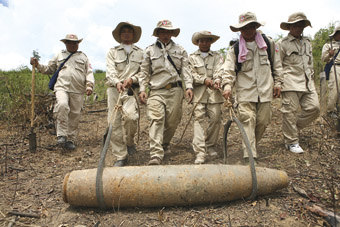
Bomb Harvest, Kim Mordaunt
RECENT INDUSTRY BUZZ ABOUT A RE-JIGGED, REJUVENATED SFF HAS CENTERED AROUND THE APPOINTMENT OF A YOUTHFUL NEW FESTIVAL DIRECTOR, CLARE STEWART. A SENSE OF ANTICIPATION WAS APPARENT AT THE CROWDED CIRCULAR QUAY LAUNCH. TELSTRA WAS WELCOMED AS A MAJOR NEW SPONSOR, AND WILL CO-HOST AN ONLINE COMPETITION FOR ONE-MINUTE MOBILE-SHOT FILMS. A NEW VENUE WAS ALSO FLAGGED, THE METRO THEATRE ON GEORGE STREET, WHERE MUSIC FILMS WILL SCREEN IN A ‘COCKTAIL-BAR’ ATMOSPHERE (AS WELL AS FEATURING POST-SCREENING PERFORMANCES). FINALLY STEWART TALKED US THROUGH CLIPS FROM THIS YEAR’S KEY FILMS AND PROGRAM STRANDS.
In light of her appointment and subsequent first program, Stewart’s career path is of interest. Based in Melbourne, she has had a 15-year programming career, the culmination of which was the last four years as head of film programs for ACMI. Previously a programmer for the Melbourne and National cinematheques, she worked for five years at the the Australian Film Institute. I talked to her by phone about the programming philosophy she brought to her first Sydney festival.
There is always debate around film festivals in regards to programming. Do you think SFF ought to have a kind of ‘contract’ with audiences that the event is bringing into their orbit ‘cutting-edge’ world cinema?
If you mean ‘should the festival be challenging?’, I would say yes. I think that’s one of its roles. My approach to programming is that the ideal audience is composed of a number of clusters. Not everybody is interested in being ‘challenged.’ But that is absolutely, on a curatorial level, one of the things the festival must do—and I’m very excited about our Provocateurs strand this year, which is quite deliberately putting up films that agitate, films that provoke, that are really on that cutting edge of stylistic, formal or content provocation.
I have to say, though, that I believe in cinema for everyone. We’ve just introduced this year for the first time a program for kids. [This is all part of] widening out the festival… Personally, my tastes are very, very broad. I’m particularly excited about reviving The 5,000 Fingers of Dr. T (Roy Rowland, USA), the only film that Dr. Seuss substantially contributed to. We also have a program charting 20 years of Pixar shorts. For me, programming is about producing these kinds of clusters; it’s not about saying an overall program should be one thing or the other.
Do you think there’s any tension between an obligation to challenge viewers in regards to the formal and conceptual extremes of contemporary cinema (and retrospectives), and economic pressure to appeal to an ever-larger audience by programming ‘accessible’ films. How can a festival deal with this gap? I’m thinking both of programming per se but also marketing and public articulation of the festival’s tone or character.
I’d say it’s a tension not as in a restraint [but] as in an exciting ‘frisson’ [Laughter]…It’s my responsibility to communicate effectively to all possible patrons that this is a festival for everyone, which is not the same as saying everything in it is going to appeal to everyone. That’s an important balance to strike. For the cinephiles, and I would very much class myself as being one, I also don’t like to presume they’re not interested in more popular forms of cinema. I guess I just don’t see it as an either/or situation; I see it as a complex set of options.
For film-goers who seek out challenging work that’s not likely to appear on TV or DVD anytime soon, what are some of notable titles in the program?
Sure. The Provocateur strand is really quite full of that. For example, Build a Ship, Sail to Sadness (Laurin Federlein, UK), I’m sure this is not turning up in a DVD near anyone anytime soon! It is a completely bizarre, hilarious film [about] an incredibly strange man who is driving on a kind of motorised cycle around the hills of Scotland with the desire to set up a mobile disco, to “take away the loneliness of the citizens” who, of course, are completely uninterested. He ends up sniffing the petrol in his vehicle and having hallucinatory moments. Featuring a kind of clapped-out video aesthetic with roots in performance video art, it’s a film that’s come out of nowhere with a minimal budget. Then we also have the Australian premier of Inland Empire, the newest David Lynch film. This really is ‘Lynch at his most Lynchian.’ He has always been a provocateur extraordinaire, and the film totally anchors a program like this.
There is perennial talk around film festivals of ‘new waves’ from various parts of the world. Could you comment on where you think the centre of gravity is right now in regards to important feature filmmaking?
One of the most evocative and powerful strands in the festival is the Turkish Poets program—a cluster of recent award-winning Turkish films that share a very poetic sensibility…[often portraying] a melancholic state where the civilian population of Turkey is somehow suspended in the nether space between the loss of the Ottoman Empire and the contradictions of the rapid introduction of western capitalism, and how all of that fits with a predominantly Islamic society. It’s a really rich field of paradoxes…Takva—A Man’s Fear of God [Özer Kiziltan], for example, is an incredibly powerful film about a man who starts working for the local seminary in an administrative role. He’s suddenly brought out of his life of faith, paradoxically [now in] a more commercial environment because he’s representing the business of the seminary. And this absolutely challenges his faith in God. Times and Winds [Reha Erdem] is a visually stunning, lyrical portrayal of village life, which has visual echoes of Parajanov or Tarkovsky, but also a visual and temporal language all of its own. [There’s also] the Stories from Brazil program, a more textured and varied strand. For example, São Paolo City Tellars (Francesco Jodice) looks at the different tactics of survival in a city of 18 million people showing the helicopter-taxis that fly rich people over the dangerous streets below, then the extensive recycling that is a way of life for many.
I’m looking forward to both those programs. I’m also delighted to see you’ve got the complete 2006 Vienna New Crowned Hope festival’s ‘Mozart’ package of films commissioned by Peter Sellars.
Of course—I haven’t even touched on that! To me, that is the most exciting commissioning project of the year. It’s so adventurous, obviously featuring some of the most interesting filmmakers working in cinema at the moment—people such as Tsai Ming-liang, who will be familiar to many RealTime readers I’m sure.
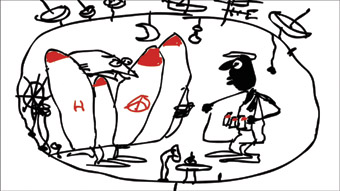
Global Haywire, Bruce Petty
There seems to be an increased presence both of Australian cinema and I think documentaries in the festival this year. This presumably reflects your positive view of these sectors at the moment?
It’s been a very strong year, particularly for Australian feature-length documentaries, which I think is really exciting, and we’re premiering a number of those. We’ve got films like Tim Slade’s 4, the new Tom Zubrycki film, Temple of Dreams, and Bomb Harvest by Kim Mordaunt. These are films that go the extra mile in terms of length and depth, as well as sometimes being more unconventional in style, [such as] Bruce Petty’s Global Haywire—a very different investigation into contemporary global politics, which is a feature-length combination of animation and performance. There’s Home Song Stories [Tony Ayres], Lucky Miles [Michael James Rowland] and West [Daniel Krige], which will be breakout feature films.
But we’ve also got some interesting independent films made on very low budgets, like Corroboree, by Ben Hackworth, which is a totally daring production, very different for an Australian feature film. It’s a tribute to Richard Wherrett, but he’s the starting point for a film which really undertakes a formal experimentation that demonstrates the energy and inventiveness of the early works of Guy Maddin and Lars von Trier…It’s so exciting to see those kinds of forms coming into play in an Australian feature.
Sydney Film Festival, June 8-24,
www.sydneyfilmfestival.org
RealTime issue #79 June-July 2007 pg. 19
© Hamish Ford; for permission to reproduce apply to realtime@realtimearts.net
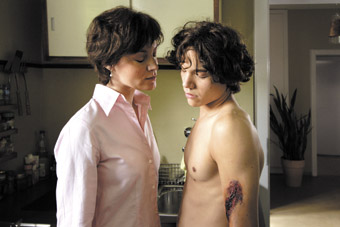
PingPong
THIS YEAR’S GOETHE-INSITUT FESTIVAL OF GERMAN FILMS EXEMPLIFIES IN A VARIETY OF WAYS THE QUALITIES OF POST-REUNIFICATION GERMAN CINEMA, WHICH HAS SEEN SUBSTANTIAL CRITICAL AND AUDIENCE SUCCESS OVER THE LAST DECADE OR SO, AND INCREASINGLY OCCUPIES A POSITION AT THE HEART OF THE EUROPEAN FILM INDUSTRY.
This German film renaissance is notably different from its predecessor, the ‘new [West] German cinema’ that from the late 1960s through to the early 80s produced significant and challenging feature films that were (with a few exceptions) rarely commercially successful, due in large part to their radical formal innovation, politically-imbued content and often rather bleak philosophical tone. This dichotomy marks the publicity and discourse around recent films (festival and Goethe-Institut director Klaus Krischok is one of many to note that they defy stereotypes about German cinema being unrelentingly ‘heavy’) and was largely played out in the 10 films I saw at the 2007 festival in Sydney. They were, by and large, straight and transparently told narrative and/or character based dramas or comedies—all very well made and often exemplary examples of their form, but lacking in aesthetic play or experimentation.
That the films are rather conservative in narrative adherence and style doesn’t mean they are fast-moving, compared to contemporary US cinema at least; instead they are ‘classical’ in adhering to the more accessible end of the European art-house tradition. For example, Pingpong (director Matthias Luthardt) and Summer 04 (Stefan Krohmer) are ‘chamber films’ which, language and minor details aside, in tone and theme could easily have been French films—the hidden problems of a bourgeois family on summer holiday exposed by the intervention of a sexually precocious teenager. The films are enjoyable, thanks to sustained tension and engaging performances (strong naturalistic acting talent seems a major strength of contemporary German-language cinema), but the potential thematic impact of both films is unfortunately reduced by rather too neat endings. These familiar riffs on the dark side of the bourgeois family are nonetheless enjoyable viewing experiences: European cinema (with the German industry perhaps increasingly at its centre) doggedly sustains a different ‘first-world’ vision of contemporary mainstream moral experience, behaviour and thought from that which more commonly dominates our TV and movie screens. (For one thing, films featuring sexually active young teenagers liasing on an equal footing with very ‘liberal’ adults over twice their age are only ever seen on the other side of the Atlantic through a mist of fevered moral panic.)
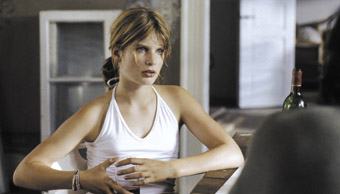
Summer 04
Another very European-styled and thematised film, though this time much more urban in its setting and concerns, was Valerie (Birgit Möller). Popular with critics and audiences, this story of a Paris-based Polish model who finds herself in a cash flow crisis one Christmas in Berlin (such that she has to sleep in her car) showed all the signs of its background as a diploma film stretched to feature length. There was lots of potentially interesting but relatively underdeveloped material here about the messy East-West coming together of contemporary Europe’s grand economic and cultural project. In one notable scene the consequent inequalities are played out when the protagonist, asked to translate the Polish of a German friend’s maid, is suddenly allied with Berlin’s servant class.
The problems of a slowly integrating Europe were much more overtly essayed in Offset (Didi Danquart), set entirely in Romania. The primary German character represents the charming and benign (though also rather bland) heart of the EU. When the family arrives for his marriage to a young Romanian woman, his mother immediately exhibits appallingly chauvinistic, old German patronising distain for the crumbling socialist grandeur of Bucharest and Germany’s post-communist EU brethren. For the most part a comedy-drama, the film delivers a dark jolt both in its narrative dénouement and the seemingly inevitable gravitational pull of the new (Western-authored) Europe, when the beautiful young Romanian woman decides to stay in Bucharest with her sometime lover and boss (a fierce nationalist who brandishes a gun while shouting anti-German and EU rhetoric) rather than ‘escape’ with the more youthful and modern German figure.
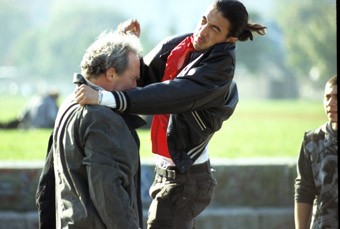
WUT
The panel kicking off the festival, which featured both local and festival guests, was devoted to the elusive, historically and politically problematic German notion of ‘heimat’ (very loosely, ‘homeland’)—an issue that can certainly be read into many of the films in a variety of ways. While Züli Aladag’s Can—His World Has Its Own Rules (the original title, Wut, translated as Rage or Fury, seems more appropriate) betrays its TV origins through rather one-note performances and a schematic script, it is initially effective in seeking to expose political, historical and ethical fissures within left-liberal bourgeois German culture via the tale of a second generation Turkish teenager who relentlessly harasses another outwardly model middle-class family. Sadly, the last half hour becomes very reductive and generic with its neat conclusion to this airing of raw nerves when the father of the family has his presumably ‘repressed’ racism violently outed. More historically concerned and less subtle from the start was Dresden—The Inferno (Roland Suso Richter). Although effective in charting the ultimately inescapable collusion of the German middle class with the Nazis, this very old fashioned Hollywood-style film seriously reduces the challenging moral and political questions concerning the atrocity of the Dresden bombing in 1945 to a romantic melodrama centred around a politically naïve nurse and an injured British fighter pilot.
A film that sought to bring contemporary and Nazi-era Germany together was the very popular Four Minutes (Chris Kraus). It centred around the difficult relationship between an octogenarian piano teacher still haunted by her youthful betrayal to the Gestapo of her female communist lover, and an extremely violent young female prison inmate who possesses remarkable musical ability. The tension and growing tenderness between the hard-nosed pedagogue and her recalcitrant, animalistic charge coming together through their different mental scarring is a familiar trope in middlebrow drama, as are meditations on the redemptive power of ‘timeless’ art. Yet beyond its inevitable narrative arc, the film’s interest perhaps lies in a particularly Germanic extolling of classical music as both a viable stand-in for religion, vis-à-vis offering an apparent ‘truth’ beyond social reality, yet at the same time as a rather nihilistic force through its supposed disinterest in the earthly domain of moral concerns (hence a convicted killer can be a great artist). Here Schumann is the appropriate touchstone for a film about mental degradation, though through its much-practised performance—whereby the two women find a troubled communion—his music is shown as ultimately rather more socially affective than the old teacher claims. Importantly, this outwardly ascetic custodian of tradition is far from a pillar of virtue, and cannot be allowed a conservative victory. Hence during the young woman’s triumphant public performance at the finals of a piano competition, she quickly shifts from Schumann, through fragmented gospel (which her teacher had earlier decried as ‘Negro noise’), to exaggeratedly violent post-Schoenberg atonal attacks on the piano’s keys, strings and body.
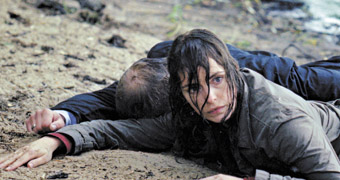
Yella
The one film I saw that did attempt some aesthetic experimentation was Yella (Christian Petzold). An elusive piece, both realistic and yet simultaneously oneiric, it tells the story of a melancholic economist from the former East whose business and marriage have ended disastrously, whereupon she attempts to start anew in Hanover—which makes for a very sterile vision of the former West as defined by soulless hotels, conference rooms and company cars. But her experience and vision of the economically and morally vertiginous side of post-reunification Germany is coloured by the recurrence of strange sounds and images vaguely connected to home (including odd shots of her husband, who seems to be stalking her). Though these confusing visions are partially explained by a linearity-destroying final scene that suggests most of the film may have been a post-death ‘alternate reality’ of some sort (or, as someone suggested to me, a Faustian bargain scenario whereby our protagonist gets another chance but must witness and partake of the most demonic elements of her capitalist culture), the entire film is highly evocative as a quiet yet disquieting meditation on contemporary Germany seen from the ‘other side’ in both the geopolitical and metaphysical sense.
Festival of German Films, Goethe-Institut, Sydney, April 19-29, Melbourne, Brisbane and Perth
RealTime issue #79 June-July 2007 pg. 20
© Hamish Ford; for permission to reproduce apply to realtime@realtimearts.net
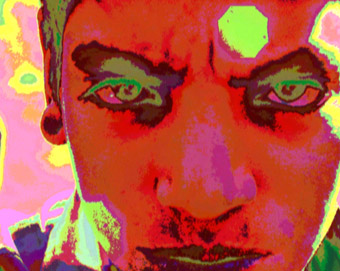
Black Sun
THE EXPERIENCE OF BLINDNESS MIGHT SEEM A CURIOUS SUBJECT FOR A FILM, SINCE PART OF OUR ENDURING FASCINATION WITH CINEMA IS SURELY THE MEDIUM’S ABILITY TO RENDER THE VISIBLE APPEARANCE OF THINGS. BUT FILM IS ALSO A SENSORIAL MEDIUM OF WORDS, PICTURES, SOUNDS AND LIGHT, MAKING IT THE PERFECT VEHICLE FOR A REFLECTION ON THE SUBJECTIVE NATURE OF SIGHT. ESPECIALLY GIVEN THE STARTLING ASSERTION IN GARY TARN’S BLACK SUN THAT THE PICTURE OF THE WORLD FORMED BY OUR EYES IS A CREATION, AS SUBJECTIVE AS A PURELY HALLUCINATORY VISION.
Black Sun tells the story of Hugues de Montalembert, a French-born painter and filmmaker who was the victim of a random attack in his New York apartment in 1978. During a struggle with two assailants, de Montalembert had paint stripper thrown into his face and, over the course of a night, lost the use of his eyes forever. For an artist whose entire life was based around vision, de Montalembert dealt with his new condition with remarkable strength and determination. After a year of rehabilitation, he set off alone for Bali where he wrote a book entitled Eclipse, which went on to become a best-seller in his native France. Since then he has travelled extensively, published a second book, and at the time of Black Sun’s making was working on a third.
Tarn allows de Montalembert to tell his own story in voiceover, while a stream of associative images plays out on screen. The style is clearly influenced by Chris Marker [see page 27], particularly his 1982 film Sans Soleil (Sunless). Like Marker, Tarn creates a dream-like visual experience, sometimes manipulating the picture through special effects, at other points presenting undoctored images of tantalising mystery. Words and images dance in an open-ended exchange, both complementing each other and working in counterpoint. As the film progresses, de Montalembert’s voiceover moves from a fairly straightforward account of the attack and his struggle to deal with the loss of his sight, to a more philosophical reflection on what it actually means to see.
For some time after going blind, de Montalembert’s brain continued to generate images of such clarity that he would wake up each morning convinced his vision had returned. Then, after a few hours, his brain would tire and the images would suddenly be shut off, plunging him into darkness. Similarly, a friend once asked de Montalembert whether he had an image of him in his mind. “Of course”, replied de Montalembert, “I knew you before I went blind.” He is shocked when his friend points out his mistake. He has never seen this friend’s face, yet the image he holds of him is so strong de Montalembert was initially convinced they had met before the attack. Over time, these experiences have led de Montalembert to conclude that “vision is a creation, not a perception.” Through conversations with sighted people, he has also come to realise most of us do not in fact see the world around us, in terms of engaging with what our eyes reveal. For many, sight is merely a means by which to avoid collisions with objects and other people.
Black Sun is a fascinating reflection on a sense so integral to our everyday experience that most of us take it completely for granted. De Montalembert’s insights are at once inspiring, provocative and disturbing, while his world view is informed by a profound compassion. The loss of his eyes ultimately seems to have opened a whole new dimension in his experience and understanding. Gary Tarn’s achievement is that through Black Sun we share something of de Montalembert’s unique vision.
Black Sun, director and producer Gary Tarn, writer and narrator Hugues de Montalembert, 2005, DVD released by Aztec International, www.aztecinternational.com.au
Aztec International has made available five DVD copies of Black Sun for RealTime readers. See page 48 for our giveways.
RealTime issue #79 June-July 2007 pg. 22
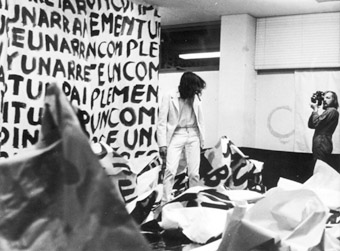
Mike Leggett filming Ian Breakwell in Unword
courtesy Mike Leggett
Mike Leggett filming Ian Breakwell in Unword
ONE OF SEVERAL PLEASURES TO BE HAD AT THE SCREENING OF FILMS BY MIKE LEGGETT AT ACP WAS THE SHOWING OF AN EARLY WORK FROM HIS UNWORD SERIES. THESE FILM ENGAGEMENTS WITH PERFORMANCE WORKS SERVE AS ARCHIVAL DOCUMENTS AND CREATIVE ACTS IN THEIR OWN RIGHT.
In 1969-70 in London, Bristol and Swansea, Leggett filmed Ian Breakwell in performance as the artist moved amidst huge swathes of inscribed material. The black and white shots with their photographic image intensity, staccato editing and sharply shifting perspectives against an instructional voiceover (language lessons and eyesight tests) create a curious visual rhythm but leave an incredibly strong mental imprint of the performance. Leggett filmed each performance, projected the footage as part of the subsequent one, and filmed that one in turn.
Leggett explains in his catalogue that the rhythm of the screening was not the result of editing: “The projection of the footage was on a Spectro stop frame analysis projector (a scientific examination tool) running at two frames per second.” In 2003 he and Breakwell “digitally reconstructed the Unword film at 2 frames per second, with a married soundtrack of the compilation tape.” Leggett’s Unword series covers the years 1969-2003. He tells me he has put them on DVD for study or reference.
The other highlight of the night was Shepherd’s Bush (1971, 16mm, 15 mins), a remarkable film which begins in black (has the lamp blown?, you think), the soundtrack pulses mechanically, the black lightens to grey to slowly reveal barely discernable movement across rough ground, brightening to a glaring white, erasing the image, the beat intensifying. It’s a truly invasive, curiously beautiful sonic experience and a spooky exercise in visual denial but one nonetheless conveying a frantic sense of momentum. The process has been described as simple (“a forward tracking movement was printed at every available grade in the printer’s grey scale”, John Du Cane, Catalog of British Avant Garde Art, London, 1971), but the effect is profound.
The creative representation of performance on film or video can be interpretatively problematic but in Unword, in Wade Marynowsky’s Autonomous Improvisations v1 (page 24) and in some, if not all, of the Castelluci films (Tragedia Endogonidia: video memory by Cristiano Carloni & Stefano Franceschetti) screened in Sydney and Melbourne in 2006 (RT74, p37), documentation is transcended and the spirit of the work retained and furthered.
A Program of Films by Mike Leggett, hosted by Louise Curham, Lucas Ihlein, Teaching and Learning Cinema, Australian Centre for Photography, April 28.
Mike Leggett’s Shepherd’s Bush appears on the Shoot Shoot Shoot DVD Vol 1, British Avant Garde Film 1966-76, featuring films from the London Filmmakers’ Cooperative available through OtherFilm Bazaar, www.otherfilm.org. The late Ian Breakwell’s own films have recently been released on the BFI British Artists’ Films DVD series.
RealTime issue #79 June-July 2007 pg. 22
© Keith Gallasch; for permission to reproduce apply to realtime@realtimearts.net
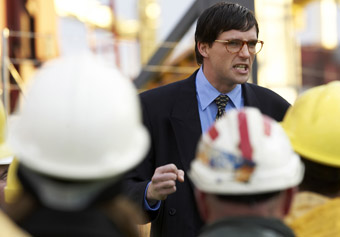
Daniel Frederiksen, Bastard Boys
BASTARD BOYS, THE ABC’S DRAMATISATION OF THE 1998 DISPUTE BETWEEN THE MARITIME UNION OF AUSTRALIA AND PATRICK STEVEDORES, INCLUDES A SCENE IN WHICH ACTU SECRETARY BILL KELTY, PLAYED BY FRANCIS GREENSLADE, ANOINTS GREG COMBET, PLAYED BY DANIEL FREDERIKSEN, AS HIS SUCCESSOR. LEAVING KELTY’S OFFICE, COMBET REMOVES HIS GLASSES AND FOR A MOMENT, WITH HIS SENSIBLE SIDE PART, RESEMBLES CLARK KENT IN SEARCH OF A PHONE BOOTH. THE TRANSFORMATION, THOUGH, IS NEVER REALISED. IN THE NEXT SCENE, COMBET IS PRETTY MUCH THE SAME MAN AS BEFORE.
In many ways, this transformation-that-isn’t is an apt metaphor for Bastard Boys: while it looks great, has an excellent cast and a compelling story, it never really flies. Rather, it remains grounded in a no-man’s land, trying to portray the complexities of recent political history on a tiny canvas: not quite drama, not quite documentary, it never manages to free itself sufficiently from the events of 1998 to offer a deeper reflection on the implications of those tumultuous events on the country.
These limits are strikingly apparent in the script, which often seems contrived to the point of silliness. In one scene, for example, Combet comes to convince a group of unionists to end a sit-in in response to the presence of scab labour on the docks. As he enters the room where the group of unionists has bunkered down, one of their number announces his arrival, adding “The ACTU. You ever heard of them? The affiliation of trade unions formed to devise policy and lobby on behalf of the labour movement.”
The producers might as well have plastered a caption on the screen to explain the ACTU and its role on the political landscape.
It’s not only the protagonists who get brushed with the bleeding obvious. Bastard Boys is infested with that blight of political drama: the set speech. Combet, for example, explains to union lawyer Josh Bornstein that “The law is an artificial construct erected by the capitalist class to ensure the system protects their own interests and maximises their own profit.” Later on, MUA National Secretary John Coombes, played by Colin Friels, explains the importance of solidarity to Combet thus: “I don’t break my promises, now that’s what solidarity’s about”.
While some of these exchanges are delivered with irony, they end up looking like clunky plot points and character sketches for those unfamiliar with the personalities and events around the waterfront dispute. Signposts of this kind are necessary to expand Bastard Boys’ appeal to more than political junkies, but they warranted a more sophisticated approach, not a high school social studies lesson.
These are symptoms of the larger problem of Bastard Boys, namely that in limiting itself to the particular personalities and events of the waterfront dispute, it remains a prisoner to the times and events it depicts.
In this regard, Bastard Boys might have been strengthened by displacing the point of view from the main protagonists in the dispute to minor players—the experiences of a scab labourer and a unionist, for example, would, potentially, have made for a more politically and artistically nuanced story. Alternatively the main characters and events could have been displaced to a different context altogether. A lesson here is The West Wing, which, rather than directly re-creating the Clinton Administration (which is its obvious template) displaces the action into fictional, yet recognisable characters and events.
While comparisons with The West Wing might be regarded as grossly unfair given obvious differences in resources, this isn’t an argument about production values or costs. The point rather is one of approach. A more visceral treatment, freed from particular characters and events might have given the makers of Bastard Boys greater creative freedom in expressing truths about those events which a more straightforward re-telling of events does not permit.
The political, cultural and artistic limits of the docu-drama format have been highlighted by the responses of the main protagonists that followed the airing of Bastard Boys.
Bill Kelty went on Late Night Live to complain that the show’s makers never approached him to ask about his role in the dispute. Chris Corrigan, meanwhile took to the opinion pages of The Australian to denounce what he saw as the portrayal of himself as an “evil, uncaring and insensitive boss” and to point to errors of fact around conspiracy claims.
The predictable nature of these responses suggests that rather than opening a space for a more searching discussion of the events of 1998 and their relevance to contemporary Australia, Bastard Boys seemed stuck in 1998. In an election year where industrial relations are set to take centrestage, Bastard Boys was an opportunity lost.
Bastard Boys, writer Sue Smith, director Ray Quint, performers Geoff Morrell, Daniel Frederiksen, Dan Wyllie, Anthony Hayes, Justine Clarke, Rhys Muldoon, Lucy Bell, Justin Smith, Caroline Craig, Helen Thomson, producers Brett Popplewell, Ray Quint; ABC TV & Flying Cabbage Productions; May 13, 14
RealTime issue #79 June-July 2007 pg. 23
© Christopher Scanlon; for permission to reproduce apply to realtime@realtimearts.net
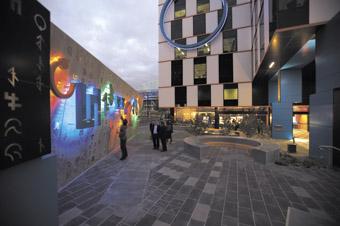
Field of Play, Digital Harbour
THE DOCKLAND DIGITAL HARBOUR AREA IS A DOUBLY VIRTUAL REALITY. COMPRISING THREE MAIN BUILDINGS (PORT 1010, INNOVATION, LIFE.LAB), BUT STILL TAKING SHAPE, EACH is MEANT TO EMBODY THE POSSIBILITIES OF AN INTERCONNECTED TECHNOLOGY AND RESEARCH CENTRE WHOSE PARAMETERS AND STYLE ARE YET TO BE REALISED. THE DOCKLANDS THEMSELVES ARE A VIRTUAL REALITY, MELBURNIANS STILL ATTEMPTING TO CONNECT A NEW URBAN SPACE WITH THE PRE-EXISTING CONCEPTUAL MAP OF A CITY GROWING LIKE IVY—IF IN A WEB OF STRAIGHT LINES. IN EVERY SENSE, THE ARCHITECTURE AND STREETSCAPES OF THE DOCKLANDS AREA ARE CONTESTED, VIRTUAL, UNREAL.
It is in this uncertain, unstable zone that Troy Innocent’s new work, Field of Play, toys with the abstractions of place and shape that form all of our sensations of location. In the shadow of these buildings, Innocent’s signs and colours of indeterminate origin coalesce and dance. Sets of paving stones are lit from beneath with colours and shapes, while a nearby wall acts as a neon Rosetta Stone, runes and letters from alien languages glowing in the dark. It takes only a moment to realise that a game is on offer.
Twin versions of the game, loosely collected around the concepts of ‘here’ and ‘there’, allow players to participate through the related website—or a powerful phone—controlling the lighted paving stones between the three buildings. The game uses the rules of Janken (rock-paper-scissors) to let players score points on a playing field of several either/or segments. Three players choose colours and hedge bets against the odds of being superseded by the colour above them in the cycle: green beats blue, blue beats orange, orange beats green. The game is playable on two planes of virtuality: online through the work’s website and secondly through the lights and paver stones of Digital Harbour, if you’re connected by a sufficiently powerful mobile phone. The second iteration adds an element of naturalism to the play, like digital divining rods bending with the promise of water as the lights below shift and rearrange in response to the twitches of your thumb.
Innocent’s conceptualisation of the game’s materiality is perhaps the most striking element. What seems to be Digital Harbour’s curious relationship to its own history as a docking port is suddenly illuminated as a zone of translation, transition and transaction. The three coloured lingua (orange, blue, green) of Field of Play are tied in Innocent’s formulation to electronic networks, digital games and tribal cultures respectively—avatar forms of the three surroundingbuildings. His previous works have also borne out this fascination with the properties of digital language, coalescing figures around the molecular drifts and eddys of the ether which we have become so accustomed to navigating.
Yet Field of Play takes on properties of this incorporeal dialogic previously undetected and uncelebrated with a ritualised and sacral tone. What was clearly envisaged as an enlivening of an open space instead broaches the implicit coda like a taboo. We are invited to embrace and then to play with the very artificiality of Digital Harbour. For a work so devout in its hermetic appreciation of the digital, players find their appreciation most satisfied by the soft warmth of the speakers and the heat of the luminescent pavers; concrete and glass also being kinds of virtual, remodulated earth. The sensory quality of the art, primary colours and heavy stone at your disposal through microgestures of the thumb and finger, enhances this ritual world.
Everything about Field of Play suggests a design that works during daylight but is more closely incorporated into the night lighting systems of the area. After several visits, the sensation of play transforms, especially during the traditional harbour activity hours of dusk and dawn, as the slate grey of the building is negated when bathed in colour.
Innocent’s digital explorations reveal a fascination with interfaces natural and technological, with the game as a carnival space confusing the two. Here, our playing is not a by-product of labour, or something we earn, deserve or waste. Instead, play is the inhabitation of an experience with a meaning beyond the messy materiality of the game’s duration. The ritual of the game lets even concrete pavers have a life of their own.
Melbourne Docklands Urban Art Program; Troy Innocent, Field of Play (2007), painted aluminium, custom luminaires, lasercut steel, shotblast pavers, multi-player digital game, computer-controlled light, four-channel sound; Harbour Lane, Digital Harbour, Melbourne Docklands, http://fieldofplay.net/
RealTime issue #79 June-July 2007 pg. 24
© Christian McCrae; for permission to reproduce apply to realtime@realtimearts.net
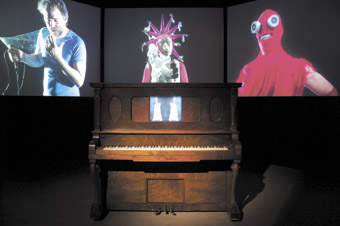
Wade Marynowsky, Autonomous, Improvisations v.1, L-R Lucas Abela, Toydeath, Matthew Stegh
photo Wade Marynowsky
Wade Marynowsky, Autonomous, Improvisations v.1, L-R Lucas Abela, Toydeath, Matthew Stegh
THERE’S SOMETHING STRANGE GOING ON IN THE BACK ROOM AT ARTSPACE, LOUD BURSTS OF CUT-UP NOISE AND WHAT SOUNDS LIKE THE FRENZIED EFFORTS OF AN ‘IMPROV’ PIANIST ARE COMING FROM BEHIND THE HEAVY BLACK CURTAIN COVERING THE entrance. INSIDE BY THE FAINT GLOW OF DIGITAL CANDLELIGHT AN OLD-WORLD PIANOLA PLAYS AND A BIZARRE PROCESSION OF PERFORMERS, MANY OF WHOM WOULDN’T BE OUT OF PLACE IN A CARNIVAL SIDESHOW APPEAR AND DISAPPEAR, PROJECTED ON THREE SCREENS.
Welcome to Wade Marynowsky’s Autonomous Improvisation v.1, an automated and prepared pianola that triggers an audio-visual mix of Sydney’s more infamous live performers, creating what the artist describes as “a mash-up of the ‘improv’ scene (the NOW now festival), the burlesque scene (man jamm), extreme metal-ists, techno-heads, toy-heads and the classical avant-garde…”
Roll up, roll up… for the fabulous transgender hula-hooper and the man who makes music using his mouth and a piece of broken glass…
If you live in Sydney you will probably recognise many of the artists who appear in this work and, as you might expect, there are lots of weird and wonderful looking people to behold. One hairy young man looks very much like he has just received a powerful electric shock and is covered from head to toe in red body paint. There’s a DJ in a polka-dot clown suit, a rapper in a gold gimp mask and matching lamé dress, and a man wearing little more than a few strategically placed plastic googly eyes stuck to his face, backside and crotch.
While the glamorous and glittery ones certainly stand out, many of the people on screen are more ‘regular’ looking music folk, some sitting earnestly behind their laptops, others twiddling knobs, swaying to theremins, mouthing into mikes and playing a range of musical instruments.
Marynowsky has assembled a diverse group of 37 performers creating a continuously surprising display of unusual collaborations and sonic arrangements. The artist explains he was aiming to create a mechanism that could juxtapose all sorts of people, “many who have never performed together and probably never will.”
While from past experience I know many of these acts make staggeringly loud or incredibly soft noises when performing on their own, the over all sound mix is balanced so that one never seems to take precedence over another. This restrained equilibrium means that combinations such as noise-core, tap dancing and soft vocals or minimal electronica, death-metal and rap can play simultaneously while still allowing subtle nuances from each to flutter in and out of aural focus.
The different performance images are all composed in the same way, giving a continuity that has the effect of binding them all together into one ‘live’ show. Every performer is alone in shot, positioned towards the centre of frame and lit vibrantly against a black backdrop. Each is very much in their element, onstage and demanding the focus of our attention to such an extent that it is often difficult to know where to look.
Sound and image bites jolt and collide as the performances captured on video are cut up and re-mixed on the fly in conjunction with the notes of the pianola. This digital mash-up gives the conjoined performances a strange inhuman rhythm and makes you wonder who the performer actually is in this situation.
Marynowsky has removed all but the trace of the human from this performative equation. The recorded liveness of the different acts is randomly triggered by an array of networked computers behind the scenes, but does this make it a new improvisation? And if so, whose? Who triggers the invisible pianola player—is it the artist or the computer, the programmer or the code? A bit of each I suspect, creating a new hybrid entity, a kind of musical bastard child, a freaky crossbreed.
In a playful and entertaining way Marynowsky’s work questions the notion of live performance and more specifically improvisation. What does it mean to improvise? Can a computer improvise? What about a group of computers programmed by an artist?
The work is a well balanced combination of live content, computer-triggered effects and kinetic sculpture. A testament to its composition is that the technology used is quite complex, but an understanding or awareness of it is not necessary to enjoy the work.
Apart from being a stimulating artwork, Autonomous Improvisation v.1 is a fabulous archive of the Sydney underground performance scene at the current time. Like a kind of digital documentary-automaton it continuously alters its form and is able to create a potentially unlimited supply of audio-visual experiences.
Wade Marynowsky, Autonomous Improvisations v.1, contributing artists Adrian Bertram, The_Geek_From_Swampy_Creek, Lucas Abela, Robbie Avenaim, Peter Blamey, Monika Pazniewska, Dallas Dellaforce, Jim Denley, Peter Farrar, Robin Fox, Brian Fuata, Dale Gorfinkel, Singing Sadie, Rev. Kriss Hades, Kristina Harrison, Ian Pieterse, Marty Jay, Josh Shipton, Hirofumi Uchino, Somaya Langley, Trent Mardan, Charlie McMahon, Dave Noyze, Shannon O’Neil, Gail Priest, Rory Brown, Mark Selway, Milica Stefanovic, Matthew Stegh, Amanda Stewart, Pizzo (George Tillianakis), Clayton Thomas, The Toecutter, Toydeath,Trash Vaudeville, Jon Wah, Dave Slave; Artspace, Sydney, April 20-May 19
RealTime issue #79 June-July 2007 pg. 24
© Anna Davis; for permission to reproduce apply to realtime@realtimearts.net






























 Jonathan Dady, Cardboard Pianos, installation,
Jonathan Dady, Cardboard Pianos, installation,  Jonathan Dady, Cardboard Pianos, installation,
Jonathan Dady, Cardboard Pianos, installation, 





























